December 20, 2015 - January 9, 2016: Issue 245
Early Pittwater Paddlers, Oarsmen, Rowers and Scullers: The Williams
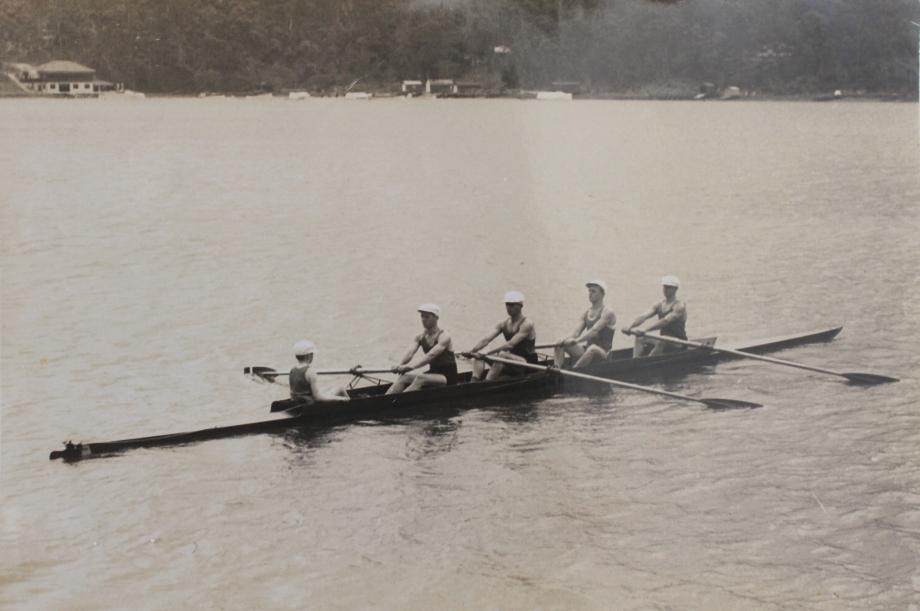
On the Pittwater - Second Royal Motor Yacht Clubhouse at Newport in background
Early Pittwater Paddlers, Oarsmen, Rowers and Scullers: The Williams Family of South Sea Islands, Mosman and Bayview
Pittwater, a glassy estuary, once often referred to as a 'lake' in early records, was clearly made for rowing prior to the advent of all those moorings which now make Pittwater the second most populated moorings place in Sydney. In 2016 we will be celebrating the 200 year anniversary of one of those Pittwater families who did much for many beginning their long journey to this place and present day.
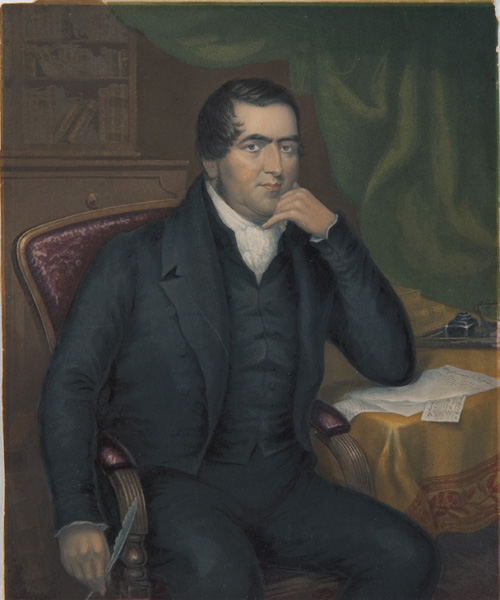 The Williams Family story begins with John Williams (1796–20 November 1839) an English missionary, active in the South Pacific. Born near London, England, he was trained as a foundry worker and mechanic. In September 1816, the London Missionary Society commissioned him as a missionary in a service held at Surrey Chapel, London.
The Williams Family story begins with John Williams (1796–20 November 1839) an English missionary, active in the South Pacific. Born near London, England, he was trained as a foundry worker and mechanic. In September 1816, the London Missionary Society commissioned him as a missionary in a service held at Surrey Chapel, London.
Right: The Rev. John Williams, the Martyr of Erromanga, with a landscape of the Mission House and grounds of Rarotonga. Designed, engraved and painted by G. Baxter, patentee of oil colour printing, Patriot Office, London. No 1 of the Missionary Portrait Gallery. n.d.
They sailed in November 1816 and were joined by Rev. Lancelot Threlkeld at Rio de Janeiro. They arrived at Hobart Town in March 1817 and held the first Evangelical service conducted in Van Diemen's Land, Williams defying opposition by preaching in the open air. In May the party arrived in Sydney.
In 1817, John Williams and his wife, Mary Chawner, voyaged to the Society Islands, a group of islands that included Tahiti, accompanied by William Ellis and his wife. John and Mary established their first missionary post on the island of Raiatea. From there, they visited a number of the Polynesian island chains, sometimes with Mr & Mrs Ellis and other London Missionary Society representatives. Landing on Aitutaki in 1821, they used Tahitian converts to carry their message to the Cook islanders. One island in this group, Rarotonga (said to have been discovered by the Williamses), rises out of the sea as jungle-covered mountains of orange soil ringed by coral reef and turquoise lagoon; Williams became fascinated by it.
Their eldest son, John Chawner Williams, was born 7th of January 1818 at Eimeo. John and Mary had ten children, but only three survived to adulthood. The Williamses became the first missionary family to visit Samoa.
The Williamses returned in 1834 to Britain, where John supervised the printing of his translation of the New Testament into the Rarotongan language. They brought back a native of Samoa, named Leota who came to live as a Christian in London. At the end of his days, Leota was buried in Abney Park Cemetery with a dignified headstone paid for by the London Missionary Society, recording his adventure from the South Seas island of his birth. Whilst back in London, John Williams published a "Narrative of Missionary Enterprises in the South Sea Islands", making a contribution to English understanding and popularity of the region, before returning to the Polynesian islands in 1837 on the ship Camden under the command of Captain Robert Clark Morgan.
Most of the Williamses' missionary work, and their delivery of a cultural message, was very successful and they became famed in Congregational circles. However, in November 1839, while visiting a part of the New Hebrides where John Williams was unknown, he and fellow missionary James Harris were killed and eaten by cannibals on the island of Erromango during an attempt to bring them the Gospel. A memorial stone was erected on the island of Rarotonga in 1839 and is still there. [1]
In December 2009 descendants of John and Mary Williams travelled to Erromango to accept the apologies of descendants of the cannibals in a ceremony of reconciliation. To mark the occasion, Dillons Bay was renamed Williams Bay. [1]
John Chawner (spelt Chauner in some records)Williams married his first wife, Caroline Nichols in 1838 in Linton, Cambridgeshire, England. John C Williams (7th January 1818- 9th November, 1874), was the first person to export coconut oil in large quantities and for a time was a produce merchant in Sydney before returning to Samoa where he was appointed British consul in 1858.
The ship, Samuel and Mary, belonged to John Chawner Williams, and he clearly travelled to and from the South Sea Islands in between or prior to being based in Sydney:
OSCILLATION OF THE OCEAN, OBSERVED AT APIA, UPOLU.
(From the Samoan Reporter.) ON Saturday, the 29th of September, 1849, about a quarter to nine A.M., the tide was noticed to be running out faster than it gene-rally does, and it continued falling till the reef and stones were all quite bare, leaving them about eighteen inches out of the water, which usually are just on a wash at low spring-tides ;and suddenly it rose up to half tide in about three minutes, making the fall and rise between four and five feet, when it again receded to lower than spring-tides ; after which, it flowed to its proper height, according to the then state of the tide. This occupied about three-quarters of an hour, when it fell and rose three successive times, but neither were so high or so low as the first and second time ; but the sixth was nearly as low as the second, which took place at 10 o'clock, and was over at 5 minutes past10 ; half-past 10, rose and fell again in five minutes; 20 minutes to 11, fell one foot, and rose to usual height at 15 minutes to 11 ; 10minutes to 11, fell one foot, and rose at 11o'clock; 15 minutes after 11, fell nine inches, and rose at 20 minutes past 11. The tide then commenced to flow gradually. About half-past 3 P.M., as I was riding home, the tide was apparently half out, and of a sudden it came rolling in, and overflowed the place where I was standing; at 15 minutes to 4, it receded again to nearly half tide ; and at 4 o'clock it rose up to high-water mark ; 10 minutes past4, ebbed again : then flowed at 15 minutes past 4 ; after which it gradually commenced to ebb, after falling suddenly about six inches. Cloudy day, and strong east winds ; and in the afternoon, squally weather. Thermometer, 84 in the shade, 90 in sun at half-past 10. Moon 12 days old.
J. C. W.
The above observations, made by our esteemed friend J. C. Williams, Esq., are worthy of being noticed, as very similar oscillations of the sea were observed over the whole of this groupe, in November, 1837, on the very day when fearful devastation was committed by an earthquake along a great part of the western coast of America, and when, at the same time,at the Sandwich Islands, the sea receded to a considerable distance, but very soon returned in one gigantic wave, upwards of twenty feet high, sweeping with irresistible force all before it. Showing that, though the seat of the com-motion may be very distant, the effects are nearly simultaneous as to time. P.S.-We have just heard of similar oscillations at Aneiteum, New Hebrides, on the same day and about the same time. OSCILLATION OF THE OCEAN, OBSERVED AT APIA, UPOLU. (1850, April 1). The Sydney Morning Herald (NSW : 1842 - 1954), p. 3. Retrieved fromhttp://nla.gov.au/nla.news-article12916821
FOR KIAMA. THE SEA SERPENT will sail for the above port on Monday, the 30th instant, Kyj«g^} nt 3 p.m. For freight or passage, apply to JOHN C. WILLIAMS, Erskine-street. Advertising. (1854, October 28). Empire (Sydney, NSW : 1850 - 1875), p. 1 Edition: [SECOND EDITION.]. Retrieved from http://nla.gov.au/nla.news-article60199330
NOTICE is hereby given that, by an indenture bearing date 19lth day of February, A.*D. 1855, and made between John Chawner Williams, of the city of Sydney, coal merchant, of we first part ; Thomas Wheaten Bowden, of the same place, auctioneer, and James Malcolm of the same place, marine surveyor, therein described as trustees for the purposes tnereln mentioned, of the second part ; and the several other persons parties thereto, creditors of the said John Chawner Williams, of the third part, and duly executed by the said John Chawner Williams and the said trustees in the presence of S D. Gordon,Esq, J P., of Sydney, a Justice of the Peace, the said John Chawner Williams did release, convey, and assign to the said trustees all his estates and effects whatever for the benefit of all his creditors. And notice is further given that the said indenture is now lying at the office of Messrs. Norton, Son, and Barker, No. 4,Elizabeth-street, Sydney, solicitors, for inspection and examination by the several creditors of the said John Chawner Williams. Dated this 19th day of February, A.D. 1855.
JOHN C. WILLIAMS.
T. W. BOWDEN.
JAMES MALCOLM.
Witness-Samuel D. Condon, J.P. Advertising. (1855, March 2). The Sydney Morning Herald(NSW : 1842 - 1954), p. 1. Retrieved from http://nla.gov.au/nla.news-article12966316
Some records state that John Chawner Williams was Consular for the United States prior to taking on his work for Britain - this may be why:
NUKULAU, Fi : A small sandy island in Rewa Roads, lying to the S. of Rewa. 4 miles to the westward of Nakui (on the mainland of Naviti Levu), and 14 miles SW. of Bau. It is well covered with wood. On the E. side there is an extensive coral reef, and it can be approached on the western side only. It is under the protection of the American flag, and belongs, to John B. Williams, Esq., the United States Consul (or rather Commercial Agent) for the Fijian group, having been absolutely sold to him some years since by Thakonauto, or Phillips, then principal chief or king of Rewa. The American consulate is established at a place named Lauthala, in the same bay as NukaLau, but nearer the mouth of the river Wailevu. There is a pool of freshwater on this island, but of an indifferent quality, and unfit for the supply of shipping. Nakulau lies in latitude 18-10' 23"S. longitude 178- 30' 30" E. Variation 8- 30'. CENTRAL POLYNESIA. (1857, July 15). The Sydney Morning Herald (NSW : 1842 - 1954), p. 3. Retrieved from http://nla.gov.au/nla.news-article28632349
SAMOA.
The following are the " Rules of Court" upon which justice is now administered at Apia, the chief port of the Samoan or Navigators' Archipelago. They are, in reality, as will be seen, a convention between the local chiefs and the foreign consuls, and as such are binding upon all parties. The adjudication of the Court thus established will consequently be legal and recognisable. A local tribunal of this nature has long been much needed. It is a great pity that its jurisdiction could not be extended over the whole group, but every at-tempt at organisation in that quarter meets with so much opposition that such an extension is at present impracticable. Except that the sixth section is much too vague, and that there seems no provision for the recovery of debts or other civil claims not entailing punishment upon the defendant, these rules are very good as a beginning. Time and experience will lead to improvements.
It is rather singular that the position of all the three consular offices who executed this convention has since been changed. The then Acting British Consul has been appointed to the British Consulate at Feejee. The then Acting Hawaiian Consul has been appointed to the British Consulate at Samoa, and the then Vice Consul for the United States has been appointed to the Hawaiian Consulate at Feejee.
RULES OF COURT.
1. Differences between foreigners and Samoans shall be examined Into, and decided according to justice and equity by the chief and the consul of the nation to which the foreigner may belong.
2. A foreigner or foreigners who may have cause of complaint against a Samoan or Samoans, shall apply to the consul of his or their nation, who shall demand an Investigation by the chief or chiefs.
3. A Samoan or Samoans who may have cause of complaint against a foreigner or foreigners, shall apply to his or their chief or chiefs, who shall demand an investigation by the consul or consuls.
4. A consul, by virtue of his office, has a right to sit in judgment with the chiefs, in all cases of dispute between foreigners and a Samoan, or foreigners and Samoans.
5. It is hereby agreed that any foreigners, whoso country is not represented In Samoa by a consul, shall have the privilege of claiming the protection of any resident consul, and for the time being shall, for all intents and purposes, be as one of the nations such Consul represents.
6. Punishments to be by fine, or otherwise, as the court may adjudge.
7. Court fees to be four dollars, payable to the chief or chiefs, in every case that shall be brought before the court.
8. Judgment shall carry court fees, and such compensation as the court. In Its discretion, may award.
9. Where a charge is not proven, the plaintiff shall pay the court fees.
10. The consuls and chiefs, respectively, shall be responsible for the amount of fines and costs of court ; that is to say, the consuls for foreigners, and the chiefs for Samoans.
11. Either party to a ault or charge can call for a Jury. The jury shall consist of six persons-three foreigners and three Samoans. If a jury cannot be found, the case shall be left to the court. -
We Scumanutafa and Toomalatal, the Chiefs of Apia and of Matautu respectively, sign our names to the foregoing articles, in witness that we and our successors shall execute and maintain the said articles within our respective and united territories ; that is to say. from Solapo on the cast, and to Sonl on the west.
(Signed) TOOUALATAI, Chief of the Matautu, for himself and
on behalf and with the content of his councillors.
(Signed) SKUMANUTAFA, Chief of Apia, for himself, and on
behalf and with the consent of his councillors. April 27th, 1857.
On behalf of our Governments we hereby accord our sanction to the foregoing articles, and shall respect and maintain the same
(Signed) WILL. T. PRITCHARD, Her Britannia Majesty's
Acting Consul.
Signed) RODT. S. SWANSTON, Vice-Consul, United States of America.
(Signed) JOHN C. WILLIAMS, His Hawaiian Majesty's Acting Consul. SAMOA. (1858, June 21). The Sydney Morning Herald(NSW : 1842 - 1954), p. 2. Retrieved from http://nla.gov.au/nla.news-article28630204
668/1850 V1850668 38A WILLIAMS JOHN C JOHN CAROLINE
50/1849 V184950 34A WILLIAMS ALFRED JOHN CAROLINE
667/1849 V1849667 38A WILLIAMS ELIZABETH JOHN CAROLINE
3657/1846 V18463657 31A WILLIAMS THOMAS W JOHN CAROLINE
391/1844 V1844391 28 WILLIAMS ELIZA JOHN CAROLINE
1934/1844 V18441934 31A WILLIAMS SARAH JOHN CAROLINE
393/1842 V1842393 26A WILLIAMS JOHN L JOHN CAROLINE
1933/1841 V18411933 31A WILLIAMS JOHN W JOHN CAROLINE
275/1840 V1840275 24A WILLIAMS MARGARET L JOHN CAROLINE
595/1852 V1852595 58 WILLIAMS SELINA A JOHN C CAROLINE
On the 8th instant, at 12 P.M. at her residence, Redfern, Caroline, the beloved wife of John C. Williams., aged 33. Family Notices. (1853, July 9). The Sydney Morning Herald(NSW : 1842 - 1954), p. 7. Retrieved from http://nla.gov.au/nla.news-article12947157
On the 20th July, at the Baptist Chapel, Bathurst-street, by the Rev. J. Voller, John C. Williams, Esq., son of the late Rev. John Williams, Missionary in the South Sea Islands, to Miss Amelia Crook, third daughter of the Rev. Enoch Crook, late of Battersea, near London. Family Notices. (1854, July 21). The Sydney Morning Herald(NSW : 1842 - 1954), p. 8. Retrieved from http://nla.gov.au/nla.news-article12956260
7104/1858 WILLIAMS AMELIA P JOHN AMELIA GOULBURN
13/1856 WILLIAMS ARTHUR H JOHN C AMELIA SYDNEY
WILLIAMS—October 29th, at Apia, Upolu, the wife of J. C. Williams, H.B.M. Consul, of a son. Family Notices. (1865, December 21). The Sydney Morning Herald (NSW : 1842 - 1954), p. 7. Retrieved from http://nla.gov.au/nla.news-article13123601
John C William and Caroline's 'John Williams' born in 1850 married and their first son, born 1866, was named John:
WILLIAMS—SUTTON—July 5th, at 136, Palmer-street, by the Rev. John Graham, John, eldest son of J. C. Williams, Esq.(H.B.M. Consul), of Apia, to Elizabeth Ann, only daughter of Alderman Sutton. Family Notices. (1865, July 21). The Sydney Morning Herald(NSW : 1842 - 1954), p. 8. Retrieved from http://nla.gov.au/nla.news-article13116435
M'FARLAND—WlLLIAMS—September 25th, at her Britannic Majesty's consulate, Apia, Upolo, Navigator Islands, by the father of the bride, Charles M'Farland, Esq., of Gortin, county Tyrone, Ireland, to Mary Elizabeth, eldest daughter of John C. Williams, Esq., H.B.M. Consul. Family Notices. (1861, November 21). The Sydney Morning Herald (NSW : 1842 - 1954), p. 10. Retrieved from http://nla.gov.au/nla.news-article13057298
THE S.S. ARCHER. Messrs. Henderson and McFarland's steamer Archer, which arrived on Saturday morning from the South Sea Islands, brought 468 tons copra, 1 ½ tons sharks fins, ½ ton pearl shell and sundries . Mr. John Williams, agent. SHIPPING ITEMS. (1898, August 15). Daily Commercial News and Shipping List (Sydney, NSW : 1891 - 1954), p. 5. Retrieved from http://nla.gov.au/nla.news-article157458741
Suffering from bad health J C Williams came to Sydney for treatment but succumbed:
WILLIAMS.—November 9, at 24, Cleveland-street, Redfern, John C. Williams, late H. B. M. Consul of the Navigators' Islands, aged 56 years. Family Notices. (1874, November 11). The Sydney Morning Herald (NSW : 1842 - 1954), p. 1. Retrieved fromhttp://nla.gov.au/nla.news-article30942762
Archer, s. For Ellice, Gilbert and Marshall Islands. Sailed 8th September, 1898. John Williams, agent. Goodlet and Smith, 7 pes H wood, 301 pos Oregon Henderson and Macfarlane, 480 bgs rice, J J Leslie, 9 tcs 7 brls beef Rev F Merg. 1 tcs beef, 1 ce meats, 5 ca fruit,70 bgs rice, 3 cs wino, 39 pes H wood, 41 sheets iron, 115 pkgs Justus Dcharlr, bl) cs meat, dU pkgs tobacco, olpkgs Holdsworth, Macpherson and Co, 30 os kerosene, 17 anchors, 30 tons zinc, 46 tins paint, 46 pkgs H Prescott and Co, 90 pkgs produce S Hoffnung and Co, 95 hf bxs soap, 5 cs brandy 11 pkgs Sundries, 26 pkgs Exports from Sydney. (1898, September 15). Daily Commercial News and Shipping List (Sydney, NSW : 1891 - 1954), p. 2. Retrieved from http://nla.gov.au/nla.news-article157452845
Emu, s.For Jaluit, via Bulli. Sailed 20 Sept, 1898.John Williams agent. Pacific Islands Co, 60 bgs rice H S Bird and Co, 22 cs meats, 7 cs spirits, 9pkgsJ Scharff . 6 ob tobacco, 2 pkgs H Prescott and Co, 20 cs potatoes, 32 pkgs Sterling Packing Co, 5 C3 beef Sundry Shippers, 93 pkgs Exports from Sydney. (1898, September 24). Daily Commercial News and Shipping List (Sydney, NSW : 1891 - 1954), p. 2. Retrieved from http://nla.gov.au/nla.news-article157453014
Maris Stella, sch, For Apia, Cleared 24th August 1899,John Williams, agent. Exports from Sydney. (1899, August 26). Daily Commercial News and Shipping List (Sydney, NSW : 1891 - 1954), p. 2. Retrieved from http://nla.gov.au/nla.news-article157594284
19 Macquarie Place SHIPS' ACCOUNTS. ALDEBARAN, bq ; in duplicate on or before THIS DAY, 11th inst. John Williams,19 Macquarie-place SHIPS' ACCOUNTS. (1899, October 11). Daily Commercial News and Shipping List (Sydney, NSW : 1891 - 1954), p. 4. Retrieved from http://nla.gov.au/nla.news-article157593850
Ships' Accounts. Rotuma, bgtne; in Triplicate by Noon on Wednesday, 17th inst. John Williams.: 19 Macquarie-place. Ships' Accounts. (1901, April 16). Daily Commercial News and Shipping List (Sydney, NSW : 1891 - 1954), p. 4. Retrieved from http://nla.gov.au/nla.news-article157835510
Macquarie Place: this historic site is situated on the north side of Bridge Street and was originally part of the first Government House. Governor Lachlan Macquarie intended it to be a significant public square but it was gradually whittled down over the years. It includes the obelisk designed by Francis Greenway and constructed in 1818; the bronze statue of Thomas Sutcliffe Mort erected in 1883; the cannon and anchor from HMS Sirius, the anchor having been placed on its pedestal in 1907; and the men's lavatory built in 1908, which features stucco and a glazed dome.
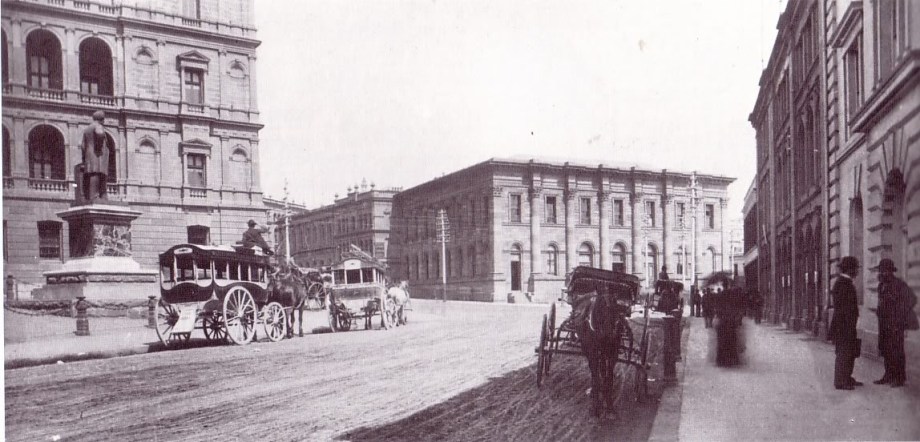
John, the son of John and Elizabeth Ann married:
WILLIAMS—LLOYD.—April 21, at Clifton, Burwood, by Rev. C. J. Prescott, John Williams, jun., of Strathfield, to Ethel Daisy, eldest daughter of W. F. Lloyd, of Burwood. Family Notices. (1897, May 8). The Sydney Morning Herald(NSW : 1842 - 1954), p. 1. Retrieved from http://nla.gov.au/nla.news-article14111230
John Jun. and Ethel Daisy had three children:
32460/1899 WILLIAMS KATHLEEN B JOHN ETHEL D MOSMAN
23301/1898 WILLIAMS JOHN Lloyd JOHN ETHEL D MOSMAN
969/1904 WILLIAMS CEDRIC Moreton JOHN ETHEL D ASHFIELD
This is the generation of Williams Pittwater may know more about - Cedric M and John L and their father were builders as much as boatbuilders of Pittwater. Cedric M is the father of Cedric Vincent Williams.
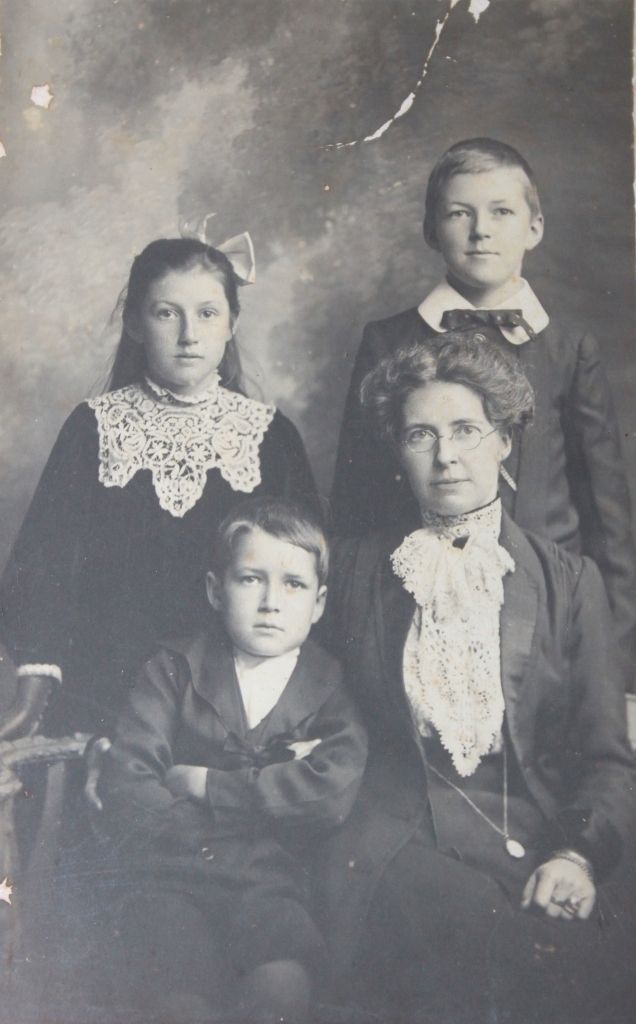
Photo caption reads: 'Daisy Williams with her children Kathleen Jack and Cedric Williams'
Meanwhile, at Pittwater and Mosman:
BAYVIEW, PITTWATER.
A handicap rowing race for local boats took place at Pittwater on Saturday last, the result being an easy win for the Magazine boys,with W. Dicken’s son second Six boats competed over a course of about one mile-from Mr Geddes' wharf to Church Point. Mr Booth acted as starter, and Mr Mulligan as judge. BAYVIEW, PITTWATER. (1896, March 9). The Sydney Morning Herald (NSW : 1842 - 1954), p. 6. Retrieved from http://nla.gov.au/nla.news-article14040596
On the Towler's Bay side there are several residents who pull across the water to the wharf at Church Point and meet the steamer from Sydney or the coach from Manly, as the case may be. The dynamite powder hulk is moored in Towler's Bay, with residences on shore for the officers in charge. Mr. Robert Robinson has his residence of Raamah at the same place. Mr. Robinson informs me that he can grow to perfection such tropical fruits as bananas, guavas, ginger, mangoes, pineapples, Brazilian cherries, &c. This fact will demonstrate that there can belittle or no frost in this locality. Other residents of this side of the bay are Mr. F. Chave, Wood-lands, who has a very nice orchard, mostly summer fruit ; Mr. E. C. Johnstone, who has a nice residence and orchard; Mr. A. Steffani is another prominent resident, while the residence of the firm of Flood and Oately occupies a lovely peninsula in the quiet waters of the bay. Mr. Geo. Brown has a residence and an orchard in the neighborhood, and there is also a small church and cemetery at Church Point. Manly to Broken Bay. (1893, November 11). Australian Town and Country Journal (NSW : 1870 - 1907), p. 19. Retrieved from http://nla.gov.au/nla.news-article71191632
Cedric Vincent Williams recalled to us this year fond memories of his great-grandparents, grandparent's lived on a farm they had at Towler's Bay, so it would seem reasonable to think Williams were in at least one of these five 'rowing' boats.
The Visionary John Williams of Bayview and Mosman would be John Junr. or his father - based on the address given in Macquarie Place:
MOTOR BUS TRANSPORT Sydney's Modern Service Nearly 450,000 Carried Daily
Monday, April 23, marked the anniversary of the arrival of the motor bus in Sydney (says a Southern journal).It was on that date in 1907 that John Williams, of 19 Macquarie place, Sydney and Bayview, walked into the Traffic Office of the Police Department, seeking a license to operate the first motor buses known to Sydney. Five French charabancs (Asters), he had bought from Bead Bros., of Manly, to run in opposition to the horse coaches. A policeman at the desk scratched his head. A motor omnibus? As if a horse -bus or tram weren't sufficient ! In law or the book of regulations there was no such thing as a motor omnibus. But John Williams was adamant. He sensed that the population on the route from Manly to Pittwater would be better served by a bus, and he would run it.Not even the tariff deigned to recognise the separate entity of this self propelled vehicle which it lumped under bicycle imports. But, by this or by any omission in the regulations' John Williams was undeterred- and he waited patiently for the simple right to ply for hire. The clerk scribbled in some records, and handed over a license under the Horse and Carriage Act. He produced, too, a horse driver's license, and wrote across it, for want of something better, the word 'mechanical.' John Williams examined them, and smiled, wondering whether he was not too far ahead of the times. The records of that venture, and its prior life under Read Bros., who apparently didn't worry about a license' are mainly memories now. John Williams is dead seven years, and scattered are the people who rode in his buses until he sold them out, his machinery junk and himself considerably dispirited. Development of 21 years, however, has lifted Sydney literally off its feet in a way that probably even John Williams, that man before his time, could not have dreamed.
BUSES AND TRAMS.
In March, 1928, when Sydney's entire tram service moved 901-214 passengers a day the private competitive omnibus services moved 449,876 passengers a day. This vast motor transport was done with 502 vehicles. The growth that comparison represents for the private bus has occurred mainly since 1920, when the new transportation got its greatest fillip. The number of licensed seats available in buses each day for travellers within the metropolitan area is 301,300. That is approximately three-quarters of the total passenger journeys a day. The excess of 147,885 passenger journeys a day does not mean an overcrowding of accommodation, although overcrowding at peak periods is inevitable today under the prohibit-on against any increase- in the number of buses on the road. A seat, while it may be used in theory once each bus journey, is utilised several times or by passengers at different times in a single journey. In 1921 Sydney operators put 182 buses on the streets, and the ratio of vehicles to operators was 2 to 1. Most intense competition prevailed in 1924 and 1925, when the police went at last deeply into the question of coordinating the bus services. In 1924, 173 operators entered the field with 531 buses. Then when there were more operators than at any time before or since, the ratio of buses to operator was 3 to 1. But by August, 1925, when the number of buses reached the peak of 594, amalgamations and competition had eliminated 18 operators. Since then the number of operators' and buses has been steadily reduced. A larger bus, more comfortable and economical, has been evolved in the different classes of work, a considerably greater number of passengers are gradually being catered for. Today there are 502 buses and 117 operators. The biggest company runs 87 vehicles, the next 38, and a number of others 13 to 20.
WAGES REACH £750,000.
The development of motor bus transportation is not a mere matter of increased mileage or passenger journeys— figures with which to dazzle the mind. Its fluctuations have a close relation with the commercial life of the people than have possibly the rise and fall of traffic administered by the Government as a monopoly. This is because the people are more directly and individually concerned in ownership of or dealership in some instrument or other essential to motor transportation, and what threatens one section of the motor world has it repercussions in another. The latest figures of labour engaged directly in the maintenance and management of motor bus services of Sydney, show a total of 2610 persons. The wages paid annually to these is just under £750,000. Approximately 2000.homes are sensitive to any fluctuation in the fortunes of this transport. system. The annual turnover of these, based on figures compiled in March, is £4,096,-'000. An annual mileage of ,17,261,900, based on March figures, with all that it involves in petrol and oil consumption, wear and tear of parts and tyres, construction and renewal of bodies, means a constant demand for labour and materials in the allied motor industries.
IMPOSSIBLE POSITION.
It is difficult for the average citizen to regard with equanimity any diminution of the private services that have given him such rapid and comfortable transportation. It is difficult for the thousands who are directly and indirectly dependent on the private motor bus enterprise as wage, earners of one degree or another, to rest under the thought that governmental interference with this necessary transportation may yet grip Sydney as it has gripped other cities in the Commonwealth with disastrous results. Yet! Sydney's bus system today is threatened with what amounts to a briga adage. Although ever since the time of John Williams, in 1907, the Traffic Department has issued licenses to ply on particular routes — rights which are not subject to annual renewal, but continue uninterruptedly so long as the operators give satisfactory service —the suggestion has been made public several times that the State Government will take over the buses on July 1 or cancel their right to run on the main routes, without which, in many cases, the smaller routes could hardly be maintained. Trams under the present lay-out of the city cannot be expedited very well, but the speed and flexibility of the bus enables the latter to safely handle passengers in the heaviest of mixed traffic. Yet both are overcrowded (though not overloaded)at peak hours, and thousands are forced to suffer extreme discomfort. The Sunday Mail Special Motor Number. (1928, May 6). Sunday Mail (Brisbane) (Qld. : 1926 - 1954), p. 22. Retrieved from http://nla.gov.au/nla.news-article100128648
While their father was busy trying to improve transport, the Cedric M Williams began his schooling - at Mona Vale:
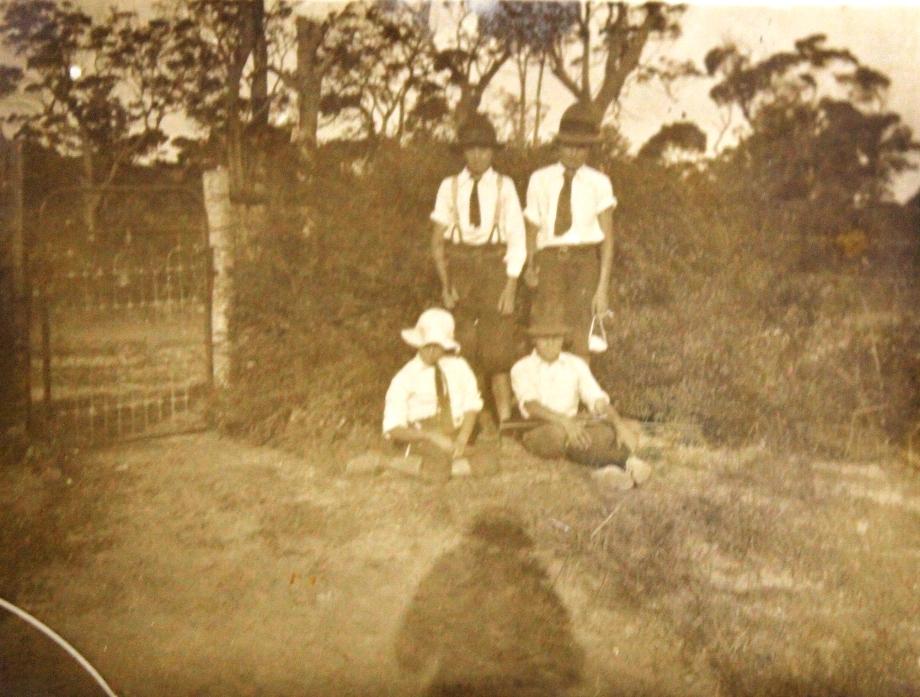
Caption on back of photo reads 'Tomas Campbell, Yours truly- Cedric M Williams , John Wilson, Duglas Wilson - Mona Vale' -
Some families have quietly gone about doing what they love best, and in doing so, have contributed so much for so long, that what they have achieved may sometimes be unseen by we who come afterwards. This is just one incidence of ensuring a community has what it needs and has at least for decades of records of Williams:
Ambulance waggon for Pittwater
Pittwater district is now in possession of an ambulance waggon, an up to-date vehicle having recently been handed over to the residents of the Warringah Shire. Councillor Powell, in congratulating the residents, called upon Dr. Thomas to perform the official ceremony He paid a warm tribute to the work performed by Constable Hewitt, Councillor Powell, and Mr. Williams. A demonstration in first aid was given by Mr. C. D. Paterson. AMBULANCE WAGGON FOR PITTWATER. (1910, May 2). The Sydney Morning Herald (NSW : 1842 - 1954), p. 6. Retrieved from http://nla.gov.au/nla.news-article15119197
RELIEF WORKERS IN MOTOR CRASH 47 Involved - CRASH INTO TREE SYDNEY, Friday.
With the driver frantically trying to regain control, a motor lorry, carrying 47 relief workers ,to-day . crashed Into a tree in Bayview Road, Bayview, throwing the men in all directions. But for the tree, the lorry would have fallen over a 6ft. drop Into Pittwater.
Nine of the men were taken to Manly District Hospital by Manly District Ambulance for treatment. Bushell, who was found to have suffered a probable fracture of the skull, and Tickner and Hyslop with severe lacerations and shock, were admitted to hospital. The others were allowed to leave.
The more seriously Injured men are: —John Bushell, 50, of Osborne Road, Manly, head injuries, large wound on right leg and right finger. Arthur Hyslop, 54, of Banksia Road. Dee Why, probable fractured left leg, Injuries to right arm. and probable internal injuries. Henry Tickner, 61. of Daisy Street, Dee Why abrasions to legs and severe shock. Other men, treated for minor injuries, were: —Arthur Brunette, G3, of High Street, Dee Why, Alonda Augustus Roney, 35,Bennett Street, Manly Vale; Herbert Pomfrett, of Headland Road. Curl Curl; Frederick Loxton, 40, of Dalley Street, Harbord; Charles Rowles, 50,of Pittwater Road. North Manly Arthur Smith, 44, of Pittwater Roard, Brookvale. Ambulance treated several others at the scene of the accident for shock and minor abrasions. The lorry was one of four conveying the men to the scene of roadway construction in progress at Church Point. Aproaching a sharp bend in the road near Fermoy Avenue, the steering gear of the third lorry suddenly failed, and, failing to take the bend, the lorry crashed headlong into the tree, catapulting Its passengers into the air. Mr. Cedric Williams, who lives in Fermoy Avenue, about 50 yards from the accident scene, was at the rear of his home when a terrific crash was heard.
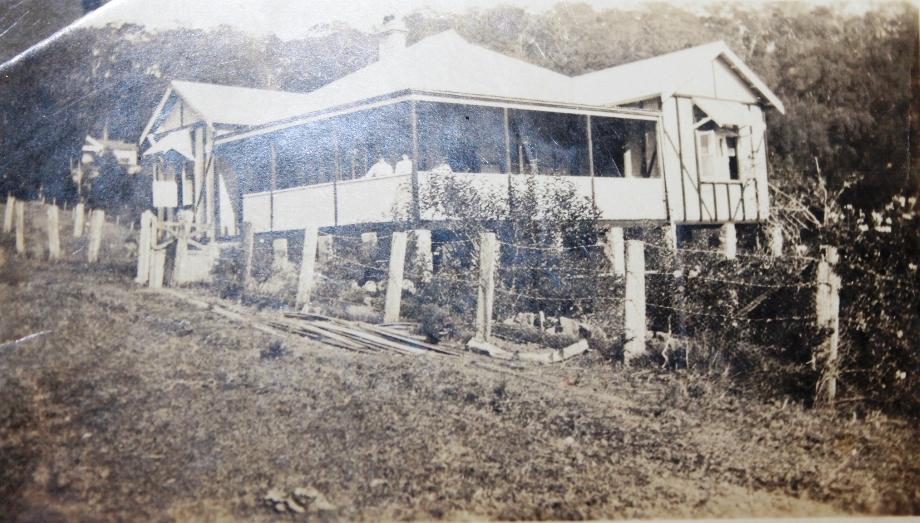
The Williams Home in Fermoy Avenue - Elizabeth Hird (Nee Williams), explained her father built this property and her mother Sophie Iris Williams (nee Fox) had told her rooms were added as needed. John L Williams and his wife had a home further up the hill and Kathleen Fox (nee Williams) eventually resided next door. Picture courtesy Elizabeth.
'We couldn't see what had happened from where we were,' he said, 'but before we could investigate, a man came running up, shouting out. 'We've had a smash at the bottom of the road. Quickly, can you give us some water.' The man's clothes were torn and he was covered In dust.' Mr. Williams provided the man with a can of water and with his mother accompanied him to the scene of the accident. ''It was an amazing sight. Men were lying everywhere.' he said. 'A local doctor, who had been called, was attending to the injuries of the men.' They certainly were lucky men, for the most part. Only for that tree, which prevented the truck from going into the water, some of them may have been drowned.' Manly District Ambulance was not long in arriving, and after first aid treatment was administered, nine of the men were taken to Manly Hospital. Miss Ruby Cowell, of Bayview post Office store,' was standing at the doorway of a shop when she heard what she describes as a loud bang
'Four trucks pass dally.' she said, 'and I had already seen two of them go by, and when I heard the crash. I guessed it was one of the other trucks.' Miss Cowell directed one of the relief workers to a telephone to call the ambulance. NINE INJURED. (1938, January 29). National Advocate(Bathurst, NSW : 1889 - 1954), p. 4. Retrieved from http://nla.gov.au/nla.news-article160704753
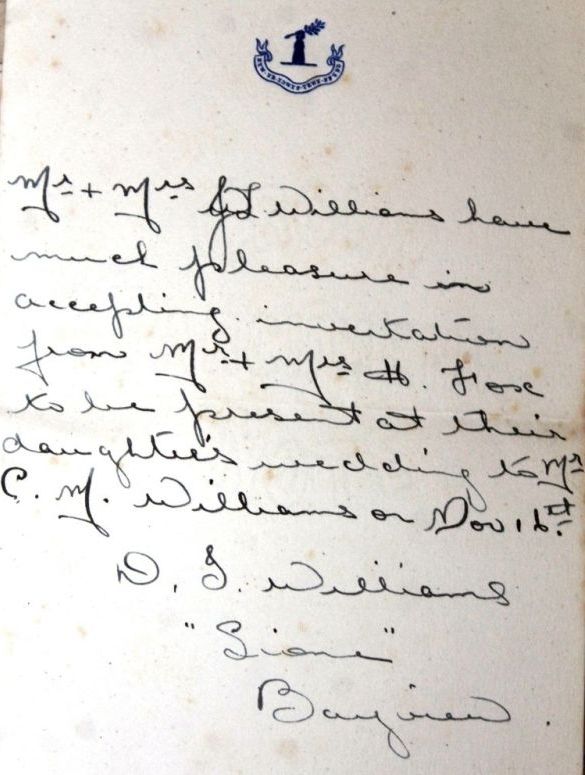

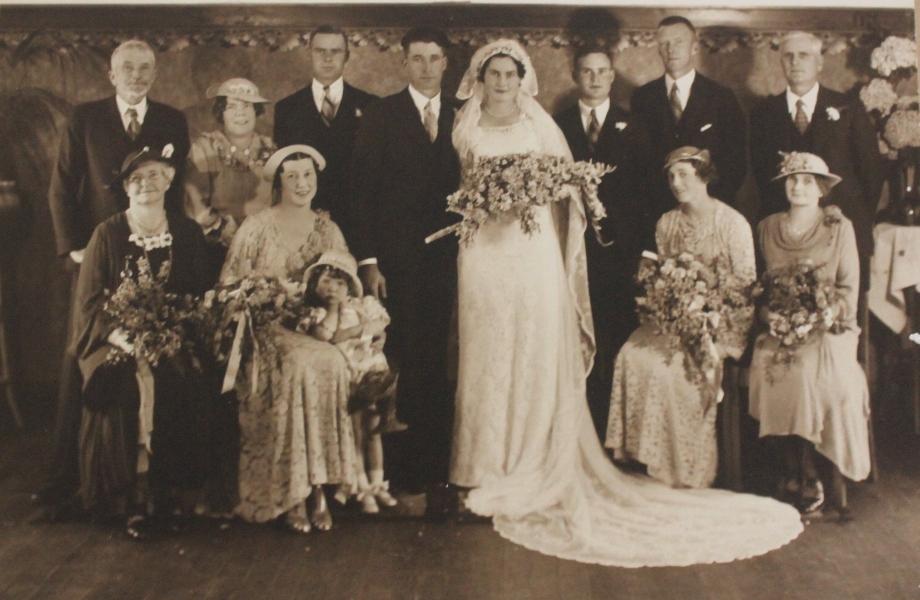
John Williams and Sons was at Bayview wharf – see Bayview Wharf history
They saw the original big wharf being built, and were Keepers of the Light there too!:
From Warringah Shire Council records:
5th June 1908 (handwritten 46th Meeting, Minutes) Tenders for steps at Bayview Wharf:
Bayview Wharf Lighting: lighter of lamps on. Bayview Wharf: C M Williams resigning from his position as lighter of lamps on Bayview Wharf 25/2/1920 (Cr.s Hweitt and Quirk) That C.M. Williams resignation be accepted, and that Charles Charlesworth be given the work at a wage to be arrived at by the Council's Inspector. Charles Charlesworth, offering himself for same position.
Williams of, Bayview be requested to tend to the lighting of Bayview Wharf at the same remuneration as granted to the previous lighter. 8/10/1929
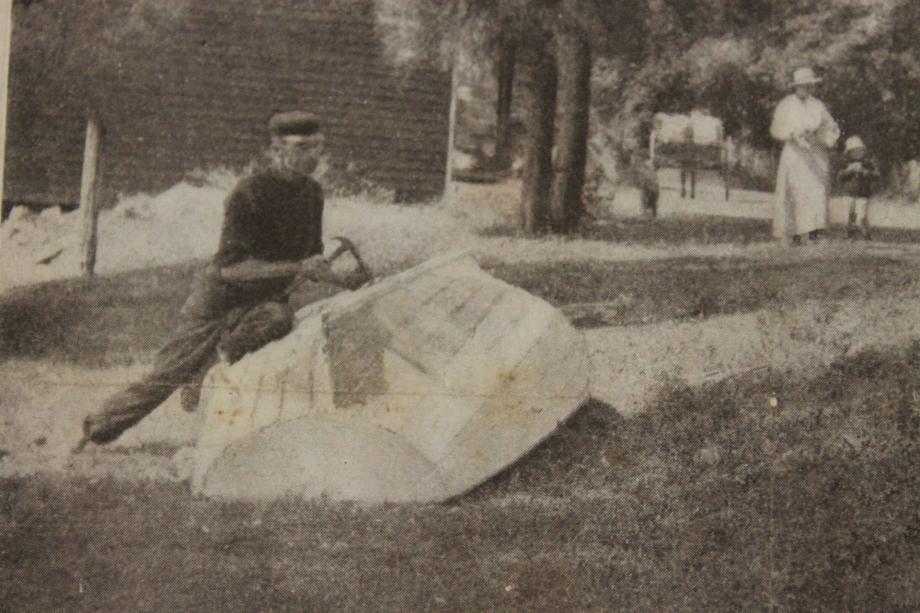
THE GALATEA' W. A. Dettman will shortly launch his new cruiser Galatea, which is in the hands of J. Williams and Sons, of Bayview, Pittwater. She is 63ft overall, with a clipper, bow and counter stern. . The vessel will have splendid accommodation, with a bridge deck, a promenade deck, 20ft long, and a sun deck. There will be sleeping accommodation for ten. The craft is to be added to the register of the Y.M.Y.C. Mr. Dettman .has purchased a Spanish bungalow at Salt Pan, and is laying down moorings, not only for his own craft, but also for prospective visitors. Motor Sport and Motoring. (1934, June 7). Referee (Sydney, NSW : 1886 - 1939), p. 24. Retrieved fromhttp://nla.gov.au/nla.news-article136117004
GALATEA LAUNCHED :W. A. Dettman's redesigned cruiser, Galatea, was launched from the yards of J. Williams and Sons, at Bayview, Pittwater. This craft would hardly be recognised by those who saw her in Victorian waters, where she was known a few months ago as Roena. She has been lengthened - to 63ft overall. Her straight bow has been removed, and she now has a clipper- one, with a counter stern. The Galatea presents a striking appearance, having a bridge and. promenade deck, and sun deck. Sleeping accommodation has been provided for eight. The trials are to take place at the week-end, and the craft is expected to be in full commission by August 1. DIRT TRACK ENGINES AFLOAT. (1934, July 12). Referee(Sydney, NSW : 1886 - 1939), p. 24. Retrieved from http://nla.gov.au/nla.news-article136121332
BOATBUILDERS BUSY N..S.W. boat builders will be kept exceptionally busy during the next nine months. New cruisers are under construction by W. L. Holmes and Co. at McMahon's Point; L. Halvorsen, at Neutral Bay; Walker and Kelshaw, Rushcutter Bay: Jack Robinson, Balmain; C.Larsen, Gladesville ; A. G. Williams, Drummoyne ; John Williams and Sons, Bayview; G. and H. Solomon, Newport; Peter Kemp, Kogarah Bay; and Shevili Bros., at Sans Souci. Within the next three weeks cruisers for J. S. Bruce, Max Mantel, and II,P. Christmas will be ready for launching. AUSTRALIAN AND N.S.W. MOTOR BOATING CHAMPIONSHIPS. (1936, January 9). Referee (Sydney, NSW : 1886 - 1939), p. 11. Retrieved from http://nla.gov.au/nla.news-article135644471
What you can show people when you are a boatbuilder and can take them where there are few tracks yet:
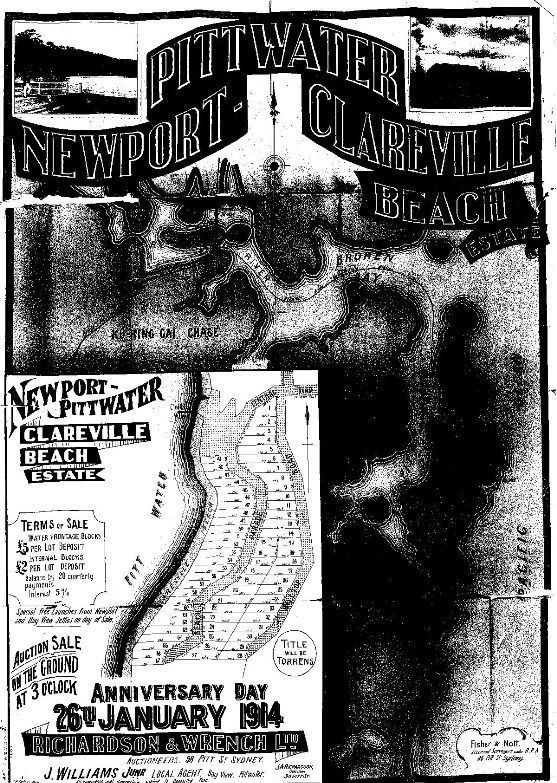
1914 Clareville Estate
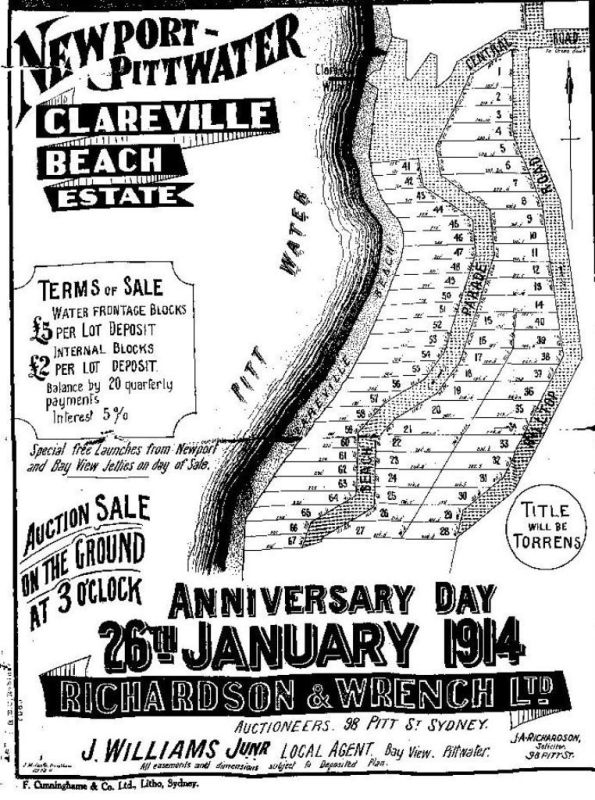
TOMORROW'S SALES. Tomorrow being Anniversary Day, and a holiday, has been chosen for the sale of many subdivisions in many parts of the State. Investors have a fine bill of fare to select from in mountain, seaside ,and suburban estates. Messrs. Richardson and Wrench, Ltd., have two important sales in hand, at Balmoral and the Clairville Estate, which, faces Pittwater Harbor. … The Claireville Estate supplies the opportunity for those looking for cheaper blocks on an equally attractive beach. Messrs. Richardson and Wrench have made arrangements to cater for their clients at this sale, and motor-launches will meet the motor-cars from Narrabeen at Newport and Bay View and from the Hawkesbury River railway station on the day of sale. On the opposite side of this narrow neck of land, which is on the road to Barrenjoey, Messrs. Stanton and Son, Ltd., will, about the same time, cater for investors who desire to acquire blocks in the Careel Ocean Beach Estate, which is situated near the Hole in the Wall. This firm, too, will run free motor-launches to meet the down motor-cars and the train at Hawkesbury from Sydney. Both propositions have considerable future values, and, judging from inquiries which the auctioneers have received, there will be a good attendance of buyers for blocks in both estates. ACRES AND LOTS. (1914, January 25). Sunday Times(Sydney, NSW : 1895 - 1930), p. 4. Retrieved from http://nla.gov.au/nla.news-article120363861
Boatbuilders and men of the sea, especially those with so much experience:
MOTOR-LAUNCH BURNED OUT
A 24ft motor-launch burned out last night after it caught fire at its mooring at Bayview, on Pittwater. The boat, a raised deck cruiser called Merjo, is owned by two brothers named Hatterslcy, of Herne Bay housing settlement. Mr J Williams, a Bayview boatshed proprietor, with his brother, towed the burning boat alongside a wharf. Police said the vessel was valued at about £600. Senior constable Jenkins, of Mona Vale is inquiring into the cause of the fire. MOTOR-LAUNCH BURNED OUT. (1951, February 26). The Sydney Morning Herald (NSW : 1842 - 1954), p. 1. Retrieved from http://nla.gov.au/nla.news-article18201198
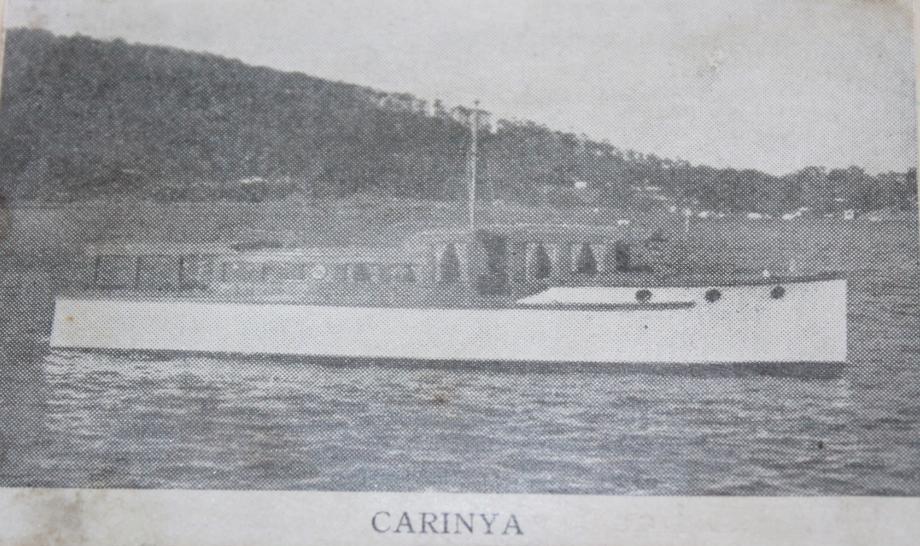
Carinya One of the Boats Cedric M Williams Built as part of J Williams and Sons.
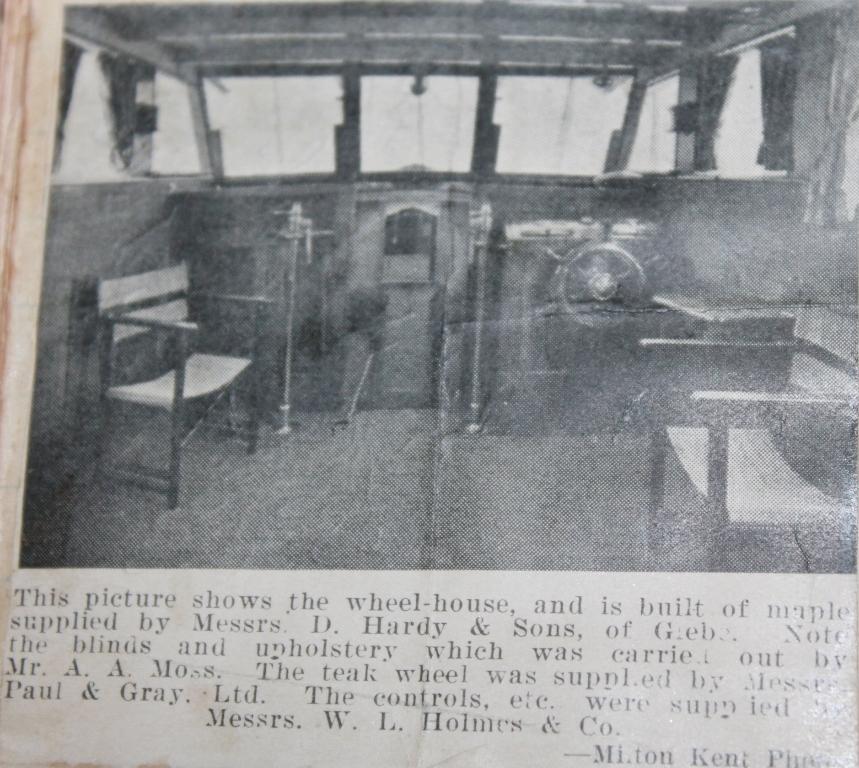
Interior - Carinya
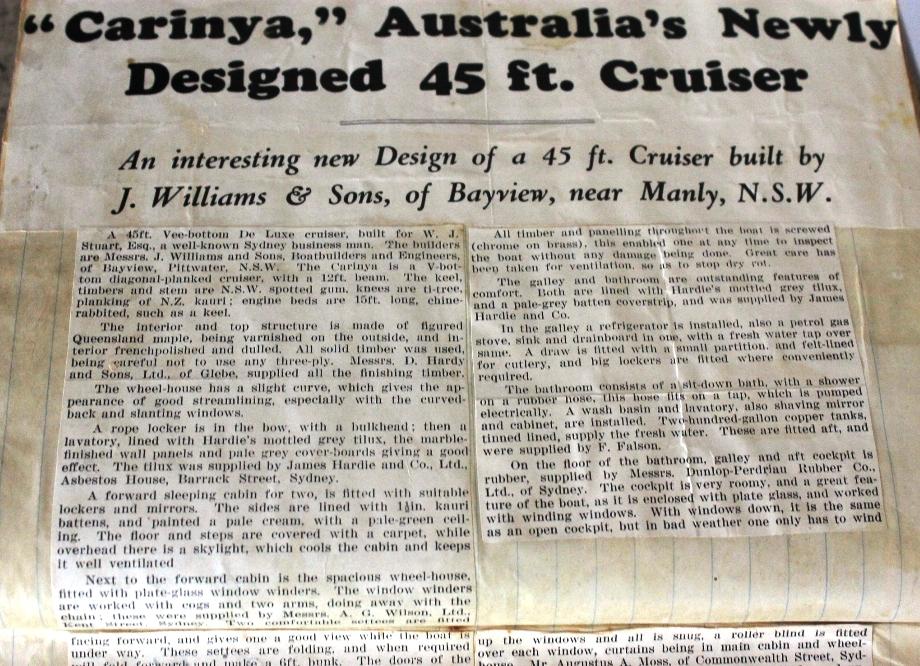
Description of Carinya
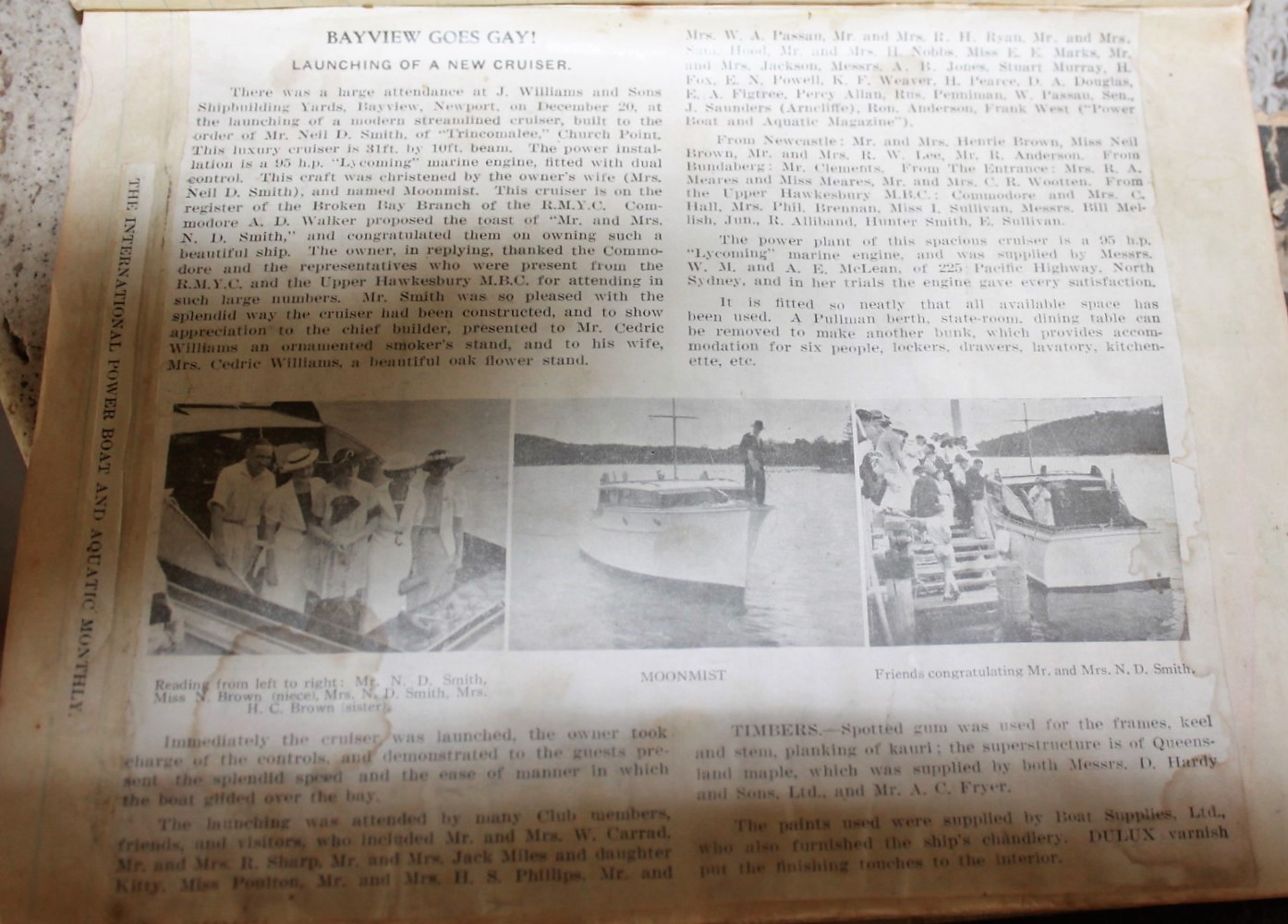
N. D. Smith - of 'Trincomalee' , Church Point - Moonmist built by John L Williams and Sons
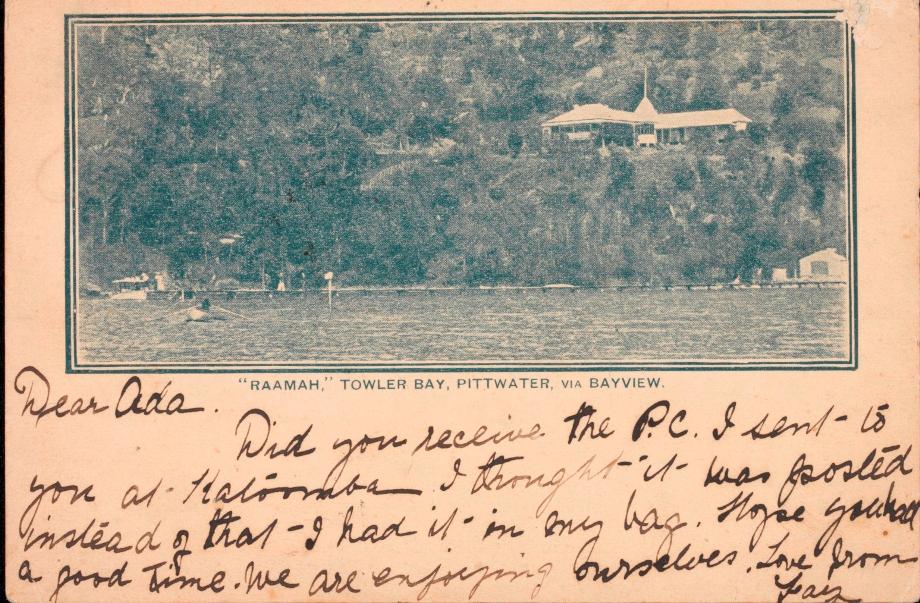

Williams Shipwright's - The Slips
Being a Boatbuilder and on the waterfront during WWII brought with it certain duties - Cedric Vincent Williams gave a few insights on what he recalled:
They were trying to stop the Japanese coming into Pittwater. There was a net across the mouth of Pittwater, which you had to go through if you wished to go out to sea. I used to go fishing a little bit then and I remember hating having to go through that net gate.
I remember my father used to go fishing at that time with some of the local people and I too would go out sometimes. I always remember the fact that you had to go through the gate to get out to sea – we didn’t do this very much as no one wanted to be out in the ocean at that time with so many Navy vessels and possible submarines and enemy ships out there.
I remember we’d fish underneath West Head and the guns would be up there and they’d point them down on us! So I knew they were there.
When we were living further towards the Mona Vale end of Bayview the Army were there. We lived in Roche Avenue – just up from where the Tennis courts are now. The Army were camped further along, where the dog park is now – there were three houses, ours included. They had their tents there, all along there, so you were conscious of the Army being about. We weren’t allowed to have much to do with them of course.
Apart from having the net and gate to stop people at the Palm Beach end they put stops around the edges of Pittwater – these concrete pyramids. They were great heavy things they dropped in so nothing could go over them. They used to go all around the foreshores. Eventually they kept sinking down into the mud of course, and there is a lot of them still under the mud even now. They had great big steel loops on them.
My father would get them and make moorings out of them – they could never move, once they were put down they were there, permanently. The only way he could do it was get two dinghies together, wait for the tide to come in to lift it, tie the pyramid concrete onto it, then cut it – a couple of times the dinghy was sinking just as much as the pyramid!
Beau McFee of Bayview describes his role in Pittwater during World War II
"In June ‘42 the order was given to evacuate all craft (including dinghies) from Pittwater and moor them in Cowan Creek (upstream from the Galston Punt). Three boat builders, Cedric Williams (Bayview), Solomans (Newport) and Goddards (Palm Beach) were authorised to perform the work. As the coxswain of the pre-war Pittwater Aquatic Club’s Eight (housed in the current Scout Hall), I was teamed with Cedric Williams as his only crew. We selected a solid, twin-engined 40ft cruiser as our tug and proceeded to remove all boats from moorings, boat sheds and onshore and to tow them to Cowan. Cedric’s elder brother, Jack Williams operated a similar unit. We lived on the boat for about 3 weeks and travelled most of the night and all day. Not much studying for the Leaving [certificate] was achieved. However, I was on the Department of Supply payroll as compensation.
After about 60% of the craft were in Cowan Creek, torrential rain caused a massive flood in the upper regions of Cowan. The boats broke the steel cable mooring lines, then the Punt cables (crushing scores of boats in the process) and the whole armada floated into the Hawkesbury and down to West Head. Next day we started collecting boats as they drifted down the river and towed them back to Cowan. The river was littered with debris and the damage enormous. Owners were subsequently compensated and Cedric Williams later in the war, as an Army Lieutenant in the small ships section, spent 1-2 years handling compensations. I spent the next 3 years in New Guinea, Darwin and Borneo and returned to Bayview in December 1945, in time to receive our family's old 12ft skiff from the Cowan storage - all in one piece, whereas many fine craft were lost or damaged." - Australia Remembers Exhibition, 1995.
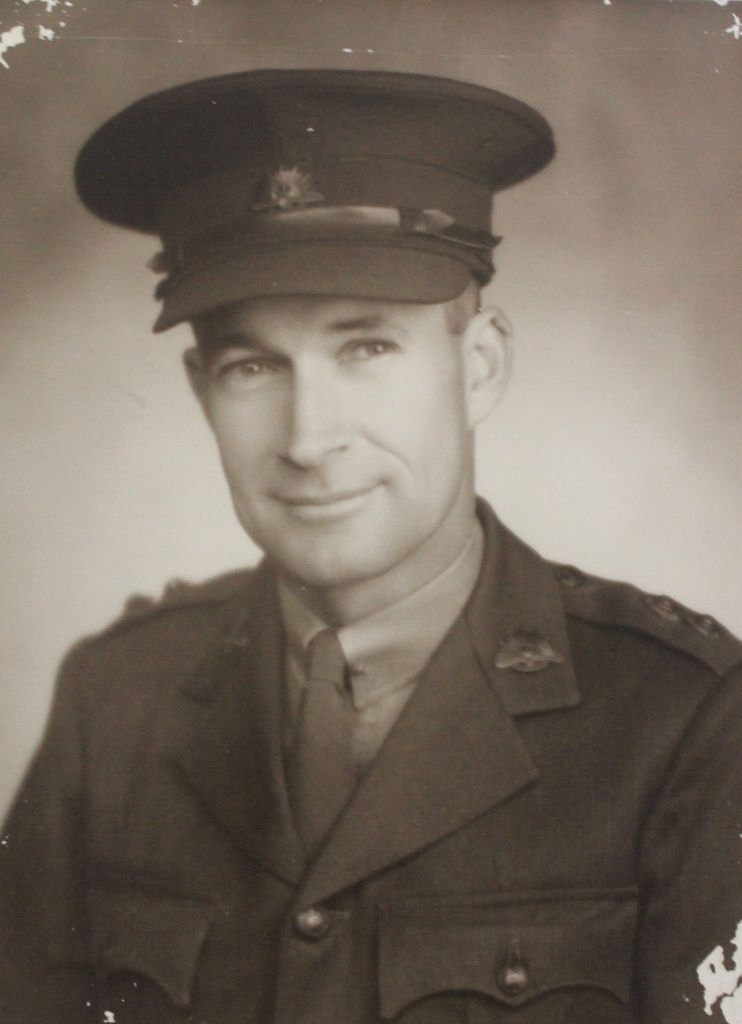
Cedric M Williams - WWII: National Archives of Australia Records - WILLIAMS CEDRIC MORETON : Service Number - N393326 : Date of birth - 19 Jan 1904 : Place of birth - SUMMER HILL NSW : Place of enlistment - PADDINGTON NSW : Next of Kin - WILLIAMS SOPHIE. Date range: 1939 - 1948
Others for a wharf with lots of traffic, from Warringah Shire Council Minutes of Meetings:
Evacuation Circular letter from Minister for National Emergency Services, 16/1/42, to Town and Shire Clerks, regarding arrangements which must be made to deal with the evacuation, if and when considered necessary, of the civil population from areas affected or likely to be affected by enemy action, and placing responsibility for such work on Councils. On the recommendation of the President it was resolved that a Special Meeting of the Council be held after the meeting of the Finance Committee on Tuesday next„27th inst. for the purpose of considering the matter. It was decided, on the suggestion of Cr. Williams, that the Bayview Military Authorities be requested to delay the completion of the Wharf wiring of Bayview wharf for as long as deemed advisable in order that the public may continue to use the wharf as long as possible. The Shire Clerk, through the President, sought permission to Aluminium order 6,000 dodgers for house-to-house distribution in B and C. Ridings in connection with the collection of aluminium for war purposes, and desired authority was given.
Reporting that Bayview Wharf had been closed off and a notice erected pending repairs: The Engineer orally reported he had been in touch with three or four divers whose services could be obtained when they were available, that the Council "would pay anything up to £100", and when they had finished their work the Council would be free to operate on the rest of the Wharf: 5/1/1943
Submitting progress report in regard to repairs at Bayview wharf : "Received" 19/1/1943
The SHIRE ENGINEER'S REPORT was dealt with as follows:- (1) Submitting report on the progress of the work of repairing Bayview Wharf, and what is still to be done, and giving estimates: Wharf Resolved, - That the work be carried on and completed, and that £300 amount of the Engineer's estimate, be voted to cover the cost of the whole work. (yrs. McLean, Bathe) 2) Reporting that portion of Taylor's Point wharf has collapsed, submitting estimates of the cost of necessary repairs, stating that notices have been erected at the wharf advising that the wharf is closed: Resolved, - That the necessary repairs be proceeded with, and that £100, the amount of the Engineer's estimate, be voted for the work. (Crs. Batho, Hitchcock) 2/2/1943
12/10/1943: Cr. Hitchcock: Can something be done to the Bayview baths to make them usable? The President replied that the work would be done if wire can be obtained.
Petition (per J. W. Lustin) 14/10/43, from 59 residents of Bayview for the placing of the baths adjacent to Bayview wharf in good repair. Resolved, - They be informed that the Council has no wire netting, and asked if they are able to obtain any. (Crs. Batho, Hitchcock)
Elizabeth Hird (Nee Williams) recalled her mother helped make camouflage nets for the army units stationed at Bayview.
After the war is over:
13/10/1958: Pittwater Road Bayview - Application by J.L. and C.M. Williams for Special Purchase for land adjacent to Bayview baths, and request for permission to install petrol pump on this land 14 ft from the street alignment: Resolved, - That consideration of the application be deferred and that Messrs. J.L. and C.M. Williams and the Cumberland County Council be informed that the Council is not prepared to give its opinion or a decision in this matter until such time as the applicants place before this Council plans for the re-modelling of existing installations to meet the Council's foreshore requirements and to improve the area for the benefit of the public. (Crs. ' Fisher, Corkery)
2/2/1959: Item (9) Letter from Cumberland County Council requesting Council's views on application by J.L. & C.M. Williams for "Special Purchase" covering land adjacent to Bayview Baths. Moved by Councillor Berry, seconded by Councillor Reynolds that this matter be referred to the next Meeting of the Finance Committee for consideration to the granting of a "Special Lease". This Motion was carried on the President's casting vote.
25/5/1959: Item D17. Pittwater Road Bayview - Letter from J. Williams & Sons, regarding their application for Special Lease adjacent to Bayview Baths, and requesting consideration of Councills requirements for a parking area of 30 cars: 14.Resolved - that in regard to this application Council inform J. Williams & Sons that the full terms of Council's Resolution of the 21st April must be adhered to. (Crs. Fisher/Wilson.)
The Williams family would have many holidays on the estuary, going up the Hawkesbury on a boat named 'Cedbeth' after their two children.
Pittwater Regattas - born from a one-off race - did John Williams build the local boat?
In 1905 a race took place between some local sailors. From this was born decades of Pittwater Regattas that placed Pittwater firmly on the sailing map.
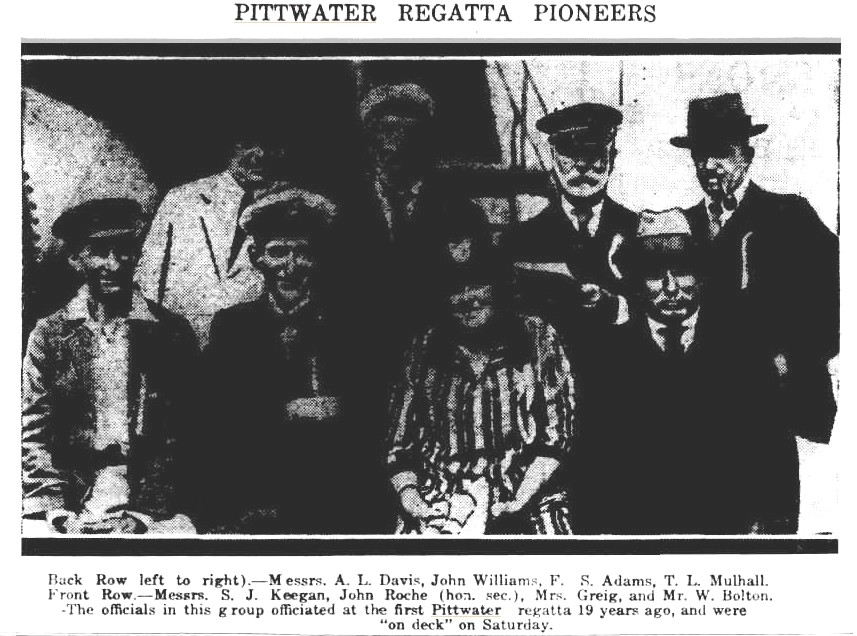
PITTWATER REGATTA PIONEERS
Back Row (left to right). Messrs. A. L. Davis, John Williams, F. S. Adams, T. L. Mulhall. Front Row. Messrs. S. J. Keegan, John Roche (hon. sec), Mrs. Greig, and Mr. W. Bolton.-The officials in this group officiated at the first Pittwater regatta 19 years ago, and were 'on deck' on Saturday. PITTWATER REGATTA PIONEERS. (1926, January 1). Arrow(Sydney, NSW : 1916 - 1933), p. 13. Retrieved from http://nla.gov.au/nla.news-article105944548
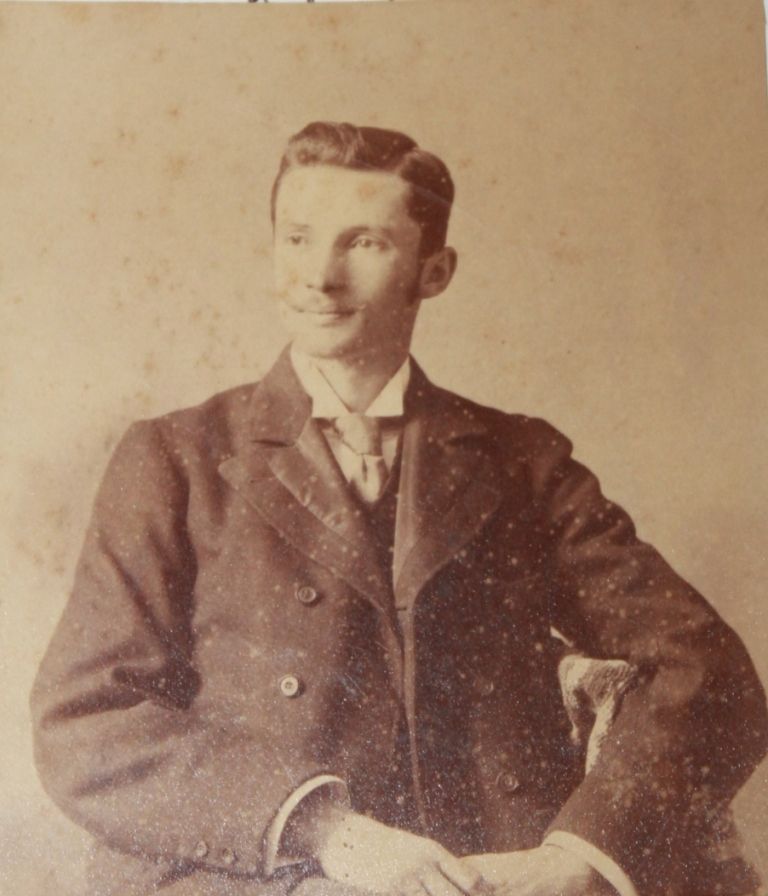
John Williams - father of John L and Cedric M Williams - courtesy Elizabeth Hird (Nee Williams)
Pittwater Regatta came into being as the result of a private match, in December, 1905 between the Crouch brothers, of Queensland, and W. D. M. Taylor, who sailed the Carella, owned by Lord Forster, and Mr. John Roche, for 21 years honorary secretary for the regatta. An unusual course was chosen, being from Pittwater, where the flagship was moored on Saturday, around Lion Isle and back, a distance of 18 miles. The Crouch brothers won.
Local residents became enthusiastic as the result of this match, and the first regatta was held in February, 1906. It catered for local sailing and rowing boats, but there were only six starters for the first motor launch race. Both the entries and prize-money have in-creased annually. This year there were 107 sailing boats. 57 heavy boats, and eight events under New South Wales Rowing Association conditions, with crews totalling 80 rowers. There were also three races for Navy LeagueSea Cadets.
The regatta is now recognised as one of the most popular and spectacular in Australia. It has, too, many interesting personal characteristics. Among those who were connected with its inauguration 21 years ago, and who are at present taking an active part in it, are Mr. John Williams (the first president),Mr. W. D. M. Taylor, Mrs. E. G. Greig (formerly hon. treasurer and assistant secretary, who has not missed a regatta for 21 years),and Mr. John Roche (secretary from the beginning).
The Governor-General (Lord Stonehaven)was received at the Bayview Wharf on Saturday morning by Mr. Roche, who introduced him to the president of the Warringah Shire Council, to Mr. Archdale Parkhill, M.P., Mr C. A. Le Maistre Walker, C.B.E. (president of the regatta committee), Mt. R. W. D. Weaver. M.L.A.. Mr. John Williams, Alderman S. H. Burns (hon. secretary of Balmain Regatta), Mr. H. G. Alderson (chairman of the New South Wales Rowing Association). Mr.W. N. Cuthbertson (general manager of the Newcastle and Hunter River Steamship Company), and Mrs. E. G. Greig. The Navy League Sea Cadets provided a guard of honour beneath arches of flags and greenery prepared by residents of the district. His Excellency then embarked on the motor cruiser Miramar, belonging to Mr. Stuart F. Doyle, commodore of the Royal Motor Yacht Club. At 3.30. p.m. Lord Stonehaven was received aboard the flag-ship Newcastle. PITTWATER. (1928, January 2). The Sydney Morning Herald(NSW : 1842 - 1954), p. 4. Retrieved fromhttp://nla.gov.au/nla.news-article16431002
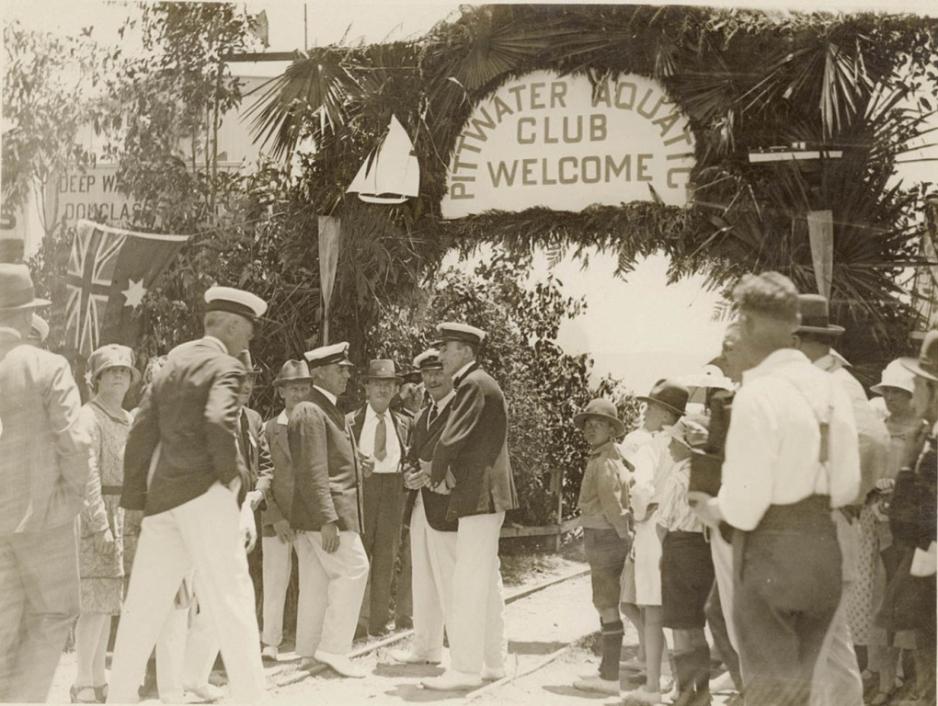
Above: Sam Hood image of Bayview's Pittwater Aquatic Club contributing to the regatta, with John Roche on Bayview Wharf track, circa 1925-1928. Digital Order No. a409025, courtesy State Library of NSW.
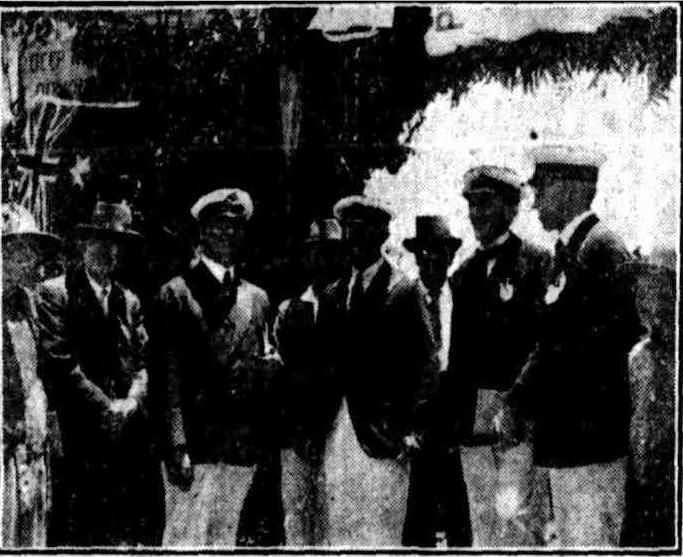
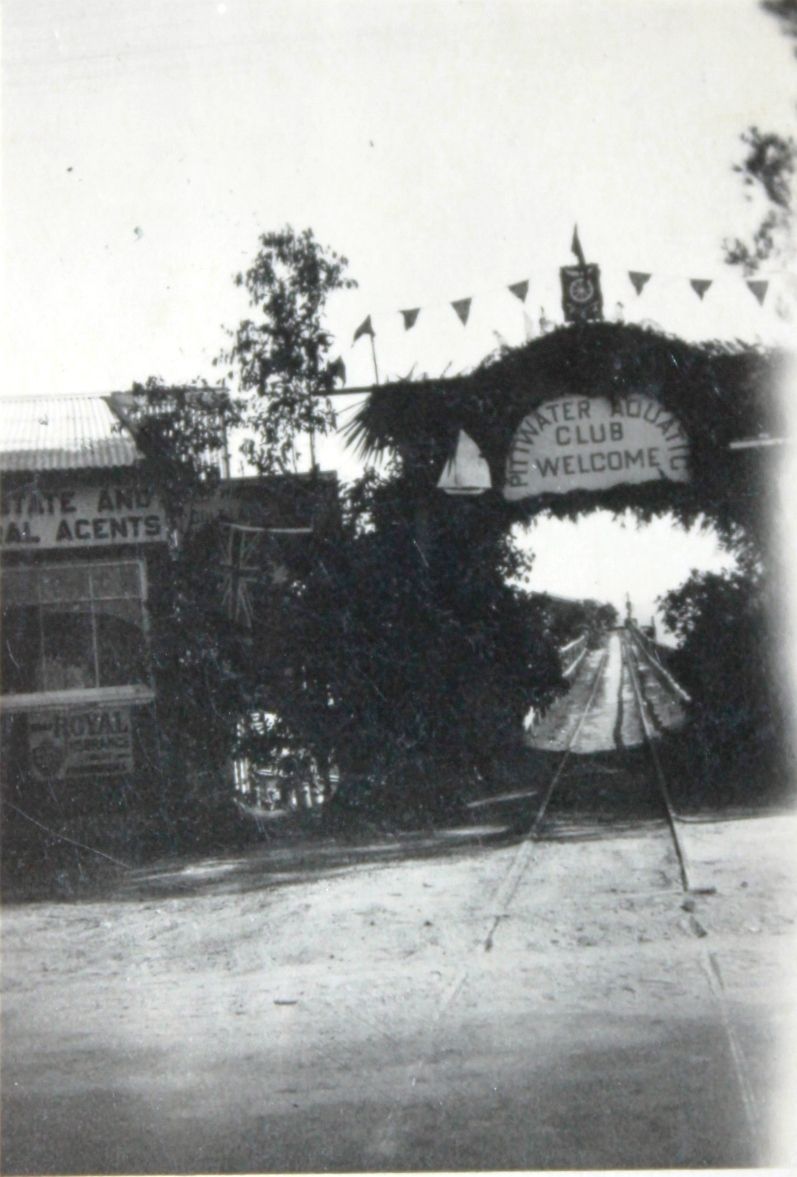
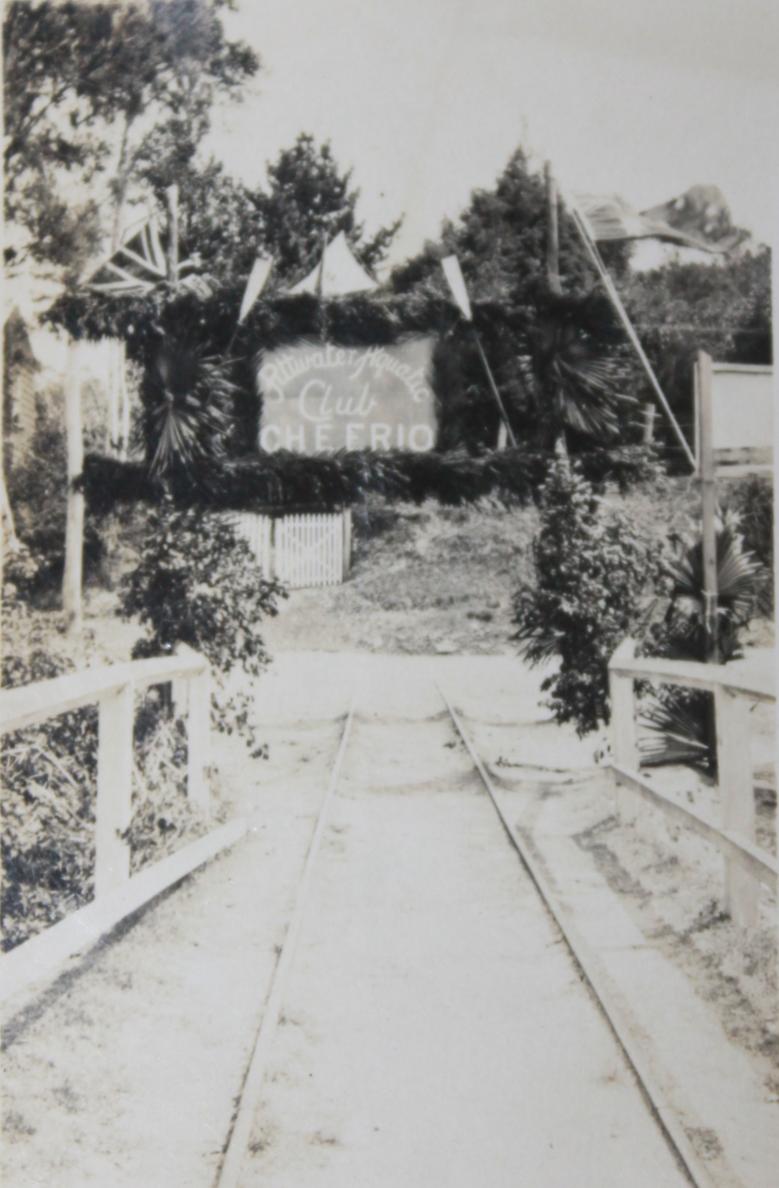
THE HANDICAPS. Handicaps for the open boats have been framed by John L. Williams. Capt. P. G. Taylor, M.C., and W. D. M. Taylor as follow; HANDICAP FOR LOCAL BOATS, 18ft and under (to start at 10 a.m.).-Mascotte (R. Sinclair) 14ft 12min; Moonbeam (J. Muston), 2sec., Wybia(C. M. Williams) 15ft, Vimy (A. J. MacKellar) 16ft, Wild Rose (B. Maudsley) 14ft,Very (P. G. Taylor) 16ft, 6; Garret (F. Roche) … 90 sec, Lorelei (C. J. Saunders), 17ft, scr.
14ft SKIFFS OF BIRCHGROVE CLUB (to start 210.45 a.m.).-Renown (J Hinchcliffe)min; Douglas (S. Johnson), 8 ½ ; Arawa (P. Pyne), 6; Plannet (C. Stanton), Sydney (F. Simmons), 5; Norma (R. Greenless) 3 ½ ., Unique (L. Gooud), Wairrigal (J. Thompson), 1; Rona(F. Deady), 30se; .Shamrock (P. Griffiths), Polygon (S. Greenless), scr.
14FT. SKIFFS OF BIRCHGROVE CLUB (to start at 2.5 p.m.).— Reknown 11; Douglas, 9 1/2 ;Arawa, 7; Planet, Sydney. 0; Norma. 4 ½; Unqiue, Warrigal, 2; Rona 1 ½ ; Shamrock and Polygon, scr.
HANDICAP FOR LOCAL BOATS (to start at 2.30).— Moonbeam (J. Muston), 22min, Wymia (C. M. Williams), Vimy (A. J. MacKellar).' 18; Query (P. G. Taylor), 17; Garret (F. Roche),Lorelei (C. J. Saunders), !); Nark (F. Wilson),scr.
THE OFFICIALS. The officials for the day are: Commodore, Mr. F. J. S. Young, Vice commodore, Mr. Arthur Bolson; rear commodore. Mr. Albert Mitchell; judge of sailing, Mr. F. S. Adams; starters, Capt. Stanley Spain and Mr. T. L. Mulhall; timekeepers, Messrs. S. D. McLaren, P. Packham, L. H. Simms and Capt. G. Tufnell. M.C .; umpire. Mr. G. Hawksley. RACE FOR DUMARESQ CUP. (1922, December 29).Arrow(Sydney, NSW : 1916 - 1933), p. 11. Retrieved from http://nla.gov.au/nla.news-article103445447
PITTWATER PARAMOUNT. A GREAT REGATTA : R.S.Y.S. RACE FOR MORNA CUP TO-MORROW
(By PELORUS.)
The day was brilliant. Pittwater was mantled in sparkling sunshine, and the surrounding hills were browned with golden radiance. No more ideally successful regatta has been held; none could have been more enjoyable.
THE PRELUDE.
The flagship, Newcastle, carrying a large party of officials and visitors, having made the trip from Sydney, was resplendent in bunting and colored lights on the night preceding the Pittwater Regatta, when she berthed at the Bayview pier. Many young people attended the dance and concert held on board, and the surrounding hills echoed the music and laughter. Later the officials, who were accommodated on board, repaired to the committee cabin where stories, which were not all about aquatics, were told, interspersed with part singing, droll recitations by Mr. Arthur Cook, and inimitable negro tales by Mr. Alan Davis. All this went to the making of a stimulating prelude to the regatta on the following day.
EPITOME OF REGATTA.
Glorious day ! Johnnie Roche and staff up with the lark — busy as bees from stem to stern. Breakfast ; all O.K. ; 10 a.m., first gun ; sailing races; rowing events ; a throng of craft of all kinds ; visitors and president come on board ; much cheering ; luncheon ; big events of day ; many spectators; distinguished guests ; 'Pleased to meet you' ; some toasts ; music ; motorboat races; much enthusiasm ; ''Here's to 'ee' ; 'Thank you' ; Aoma wins Scotland Island Cup; Boomerang beats Nettle and wins restricted class race ;racing finished ; more enthusiasm ;'Yes a spot' ; au revoir ; again we meet ; dinner at Newport ; great success ; all-round congratulations ;'Bravo ! Johnnie Roche' ; Rocked in the cradle of the deep.
THE PROGRAMME.
Included in the official programme, which is a splendid production, is a facsimile of the programme of the first Pittwater, then styled the Newport Regatta, on Boxing Day, 1887, under the patronage of the late Right Hon. W.B. Dalley, P.C. There were eight events listed, half of which were sailing races for small boats. This year's programme contains 23 events, 10 of which are sailing races.
PITTWATER EXCELS.
Captain Stanley Spain, in responding to the toast of the officials, said that future years would see the Pittwater the foremost regatta of the State, as
owing to the great quantity of traffic, it was becoming impossible to hold large regattas on Sydney Harbor. Pittwater being an ideal regatta arena, and easy of access from the city, will no doubt become the national aquatic contesting ground, especially now that the local regatta has attained such proportions, and become so important. It has already been referred to as the Cowes of Australia.
THE RETURN.
The return to Sydney on the Newcastle, on Sunday morning, was delightful. No one had been in a particular hurry to turn out, but breakfast was at 8 a.m. sharp, and, two hours later, the good ship got under weigh, cock a doodle-dooed, and paddled on the homeward journey. And a splendid trip it was up the coast in a gentle sea caressed by a north-east breeze. Before the committee separated there were several toasts, and the first meeting connected with the regatta for this year was held and adjourned.
AN OLD SHELLBACK.
Mr. John Williams, a descendant of the great missionary of that name, who is one of the regatta's executive committee, and an old shellback, spent seven years cruising and trading among the islands of the Pacific, and for five years he participated in the Torres Straits pearl fishing. He is now an old resident of the Pittwater district, but he retains his spirit of adventure.
AN EXPERIMENT.
Among the interesting craft taking part in the function was the Wybia, built locally by C. M Williams to the American catboat design. She is a small water line, with a beam of 6ft. 9in. She is built of Putt pine, and carries a 25ft.mast. She was not a success in the race for local boats, but her spread of canvas was very small. Her owner says that she was built as an experiment, but of what kind he is not informative.
TO-MORROW'S SPORT.
Two races will be sailed under the burgee of the Royal Sydney Yacht Squadron — a general handicap for the Morna Cup, and a race for the 12ft.cadet dinghies. A race will also be sailed, under the auspices of the Prince Edward Yacht Club, by boats belonging to the Sydney Amateur Sailing Club.
MORNA CUP.
This trophy was presented to the squadron by Sir Alexander MacCormack, and three races for it must be won by the same yacht before it can be claimed. Last season the successful yacht was Rawhiti. PITTWATER PARAMOUNT. (1924, January 4). Arrow (Sydney, NSW : 1916 - 1933), p. 7. Retrieved from http://nla.gov.au/nla.news-article103540261
Champion Rowers and Sailors
Anyone who rows in the modern day version of fours with cox, or surf boat with sweep, knows good crews can take a while to come together but once they do, they're hard to beat. There were a few early rowing crews here that were formed from champions and these too proved hard to beat, well past the time when some may 'retire' from competition.
Pittwater had a big rowing contingent and social life associated with rowing - not just Pittwater Regattas and those that attracted or invited other clubs to attend championships to be held on the estuary, but also a local scene, where clubs at Bayview, Newport and Clareville vied with each other for local cups.
The first of these local clubs began at Bayview through the Williams family.
The Pittwater Aquatic Club
Pittwater has contributed to the historical development of many water sports, particularly yachting and sculling with a few champions amongst these ranks. Many of these local ‘amateur’ clubs were also community minded and contributed at every opportunity to the social development and welfare of others.
Beginning in 1922 in Bayview, with meetings originally held in the boatshed of local gent Cedric Williams and later in what is now the Sea Scout Hall, was the original sculling club version of the Pittwater Aquatic club. Cedric Williams must have been a fit man as he regularly won PAC events and those run when competing with other NSW clubs.
They had a few difficulties to overcome - a clubhouse or permanent grounds to launch craft from for instance. From Warringah Shire Council records:
Metropolitan Local Land board. 11/1/27. -, Advising that the Pittwater Aquatic. Club's application for a special lease on the eastern side of Bayview Wharf will be dealt with by the Board on 28th inst. at 10 a.m. Resolved (Cre. Parr, Simpson) — that Cr. Parr be appointed to represent the Council at the inquiry to oppose the application.
When away, or competing against other clubs, all the Pittwater rowers would band together - some related by marriage, most by camaraderie if not by marriage.
In previous History pages on The Green Family and George Mulhull, called the First Champion in our colonial rowing past, men racing races to win big prizes to feed large families or establish themselves further seemed a prime reason, as much as prestige, for entering and winning these races. These, along with those who rowed for work, were considered the first two of three classes of rowers - professionals who rowed for money and workers.
Gentlemen's rowing also became popular - but these rowers 'could not do manual work' (row as watermen for work as as their job)and were considered the amateur classes, where some other kind of prestige was to be won. Many of these clubs still exist today and still produce world champions who represent Australia in many competitions as well as the Olympics - The Sydney Rowing Club and Sydney University's Boat Club remain among our country's best, fostering brilliant rowers and are great examples of early amateur clubs that remain dynamic today.
An insight into the establishment of Amateur Rowing in Sydney is a list of the best, or who's who in aquatics, and industry, of then as well - many recognisable names and self-made men here:
AMATEUR ROWING. Centenary in N.S.W.
(BY N. J. MCDONALD.)
This year marks the centenary of amateur rowing In New South Wales, and recall’s the history of the men who in different spheres have done the State some service since the memorable January 24, 1832, when a race between four gentlemen and a crew of four sea-men of the ship Strathfield was rowed on the waters of Port Jackson, and was won by the former. This was the ship which brought out the late Sir Henry Parkes from England. On July 21 of the same year Mr .Oliver, of H MS. Customs, won the amateur single sculls in wherries, prize £20 The gentleman was the father of the late Mr. C. N. J. Oliver, ex-Railway Commissioner
The next important event took place on November 29, 1835, when a boating club was formed at Sydney. Boats of the rowing and sailing type were provided.
On January 26, 1837, an Anniversary Regatta was held to commemorate the foundation of the settlement. This was so successful that the committee deeded to continue it. Prizes amounting to £500 were donated. The present year's regatta marked the ninety fifth function, as it has been held annually without a break.
At the Anniversary Regatta of 1840 the principal amateur event was for gentlemen in fours, and was won by Mr. Harper's crew. In 1842 aquatics were accredited the sport of the people. There were no horse races or cricket matches. Passing on to 1849, the Anniversary Regatta extended over two days. This year Balmain also held its first regatta; North Shore, Morpeth, and other places also held regattas.
An Important event took place on March 9, 1859, when the Australian Subscription Rowing Club was formed in Woolloomooloo Bay by the late Richard Driver, George Thornton, R. Harnett, P. R. Holdsworth, and others. At the Pyrmont regatta on March 17 of that year Mr. Q. L. Deloitte, the late esteemed president of the New South Wales Rowing Association, won his first race for youths under 16.
In January, 1862, a regatta was held at Hunter's Hill, and the names of the brothers Deloitte, the Fitzhardinge brothers, E. Chisholm, and C. K. Moore (the founder of tile Mercantile Rowing Club) were prominent.
At a meeting held on March 7, 1870, at the Oxford Hotel, Sydney Rowing Club was formed. The rules adopted defined an amateur to mean "not engaged in manual labour." This club was formally opened at Circular Quay by Earl Belmore. At the Balmain regatta, held on November 9, 1870, C. de B. Deloitte, G. H. Fitzhardinge, H. Freeman, and Q. L. Deloitte won the intercolonial gig race.
RIVAL UNIVERSITIES.
On December 24, 1870, Sydney and Melbourne universities rowed for the first time, the Sydney University crew being E. A. Leeton(bow), Edmund Barton (later Sir Edmund),Richard Teece, and Alan Yeomans. The next important function took place on August 26, 1871, when Earl Belmore took part in the procession to celebrate the first anniversary of the opening of the Sydney Rowing Club. The Deloitte and the Fitzhardinge brothers are found actively participating in all races, together with R. A. Clark, P. J. Clark, W Cope, J. P. Garvan, J. G. Blaxland, J. N. Oatley, J. H. Want, and H. T. Robey.
On April 23, 1875, the Mercantile Rowing Club was opened with 250 members at Dawes Point by Sir Hercules Robinson. The birth of this club brought about a rivalry between Sydney and Mercantile clubs, which led to the finest contests ever seen on the waters of Port Jackson. Prominent amateurs of this period were N. Lockyer, J. A. Fairfax, G. Brett, and D. Lord.
The first intercolonial eight-oar race was rowed on the Yarra on March 6, 1378. On November 23 of the same year a public meeting was held at the Exchange, and the New South Wales Rowing Association was formed to control Intercolonial lowing, to hold Regattas, to promote amateur rowing In New South Wales, and to frame rules Sydney and Mercantile Clubs, the only two clubs In
Sydney, were the founders. Prominent amateurs were W. H. Capper, H. P. Rich, T. Strange, W. G. Onslow, J. H. Wilkinson, D. Middleton.
On July 5, 1879, the Glebe Rowing Club was opened. On November 27, 1880, North Shore Rowing Club held its first regatta.
SCHOOL CHAMPIONSHIPS.
The first schools' championship took place on October 8, 1881, and was won by Royston College, which beat Sydney Grammar School. On October 1, 1883, St. Phillip's Grammar School won the schools' championship. On October l8, 1884, St. Ignatius' College won the schools' championship. The Sydney Grammar School was victorious In 1885 and 1880, winning also the Mayor's Cup and the Sir Patrick Jennings Cup outright. Judge Thomson was 'In the winning crew.
During the early eighties, the following were prominent in sculling and oarsmanship:
J. A. Brodie, Nick Johnson, R. Bedford, C. <A. Bros, A. Bros, C. W. Gaden, J. Arthur, F. W. Hixson, T. B. Gaden, G. J. Robertson, J. E. Myers, W. F. Kloster, J. Thomson, E.P. Simpson, O. Dobson, F. J. Bull, R Moppett, J. O. Trimble, J. E. H. Kennedy, J. G. Kennedy, C. Thomson, S. H. Martin, G. Seale, T. M. Kemmis, W. C. Freeman, H. B. Pickering, W. E. Martin.
The last and great event space will now permit to record was the Centennial Regatta, *otherwise an enlarged and rejuvenated edition of the Anniversary Regatta. It eventuated on January 28, 1888. That regatta ranks up to the present date as the greatest aquatic function ever held in Australia. The function had the presence of a distinguished gathering, which Included the Governors of all the colonies. The rowing committee consisted of three great workers for the sport of amateur rowing, J. Blackman, C. C. Medcalfe, and C. A. Bros.
The principal races were senior fours, trophies £100, annexed by Sydney Rowing Club, N. Johnson, J. G. Kennedy, J. E H. Kennedy, C. Dobson (stroke) ; maiden and junior fours, trophies £50. Both events were won by the Mercantile Rowing Club, A. C. Hollingworth, C T. Morath, W. C. McDonald, N. J. McDonald (stroke). The Laidley sculls was won by G. J. Ruwald, Mercantile Rowing Club.
It is a question whether any other athletic pastime could show a better honour roll of men high in citizenship than that of amateur rowing.
Today, the best traditions are being maintained by the New South Wales Rowing Association, and that body can assuredly say that during the century of amateur rowing it has done much for the State of New South Wales. AMATEUR ROWING. (1932, November 26). The Sydney Morning Herald (NSW : 1842 - 1954), p. 9. Retrieved from http://nla.gov.au/nla.news-article16933535
It's no secret that some of the best early rowers were also some of the best boat builders for these races and their various kinds of boats - skiffs, whalers, heavy boats, wherries and gigs. Many of these did attend good schools and had 'gentlemen' tendencies if not lineage, and so local clubs, like that on the Shoalhaven, and here on Pittwater, in fact anywhere there was a river or smooth stretch of water, developed. The 'professional' rower began to fade as the word skirmishes, trickery and sponsors or even rigged races occurred in some instances - especially in rowing arenas far from our shores. The prestige associated with the level of athleticism in the amateur ranks began to take over.
A sample of some of these local events and developments outside of those run as part of Pittwater Regattas, including the records stating that Pittwater rowers were the NSW champions in many of these Gladstone skiffs, heavy boat and lightweight rowing and sculling boats and championships, and a hilarious note as 'Truth' newspaper refers to Cedric as Cecil on more than one occasion:
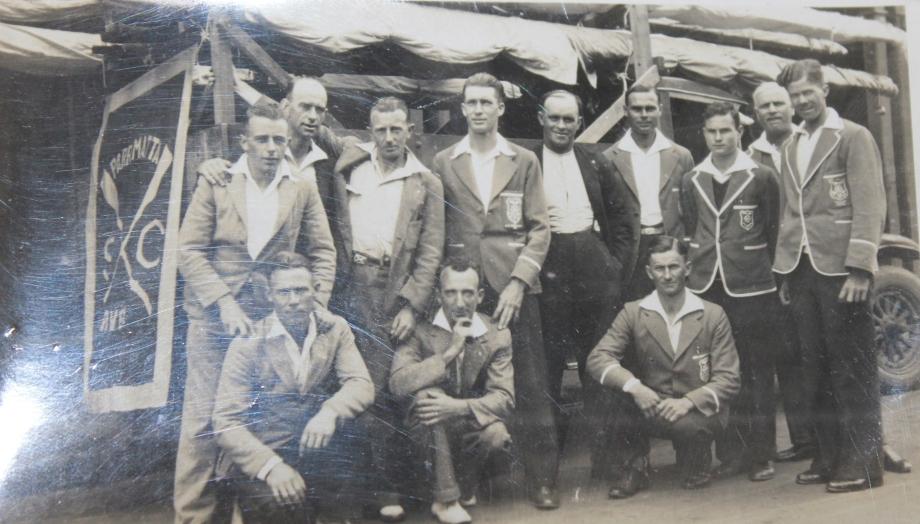
PAC Rowing Crew - circa 1930-1935
CECIL WILLIAMS of Bayview, Pittwater, who is the secretary of the Professional Scullers' Association, is confident that the 'cash outriggers' will enjoy a profitable season. The next race is on October 8. SNAPS AT SPORTS. (1932, September 11). Truth (Sydney, NSW : 1894 - 1954), p. 6. Retrieved from http://nla.gov.au/nla.news-article169135250
PRO. sculling looks like regaining pre-war popularity with ex-world's champion George Towns as president, W. T. Paddon as chairman and Cedric Williams, of Pittwater, as secretary. WILL- George Towns, Jnr.. develop into a sculler as great as his father? He has his maiden race at Pittwater next Saturday and has been allowed 58secs, start. SNAPS AT SPORTS . (1932, October 2). Truth(Sydney, NSW : 1894 - 1954), p. 6. Retrieved from http://nla.gov.au/nla.news-article169141073
THE new professional Sculling Association is organising a sporting week for February. Cec Williams, of Pittwater. the secretary, says that there will be racing every day in the week, and the prize money will be £125. SNAPS AT SPORTS. (1932, November 27). Truth(Sydney, NSW : 1894 - 1954), p. 8. Retrieved from http://nla.gov.au/nla.news-article169136513
SCULLING. Pittwater Finals.
Finals of the men's best and best handicap and the women's Gladstone skiff championship will be rowed today on the Bayview course.
Entries and handicaps are:
Men's Single Sculls (best and best boats).-A. J Fisher (Drummoyne), scr.; C. Williams (Bayview)5s: J. Erickson (Newport). 33; G. Hanlen (Mona Vale), 40; F. Kerr (Narrabeen), 43; B. Paddon(Clareville). 45: G. Towns. Jun. (Gladesville). J Watson (Abbotsford), 65; W. Paddon (Clareville). 90.
Women's Gladstone Skiff Championship.-Misses Q. Smith. J. Neilson. M. Hickson. J. Gilroy.
In conjunction with these races a challenge race will be rowed between two veteran scullers, W. Paddon and W. Fisher in best and best boats over a course of one and a half miles .Twenty years have elapsed since these noted performers met, and no doubt the presence of their sons in competition against one another last Saturday Inspired old rivalry. Veteran George Towns has been Invited to start the race, which will be rowed under the control of the New South Wales Professional Bowing and
Sculling League.
The secretary of the league advises that Parramatta and Pittwater Clubs between them will be sending upwards to 20 scullers to compete In the Shoalhaven Rivers' regatta set down for New Year's Day. SCULLING. (1932, December 3). The Sydney Morning Herald(NSW : 1842 - 1954), p. 18. Retrieved from http://nla.gov.au/nla.news-article28030174
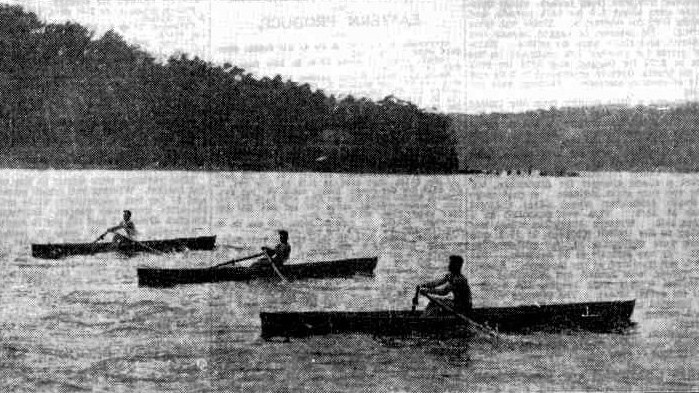
OPEN CHAMPIONSHIP FOR GLADSTONE SKIFFS. The start of the race to decide the New South Wales title at the Pittwater Aquatic Club's regatta. From left: M. Regan (2nd), C. Mudie (3rd), and J. Erickson (1st). OPEN CHAMPIONSHIP FOR GLADSTONE SKIFFS. (1933, February 18). The Sydney Morning Herald (NSW : 1842 - 1954), p. 16. Retrieved from http://nla.gov.au/nla.news-article28031440
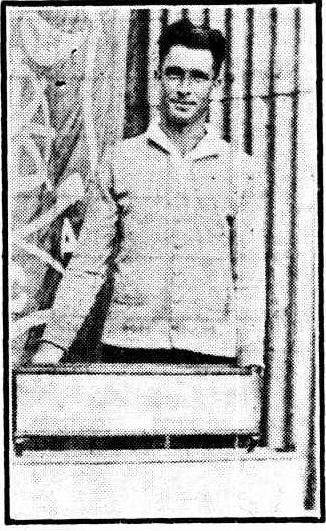 State Light Weight Champion. Cedric Williams, of Pittwater, who won the light weight championships in the Best and Best Boats also the Gladstone skiff races at Maclean on April 17 was a competitor at the Coraki regatta, and rowed second in the Beaten stakes handicap. The trophies shown are models, built to scale, one a Gladstone skiff, and the other an outrigger. Williams can hold the trophies won at Maclean for one year, after which, he has to compete again. State Light Weight Champion. (1933, April 29). Northern Star(Lismore, NSW : 1876 - 1954), p. 12. Retrieved from http://nla.gov.au/nla.news-article94213848
State Light Weight Champion. Cedric Williams, of Pittwater, who won the light weight championships in the Best and Best Boats also the Gladstone skiff races at Maclean on April 17 was a competitor at the Coraki regatta, and rowed second in the Beaten stakes handicap. The trophies shown are models, built to scale, one a Gladstone skiff, and the other an outrigger. Williams can hold the trophies won at Maclean for one year, after which, he has to compete again. State Light Weight Champion. (1933, April 29). Northern Star(Lismore, NSW : 1876 - 1954), p. 12. Retrieved from http://nla.gov.au/nla.news-article94213848
The noble Hawkesbury is particularly adapted for aquatic carnivals, and in the course of chatting with old residents I learned that regattas were held here annually over half a century ago, competitors coming from as far away at Maitland, on the Hunter, and even rivers much farther north. I feel confident that a really good programme for such an event would outrival the great Pittwater regatta of which the Sydney newspapers make so much every year. There is a stretch of water in the famous Hawkesbury on either side of the Windsor bridge which is unsurpassed for such a carnival, while the high ground on the reserve and the opposite banks, to say nothing of the bridge itself, would provide excellent points of vantage for thousands of sightseers. Wake up, young men of Windsor, and show the world that you can put up as brave a show as your forefathers did. SOME WINDSOR WANTS. (1933, January 6). Windsor and Richmond Gazette (NSW : 1888 - 1954), p. 7. Retrieved from http://nla.gov.au/nla.news-article86054303
REMARKABLE TROPHIES. Mr. K. Hanson, of Pittwater, manager of the visiting team of scullers and representatives of the N.S.W. Professional Sculling League, brought along with him for public display in Coraki two very remarkable models enclosed in handsome cases of polished wood and glass. It appears that there are five of these trophies which are to be competed for annually in the various regatta centres of .N.S.W.— one for the open Gladstone, another for heavy boats, a third for open best and best boats, a fourth for lightweight Gladstone, and the fifth lightweight best and best, and in each instance the model faithfully represents the type of boat used in the race for which the trophy is offered. The models are true to scale, and their construction evidently called for remarkable skill and the most meticulous care of an acknowledged master of the craft of boat building.
Mr. C. S. Murray, of Pittwater, designed and fashioned the whole of the models, and how he was able to give such an artistic finish while employing, timber of paper-like thinness baffles those able to realise the difficulties with which he was confronted. There is a 'fiver’, we are informed, for anyone who can detect even one missing detail. The outriggers, swivels, sliding seats, knees, rivets, sculls and every possible feature of each craft represented has been faithfully reproduced and on a scale so small as to be almost unbelievable. Large numbers viewed their display in the windows of the Premier and Federal Stores with great interest. Those trophies have to be won three, times in succession before becoming the absolute property of the winner. Present holders are— J. Erickson, open Gladstone and heavy boats; A.J. Fisher, open and best boats; and C. Williams, lightweight Gladstone and lightweight best and best. Williams obtained possession of his trophy at Maclean regatta only last week. The venue for the races is to be changed each year, and it is quite on the cards, we are informed, that Coraki will be favoured with the right to one or two of the events at its next annual regatta.REMARKABLE TROPHIES. (1933, April 25). The Richmond River Herald and Northern Districts Advertiser (NSW : 1886 - 1942), p. 4. Retrieved from http://nla.gov.au/nla.news-article127170543

One of the original Trophies. Picture by Michael Mannington, 2012. See - www.pittwateronlinenews.com/pittwater-aquatic-club-history-i.php
CORAKI REGATTA DREW LARGE CROWD .SOME CLOSE FINISHES. CORAKI, Monday. Saturday's regatta, organised by the Richmond River Aquatic Club, attracted scullers from Pittwater, Abbotsford, Port Macquarie, and towns on the Clarence and Richmond. Events commenced at 10a.m., and continued till dusk.
The heats and the finals were well contested, and old followers of the sport stated that the Beaten Stakes Handicap was the finest race witnessed. In that event Casey, the first man,, was only a few feet in front of Williams, and at the line a boat's length would have covered the distance between the seven scullers. E. Hilan (Ballina) won the £17 All Comers' Best and Best Boats handicap. The Beaten Stakes Handicap was won by T. Casey (Swan Bay), with C. Williams (Pittwater) second. Messrs. Yeager Bros. (Coraki) annexed thetrophy for speed boats, and D. Mcpherson (Swan Bay) secured second place. The attendance of spectators, although nothing like the numbers of past years, was considered by the club officials as satisfactory for a first regatta after several years.
The judges were Messrs. F. Ford and J. Paddon. Messrs. J. Butler and H. C.McNamara attended to the handicapping, and W. Benaud, as secretary, with the assistance of a strong committee,attended to the general management.
CORAKI REGATTA DREW LARGE CROWD. (1933, April 25).Northern Star (Lismore, NSW : 1876 - 1954), p. 6. Retrieved fromhttp://nla.gov.au/nla.news-article94213431
In this article, which also came with a picture, you can see some of the Pittwater rowers including Cedric M, back row, second from left:
SCULLERS ON TOUR
The new Rowing and Sculling League formed recently in Sydney has already commenced to make itself a big factor in the future conduct of rowing in this State. Its most recent effort was to send a team to tour the North Coast during the Easter just passed. This band- of rowers was a very representative team containing rowers from Pittwater, Parramatta and other clubs. It included men such as C. Williams (lightweight best and best champion of New South Wales), J. Erickson (Gladstone skiff and heavy boat champion of New South Wales), J. Watson (secretary of Parramatta Club), G. Towns, junr., and V. Fox.
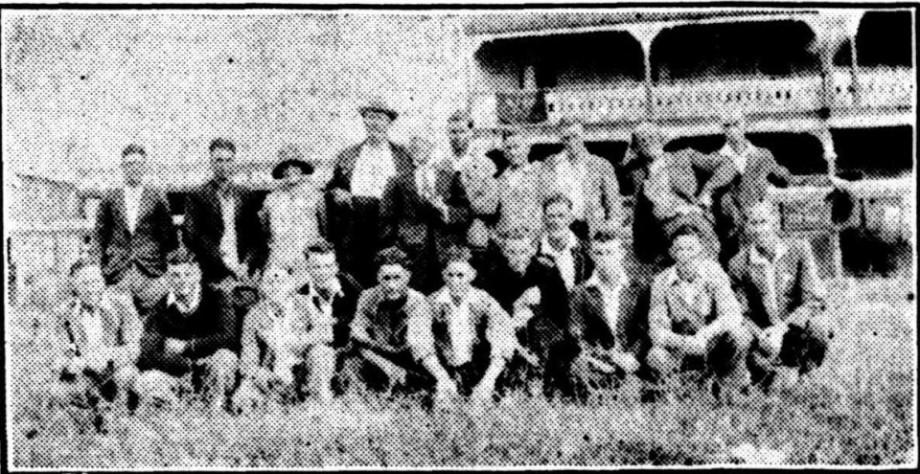
Group of scullers at Woodburn including the visiting rowers, Mr. Jim Paddon (ex-world's champion), Mrs. J. Paddon, Mr. P. S. Malone (president of the Woodburn Club), Mr. Hanson (manager of the visiting team), J.Watson (secretary of the Parramatta Club), and Mr. Fox, trainer, (one of the visiting team).
In an interview with a "Northern Star" representative, Mr. K. Hanson, the manager of the team, said that they had had a very good time so far end' we are glad to see that rowing was so well forward on the North Coast.Mr. Hanson and the team left Sydney on April 5 in very wet weather. They had travelled by. motor lorry and carried their boats with them. They arrived at Jerseyville on April 8 and had a practice row there.
AT MACLEAN
Maclean was their next stop to which place they came in easy stages, where Mr. Hanson says they received a very fine welcome. The members were in plenty of time to go oyer the course and accustom themselves tolocal, conditions.
All the visiting rowers were glad to meet . Mr. James Paddon, who came into town during the afternoon to meet the visitors.
OBJECTS OF LEAGUE
Mr. Hanson stressed the point that this team was sent out by the New South Wales Professional Rowing and Sculling League. That league was purely a body formed from affiliated clubs , to control championships and matters pertaining thereto over the whole. State and in no way –interferes in the domestic matters of the clubs of which it is formed. The area covered by the League so far extends from the North Coast as far South as the Shoalhaven River.
Next year Mr. Hanson hopes that with the affiliation of the Richmond and Clarence Rivers Clubs with the League, one of the major championships will be rowed on the North Coast. Wherever this big event will be held the clubs and the.public in general could rest assured that all the champions, together with remainder of the best rowers in the State, will compete.
Last s February the Pittwater Club distributed over £100 in cash as well as trophies to the same value and Mr. Hanson stated that if any of the Far North rowers go down to compete in those races next year they will be very well looked after and will have the satisfaction of "knowing that they are competing against the very best men in the State.
RESULTS
The results of the Woodburn events were : Handicap (three quarters mile).: First heat, J. Erickson (scr.) 1 ; other starters, J. Watson 14 sees., G. Towns junr. 20,' G. Gifford 28, F. Leighton 26. Time 5 mina.57 sees. Second heat : Starters, P. Howard2 sees., B. Paddon 10, C. Williams 4. T. Loader 35, F. Day 35. Won by C. Williams in 5 mins. 30 secs. Third heat : starters, T. Norton 11 sees., P. Malone 40, W. Levett40, L. Everingham 38. Won by Everingham in 5 mins. 52 sees. Final : Won by Williams with Erickson second and Everingham third. Time 6 mins. 35 3-5 sees. SCULLERS ON TOUR. (1933, April 25). Northern Star(Lismore, NSW : 1876 - 1954), p. 7. Retrieved from http://nla.gov.au/nla.news-article94213448
PADDON WINS AGAIN. B. Paddon, a nephew of the former world's champion, Jim Paddon, of the Richmond River, proved himself one of the best of the middle-markers, sculling with the Pittwater Aquatic Club. On the Bayview course yesterday he won the mile and a half handicap, defeating the long marker, V. Cox, by three feet. Lightweight champion Cedric Williams, rowing from scratch, put up an excellent showing to gain third place. Results: PITTWATER AQUATIC CLUB. Women's Gladstone Skiffs, 1-mile.— First heat: J. Cox, 52eec, 1; J. Gilroy, scr., 2. Won by li lengths. Second heat: M. Riddle, 20sec, 1; J. Nllsen. Bsec, 2. Won by 2 lengths.Final: J. Cox, 1; M. Riddle, 2; J. Gilroy, 3.Won by 3 lengths, with 2 lengths between second and third. Best and Best Outriggers, 1 ½ mile.— B. Paddon, 30sec, 1; V. Fox, 42sec, 2; C. William, scr., 3. Won by 3 feet; 11 lengths between second and third. BROTHERS FIGHT FINISH. (1933, October 1). Truth (Sydney, NSW : 1894 - 1954), p. 8. Retrieved from http://nla.gov.au/nla.news-article169306933
The visit was returned and the Cedric Williams is shown to have much of his family's 'welcome all' ethos:
Shoalhaven Rowing Club: TRIP TO PITTWATER, REGATTA (By one-of the Party). - .
Shoalhaven rowers on Thursday morning last possessed remarkable optimism when a portion of them left Pyree in blinding rain, accompanied, 'by a gale from the east, at about 5.30a.m., to pick up the balance in Nowra to catch the 6.55, a.m. train. When the party assembled it included Messrs. H. Haiser (representing the Shoalhaven Club), H. Regan, G. Campbell. Tom Peel, Frank Evan (rowers), with Artie Smith as manager. Shortly after passing Wollongong both the rain and wind eased, and it was thought a break was imminent; when the central was reached the weather was fine; . Upon stepping from the train 'Blue' Jones (one-time of Nowra) was waiting for a party, and anxiously inquired where the Shoalhavenites were bound for. Shortly-after lunch rain again came down in torrents. The ferry was taken for Manly. Proceeding down the harbor, the coastal steamer Cobargo was met, carrying live stock, and it was evident the ship had had a bad time in the gale, by the number of dead pigs that were visible on the deck. Arriving at Manly it was still raining and blowing, making things most unpleasant. Two of the party considered it wise to purchase an umbrella each, 'which may frighten' the weather. Others of the party wanted some training oil, and a chemist's shop was entered. Several questions were exchanged, and the chemist inquired did any of the party know his uncle, Mr. Jack Fraser, late Town Clerk of Nowra. Being a little ahead of schedule time, we had to wait a few minutes, but eventually Mr. C. Williams, secretary of Pittwater Club, arrived in his car and conveyed the party to Pittwater a distance of about 12 miles, passing through such towns as Dee Why, Narrabeen, Collaroy, Mona Vale; etc. Being in close proximity to the ocean, the rain and wind was very fierce. Duly arriving at Pittwater about 3.15 p.m. we were made very comfortable at Mrs. Jones' and Mrs. McFee's boarding house. Mrs.McFee was not known by any of the party, but in the course of conversation it was learnt that Mrs. McFee had last year lost her husband, Mr. Sam McFee, who was a native of Pyree and a personal friend of Mr. Harry Haiser.
After receiving the good wishes of Mrs. Jones and Mrs. McFee, accompanied with the very acceptable cup of tea, the rowers were very anxious despite the extremely boisterous conditions, to try their hands in the Gladstone skiffs. Although this class of skiff was strange to the Shoalhaven rowers, the boys nevertheless were very high in their praise for this kind of boat, and thought Shoalhaven Club should make an effort to purchase a similar class of skiff. An outing had been arranged by the Pittwater Club to take our party around Broken Bay in a 40-mile-per hour speed-boat, but owing to the poor visibility caused through the boisterous conditions the outing was abandoned. Pittwater regatta takes place in Broken Bay and places of note in close proximity re Bay view, Newport and Church Point; also a branch of the Sydney Royal Motor Yacht Club.
In the distance are the Hawkesbury River heads, Barrenjoey lighthouse, Lion Island, and Palm Beach; further in the distance lies Gosford. Within 1 ½ miles radius from where the regatta eventuates lies a fleet of mostly pleasure launches, approximately 150 in number, which makes the scene most picturesque. Mr. C. Williams, with his father and brother, carry on a boat-building business, which discloses good enterprise. Mr. Williams, sen., by the way, was in the days of old a diver in the pearling industry, and was listened to intensely when relating his narratives. Mr. Williams does not care to discuss steamers or motor launches; he prefers sailing vessels. After tea on Thursday night Mr.Artie Smith telephoned home and learnt that the Shoalhaven was in flood, (but the party was relieved to know that the storm was abating. At daylight on Friday morning the weather was beautifully fine and it was considered the purchasing of the umbrellas at Manly had been a wise decision. The party were very keen for regatta operations.
Although Shoalhaven rowers' could not win any Gladstone skiff heats, they put up a good showing. Jack Erickson, who had taken the championship last year in heavy boats, managed to retain his title after a great race! Harry Regan in his'heat in the heavy boats put up a great race on Friday, and was first to reach the-judge; on Saturday Harry ran four than the final, but put up a good showing,- having concede' too much handicap. In the doubles in heavy boats Harry Regan and Frank Ryan pulled well to gain -second place in their heat, and also put up a good performance in the final, having to concede Paddon and Fox, who ultimately won by 6 seconds. They ran a great second. There were six competitors. About 3.30 p.m. on Friday there was every appearance of a big storm, but only a few drops of rain fell. In the outrigger consolation race, of11 starters, Parramtta and Pittwater rowers showed true sportsmanship to Shoalhaven. E. Cowell, of Parramatta, lent his outrigger to F. Ryan, and C. Williams lent his outrigger to Tom Peel. - Ryan won this event from Elgood, of Parramatta, with Peel a good fourth.
Bert Paddon did well at the regatta, winning the Sam Bowen cup, doubles with Vin Fox, and mixed doubles with Miss Marshall. W. Fisher, sen., won the Gladstone skiff singles. M. Price, C. Mudie, and J. Hanlon won the outrigger races. There were big fields in both the ladies' and boys' events. Mr. A. .Smith was the representative of the. N.S.W. Professional Sculling and Rowing League, and followed the races in the umpire's launch belonging to Mr. Todd of Circular Quay, who kindly lent his launch for the occasion, which was capable of doing 18 miles per hour. Mr. Fox was umpire, and is well known to Shoalhaven rowers; Mr. W. Paddon was starter. Messrs. Haier and Smith were extended official badges for the regatta.
On Saturday night, when the prize money was being handed over at the Pittwater ball, the duties were performed by Mr. and Mrs. Penniman, vice-presidents of the club, in the absence of the club's president, Sir Clifton Love. President Austin, of Warringah Shire, acted as chairman, and was accompanied by Mrs. Austin and Mr. Artie Smith on the stage. Mr. Smith took the opportunity of extending Shoalhaven 's appreciation to Pittwater and Parramatta rowers for the grand sportsmanship that had been shown to Shoalhaven representatives throughout the regatta, and the wonderful assistance rendered to them by Mr. Williams, the Pittwater secretary. The speaker also referred to the fact that the club was very fortunate in having a course that was not the least affected by the rain, which would not have been the case in Shoalhaven owing to the flooded condition.
At 7 o'clock on Sunday morning the party left Mrs. Jones' and Mrs. McFee 's boarding house (which had been a home away from home) for Manly, per Mr. C. Williams' car, which was extended both ways with the Pittwater Club's compliments to Shoalhaven. The trip on Sunday morning was in marked contrast to that of Thursday, and was a beautiful drive. The party duly arrived home at midday on Sunday, and unanimously voted the trip to Pittwater a glorious event. Shoalhaven Rowing Club. (1934, February 28). The Shoalhaven Telegraph (NSW : 1879 - 1937), p. 1. Retrieved from http://nla.gov.au/nla.news-article121627299
CLAREVILLE REGATTA
Men and women from the Parramatta and Pittwater Clubs will compete In a series of races. In best and best boats Gladstone skills and heavy boats at the Clareville picnic regatta to-day held under the auspices of the Pittwater Aquatic Club. The races will finish off Clareville Beach, Broken Bay racing commencing at 10 am. SCULLING. (1934, October 1). The Sydney Morning Herald(NSW : 1842 - 1954), p. 9. Retrieved from http://nla.gov.au/nla.news-article17130923
SCULLING. TOPPLED THE CHAMP Kerr Creates Surprise
FRED KERR proved himself one of the most improved professional scullers on the Pittwater course yesterday. He sculled a perfect race to defeat the lightweight champion, Cedric Williams, by two lengths. Bayview won the Pittwater Cup in the relay, while the previous holders, Clareville, gave a poor display to finish last. Miss J. Gilroy, the Pittwater champion, rowed one of the greatest races of her career. She conceded some long starts over half a mile, and emerged victorious by a length and a half from Miss Riddle.
PITTWATER AQUATIC CLUB
Outriggers. Best and Best, 11 Miles: F. Kerr,30sec., I; C. Williams, scr., 2; B. Paddon. 23scc., 3; C. Mudie, 38sec., 4. Won by two lengths; eight lengths between second and third. Women's Gladstone Skiffs: Miss J. Gilroy. scr., 1; Miss M. Riddle, 20sec., 2; Miss J. Nilsen, llsec., 3. Won by a length and a half; quarter of a length between second and third. Relay Race for Pittwater Cup: Bayview - F Kerr, C. Williams and B. Hickson, 1; Newport -H. Erickson. T. Erickson, C. Mudie). 2. Clareville, the holders, were last. Won by two lengths. SCULLING. (1933, December 24). Truth (Sydney, NSW : 1894 - 1954), p. 7. Retrieved from http://nla.gov.au/nla.news-article169306091
PITTWATER AQUATIC CLUB The fourth annual regatta of the Pittwater Club will be held on Saturday afternoon. The chief event will be the Professional Lightweight Champion Sculls for best-and-best sculling boats. Cedric Williams, who won the Gladstone skiff championship recently,- is the title-holder, and will have as his only opponent F. Kerr, of Pittwater. Williams should retain the title. POLICE-MOSMAN DEAD-HEAT TWICE. (1935, March 21 - Thursday).Referee (Sydney, NSW : 1886 - 1939), p. 14. Retrieved from http://nla.gov.au/nla.news-article135513171
SCULLING -BANG WENT THE RECORDS
CEDRIC WILLIAMS, the State Lightweight Professional Sculling Champion, is certainly an artist in a Gladstone skiffs, yesterday, at Pittwater, he lowered the ¾ mile record by 13secs., covering the distance in 5mins. 3 sees. Williams and V. Fox rowed a dead heat in the final. PITTWATER AQUATIC CLUB.Gladstone EMS Handicap (three-quarters ofl mile)— First Event: C. Williams, scr.. 1;B Paddon 7 sees., 2. Won by three-quarters of a length. Second Event: C. Wilson, 13sees., 1; F. Smith, 15 secs., 1. Won by a length. Third Event: V. Fox, 13 sees., 1; A. Fryer, 176ec. 2. Won by two feet. Final: V. Fox and C. Williams, a dead-heat at Bret; C. Wilson 3. Won by a quarter of a length. Williams 5min 3sec(record). SCULLING. (1935, January 13). Truth (Sydney, NSW : 1894 - 1954), p. 8. Retrieved from http://nla.gov.au/nla.news-article169345982
This apparent word skirmish reappeared 20 years later when Cedric was disallowed to represent Australia at the 1956 Olympics in sailing although his son Cedric V states the boat that won was one his father had built - reports of that time cited jealousy as the problem - more on that under Sailing and BYRA:
ROWING CHAMPION. Refused an Injunction. DISQUALIFICATION STANDS.
Mr. Justice Long Innes, in Chambers yesterday, refused an interim injunction to John William Erickson, holder of the rowing championship for Gladstone skiffs in New South Wales to restrain officials of the Pittwater Aquatic Club and the New South Wales Professional Sculling and Rowing League from disqualifying him as a member and from otherwise dealing with him except as a member of the club and of the league respectively
The purpose of the application was to put Erickson In the position of being able to row at the Pittwater regatta today and to compete in the race for the Gladstone skiff championship of New South Wales on the Shoalhaven River on New Years Day. The defendants to these proceedings were Sir Clifton Love and Cedric Williams, president and honorary manager respectively of the Pittwater Aquatic Club, and Mr George Towns and Cedric Williams, president and secretary and treasurer respectively of the New South Wales Professional Sculling and Rowing League
An affidavit by Erickson stated that he last rowed on May 7, 1933, at Pittwater, competing in a race for Gladstone skiffs, and finishing in second place. The defendant, Cedric Williams was also a competitor. After the lace, they had a dispute of a personal nature on the finishing line. Subsequently, Williams handed Erickson his prize-money and said, "You are disqualified for the way in which you spoke to me out there " That day Williams put up a notice on the club's premises at Bayview in the following terms, "I, Cedric Williams, do hereby disqualify J Erickson from the Pittwater Aquatic Club for 12 months " Erickson said he asked Williams to take the notice down which he did, but he put it up again on the same day
Erickson also said in his affidavit that Mr. Williams said, "You have been disqualified because you have been abusive to officials of the club" Erickson said he denied this. The two bodies disqualified him at meetings held subsequently.
His Honor, in refusing the injunction, said that perhaps Erickson had a good case, but the application had been brought too late, and he could not decide the matter ex parte The other side had been served very late on the previous afternoon. ROWING CHAMPION. (1934, December 29). The Sydney Morning Herald (NSW : 1842 - 1954), p. 12. Retrieved from http://nla.gov.au/nla.news-article17115574
IN EQUITY.
(Before Mr. Justice Davidson.)
ROWING CHAMPION.
It was announced that a settlement, on terms not to be disclosed had been reached In the application on behalf of John William Erickson, holder of the Gladstone skiff championship of New South Wales, for an injunction to restrain the officials of the Pittwater Aquatic Club and the N.S.W. Professional Sculling and Rowing League from his disqualification as a member, and from otherwise dealing with him, except as a member of the club and or the league respectively.
The defendants to the proceedings were Sir Clifford Love and Cedric Williams president and honorary manager, respectively, of the Pittwater Aquatic Club, and Mr. George Towns and Cedric Williams, president and secretary and treasurer, respectively, of the N.S.W. Professional Sculling and Rowing League.
The matter arose out of an incident at Pittwater, when Erickson, who was competing in a race for Gladstone skiffs, finished in second place. The defendant. Williams was also a competitor. After the race they had a personal dispute on the finishing line. Subsequently a notice was posted on the club's premises at Bayview that Williams had disqualified Erickson from the Pittwater Aquatic Club for 12 months. The notice was taken down at, Erickson's request, but it was replaced the same day, Ericsson's affidavit stated that Williams had told him he had been disqualified because he had been abusive to the officials of the club. Erickson denied this. Mr. R. W. Keegan (Instructed by Mr. Warrington Connolly) appeared for the applicant; and Mr. David Wilson (instructed by Messrs. D. I,, Aitken and Barron) for the respondents. IN EQUITY. (1935, January 18). The Sydney Morning Herald(NSW : 1842 - 1954), p. 6. Retrieved fromhttp://nla.gov.au/nla.news-article17142100
It didn't change the fact that Cedric M was champion and defended his championship a few weeks later and a few weeks after that decided to give that aspect of rowing away - made his point, walked away:
ROWING. CINCH FOR CED. Lightweight Title To Williams
CEDRIC WILLIAMS of Pittwater’ is still the lightweight sculling champion of N.S.W. in Gladstone skiffs. For the third consecutive year he has retained the title, and his performance on the Parramatta River yesterday was a meritorious achievement. Though beaten in the handicap sculls Max Fisher rowed, a splendid race in the outrigger. He allowed the winner, 3. Hanlon, 58 seconds, and at the finish was only a length behind in second place. Lightweight Sculling Championship of New South Wales, In Gladstone Skiffs: Cedric Williams (Pittwater). I; F. Kerr (Pittwater), 2.Won by three lengths. Gladstone Skiff Handicap, for Women. D. Pamplin (Parramatta), 1; D. Hammond (Parramatta), 2; M. Hickson (Pittwater), 3. Won by four lengths. Handicap Sculls: J. Hanlon (Pittwater), 1;A. M. Fisher (Parramatta), 2; V. Fox (Pittwater), 3. Won by a length. Relay Race: Pittwater (B. Paddon, B. Hickson, V. Fox, and C. Williams) defeated Parramatta River by two lengths. ROWING. (1935, March 10). Truth (Sydney, NSW : 1894 - 1954), p. 7. Retrieved from http://nla.gov.au/nla.news-article169339696
SCULLING. Parramatta River Club. CHAMPIONSHIP REGATTA.
The Parramatta River Sculling Club held Its championship regatta over the Putney-Gladesville course on the Parramatta River on Saturday.The main attraction on the programme, the light-weight Gladstone skiff championship of New South Wales, was won for the third successive year by Cedric Williams, of Pittwater, who defeated his clubmate, F. Kerr, by three lengths. J. Hanlan, Pittwater, won the outrigger handicap, and the skiff handicap Results:
Lightweight championship of New South Wales, In Gladstone skills, 1 m (holder, C. Williams); C.M. Williams (Pittwater), 1; F. Kerr (Pittwater), 2.Only starters. Won by three lengths.
Women's Gladstone skiff handicap, lm.: Miss D.Pamplin (Parramatta), 52s, 1; Miss D. Hammond(Parramatta), 38s, 2; Miss M. Hickson (Pittwater),16s, 3. Won by four lengths. SCULLING. (1935, March 11). The Sydney Morning Herald(NSW : 1842 - 1954), p. 13. Retrieved from http://nla.gov.au/nla.news-article17172714
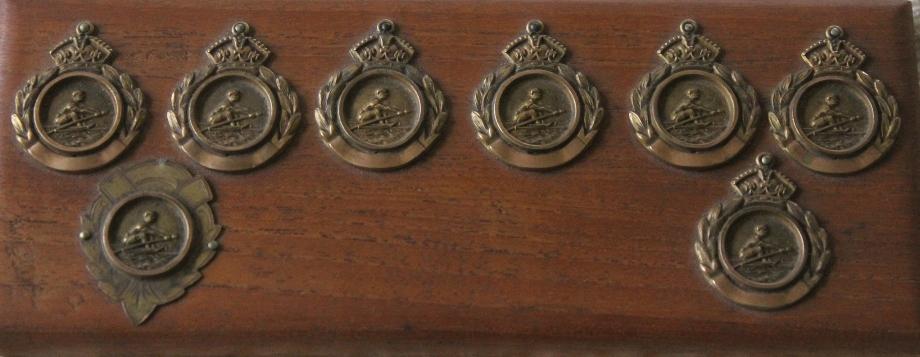
Some of the medals Cedric M won - courtesy of Cedric V
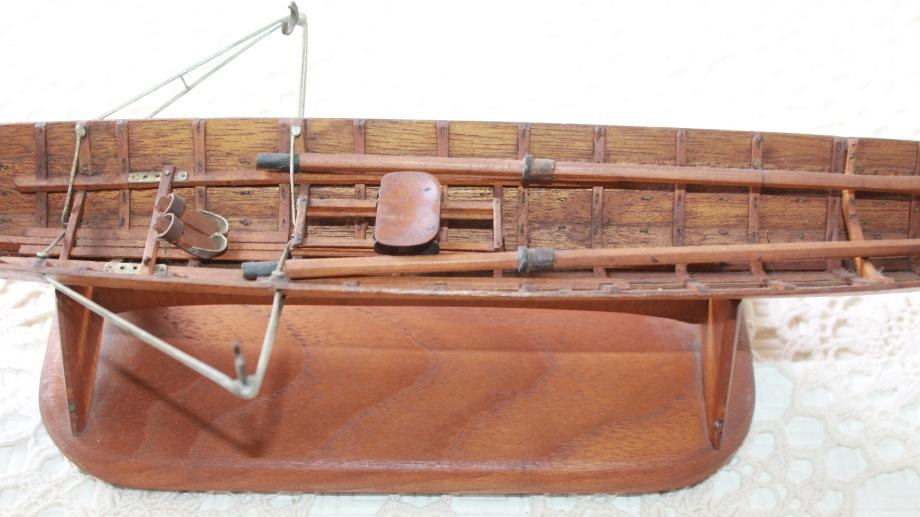
A model Cedric M built of a Gladstone Skiff - courtesy of Cedric V Williams
SCULLING. PITTWATER CLUB. LIGHTWEIGHT TITLES
At the last meeting of the New South Wales ...Sculling League. Cedric Williams Pittwater, handed in the titles he held of lightweight champion sculler and lightweight Gladstone skiff champion of New South Wales. Williams has been the outstanding lightweight sculler in the state for quite a few years and his retirement from the lightweight division should create greater Interest in these championships. SCULLING. (1935, April 9). The Sydney Morning Herald (NSW : 1842 - 1954), p. 17. Retrieved from http://nla.gov.au/nla.news-article17164544
He didn't stop rowing in local events though or organising for things to get better by affiliating the club with NSW Rowing Association and securing coach as well as funds from then Warringah Shire Council towards a clubhouse:
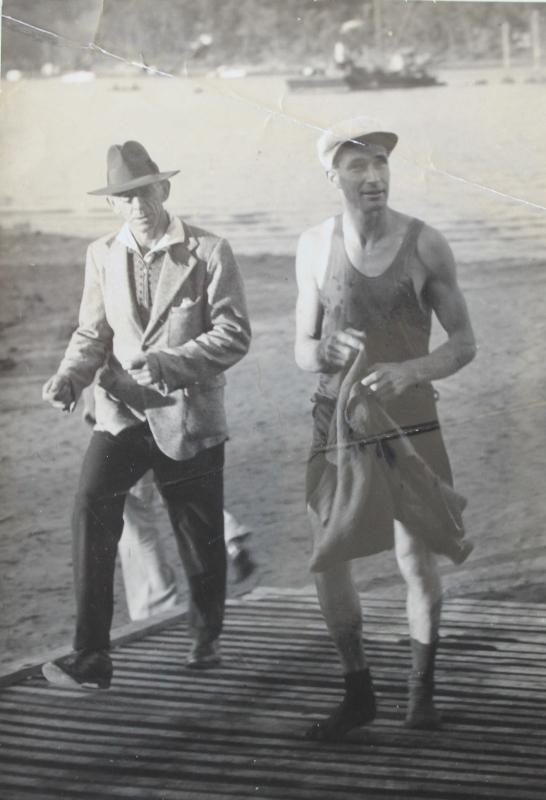 PITTWATER CLUB'S REGATTA
PITTWATER CLUB'S REGATTA
The Pittwater Aquatic Club’s first regatta under the control of the New South Wales Rowing Association will be held at Bayview on Monday. The club is now affiliated and for Its first main series will enter crews In four oar and sculling races only. It has secured Mr F Ballan as coach. He is an ex member of Drummoyne Rowing Club. The first crew heavyweight maiden fours comprised of the club’s scullers N Fox V Fox A Fryer and C Williams. The second crew are men from Deewhy F Moore J Trim R Bonser and M Moore.
The racing will start at 10 am when heats of the sculling races will be held and the main racing at 3 p m The club has recently purchased two eight-oar boats and will commence training for senior events early in the new year.A new club-house is being erected at Bayview.ROWING. (1936, October 3). The Sydney Morning Herald(NSW : 1842 - 1954), p. 21. Retrieved fromhttp://nla.gov.au/nla.news-article17286978
Right: Right: Cedric M Williams as rower circa 1930 (Older gentleman used to help with rowing - possibly F Ballan)
PITTWATER CLUB: Triangular contest in fours for the Fox-Williams trophies at Bayview to-day. Handicaps: Men's single sculls, for P. Salmon Cup, C. Williams, scratch; N. Fox, 8s; V. Fox, los;B. Hickson, 20s; F. Smith, 40s. John Williams Gladstone skiff handicap IB class): G. Leach, scr;P. Aldridge, 2s; T. Shepherd, 4s: H. Shepherd,4s; M. Hickson, 6s; B. McFee, 45s; C. Hickson,48s. ROWING. (1936, October 17). The Sydney Morning Herald(NSW : 1842 - 1954), p. 22. Retrieved from http://nla.gov.au/nla.news-article17289491
WILLIAMS VERSATILE
CEDRIC WILLIAMS at Bayview, Broken Bay, yesterday won the big double. After winning the sculling race over a mile from scratch he stroked the lightweight four-oar crew to victory in a race with a heavyweight quartette. PITTWATER AQCATIC CLUB Scullers Best and Best Handicap: Cedric Williams(scr.). 1; V. Fox (15sec), 2; N. Fox (15sec),3. Length and a half. Four-oar Race—Lightweights: L. Moore bow, H. Hickson F. Smith. C. Williams stroke, B. McFee 'con, beat heavyweight crew by a length and a half. B. Class Gladstone Skins: G. Leach senr., beat H. shepherd (11) by two lengths and a half; T. shepherd (91 beat M. Hickson(12) by a length and a half. Final: o. Leach 1, M. Hictaon 2, H. Shepherd 3. Two lengths.WILLIAMS VERSATILE. (1937, January 24). Truth (Sydney, NSW : 1894 - 1954), p. 7. Retrieved from http://nla.gov.au/nla.news-article169605869
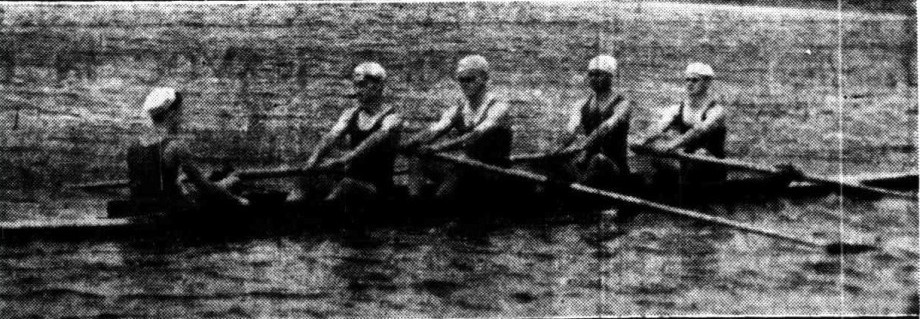
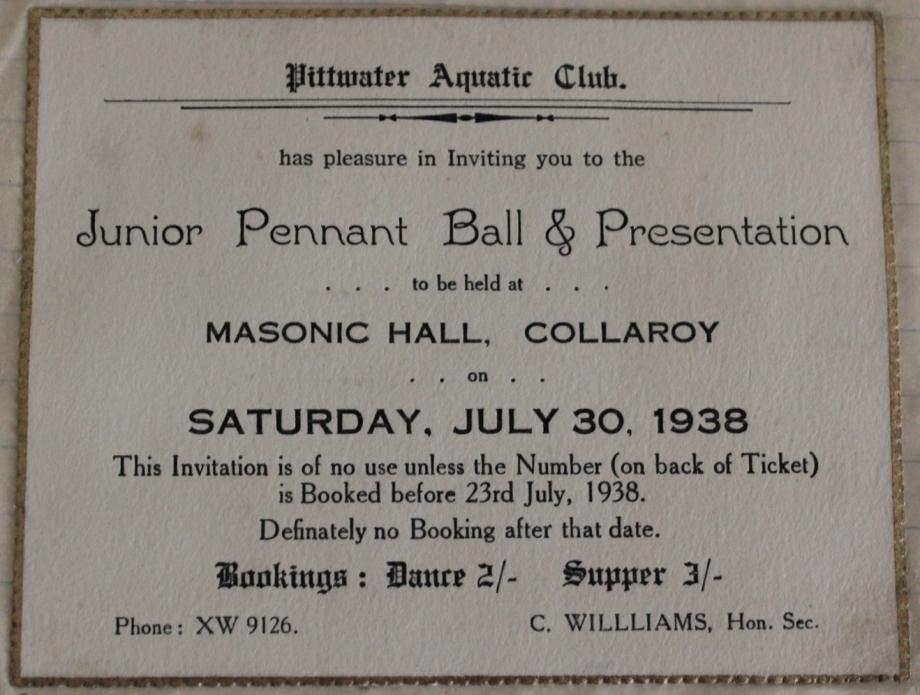
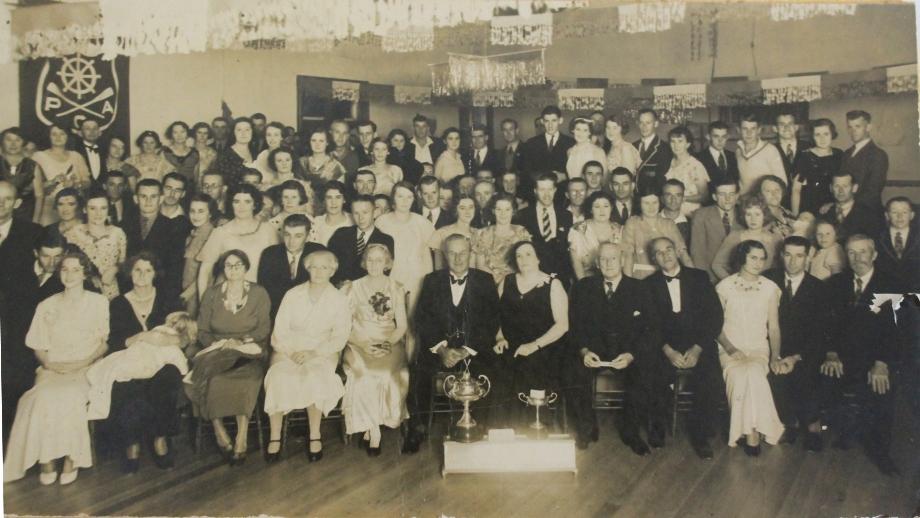
 The other item of interest regarding Cedric M Williams was his friendship with Captain P G 'Bill' Taylor (later Sir) - they went flying together and the first seaplane of sorts that Sir Taylor flew was flown from Bayview. See: The Man Who Saved Smithy - Fighter pilot, pioneer aviator, hero: the life of Sir Gordon Taylor MC, GC by Rick Searle - a few insights from the biographer of this new Allen&Unwin book on a local hero - and make you wonder if there were a few Williams hands helping those floats float!
The other item of interest regarding Cedric M Williams was his friendship with Captain P G 'Bill' Taylor (later Sir) - they went flying together and the first seaplane of sorts that Sir Taylor flew was flown from Bayview. See: The Man Who Saved Smithy - Fighter pilot, pioneer aviator, hero: the life of Sir Gordon Taylor MC, GC by Rick Searle - a few insights from the biographer of this new Allen&Unwin book on a local hero - and make you wonder if there were a few Williams hands helping those floats float!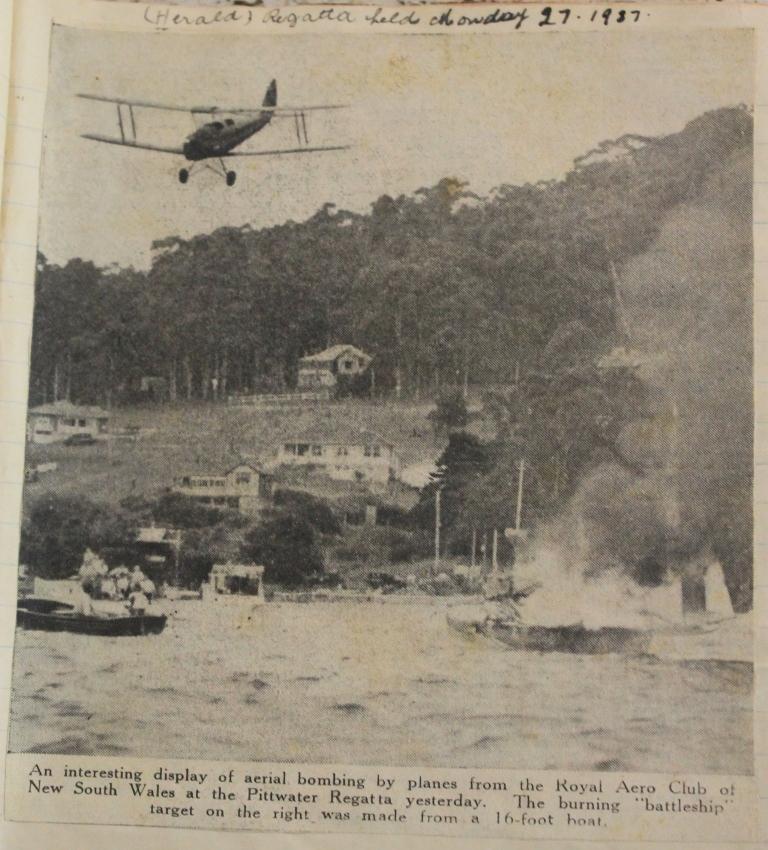
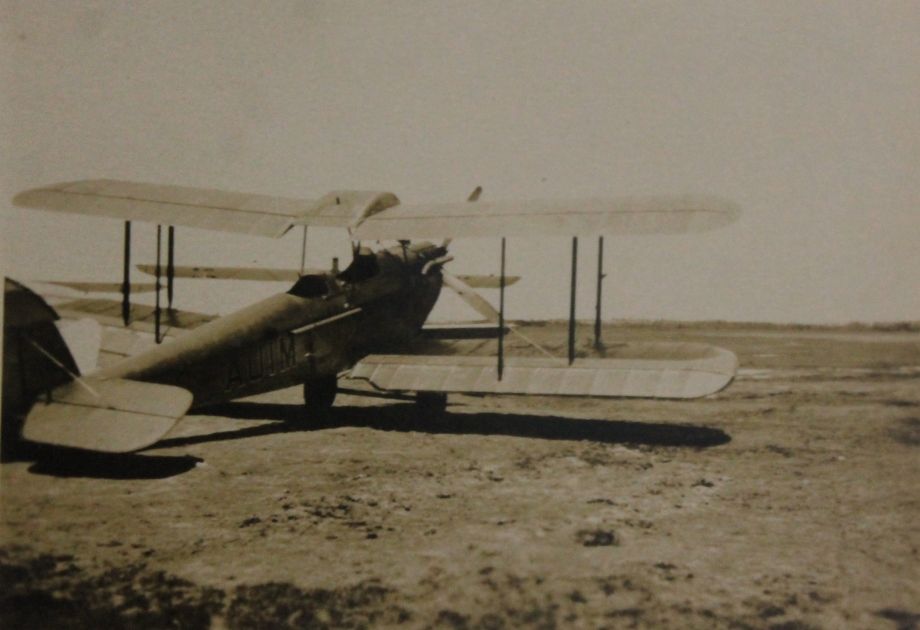
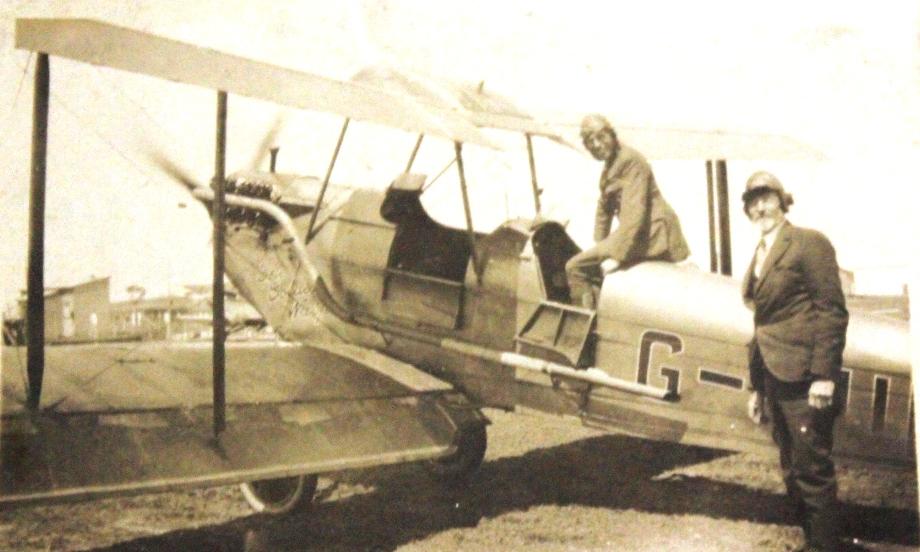
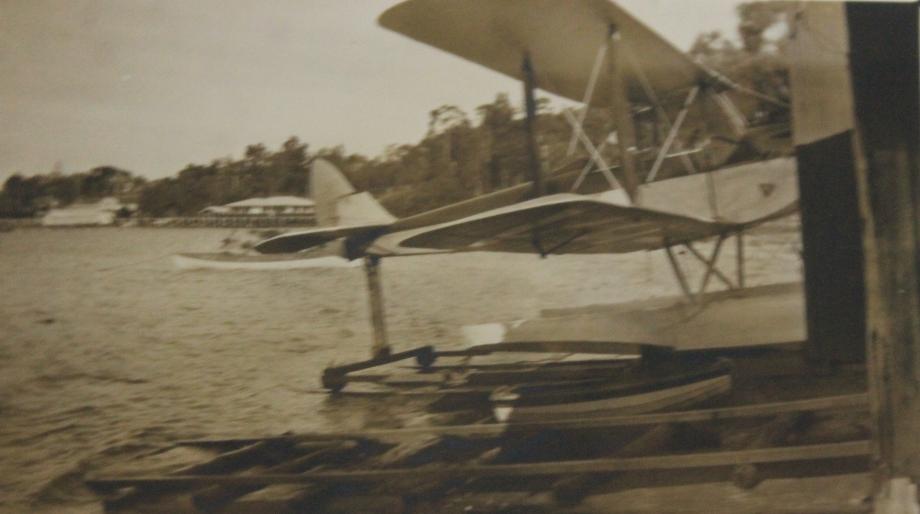
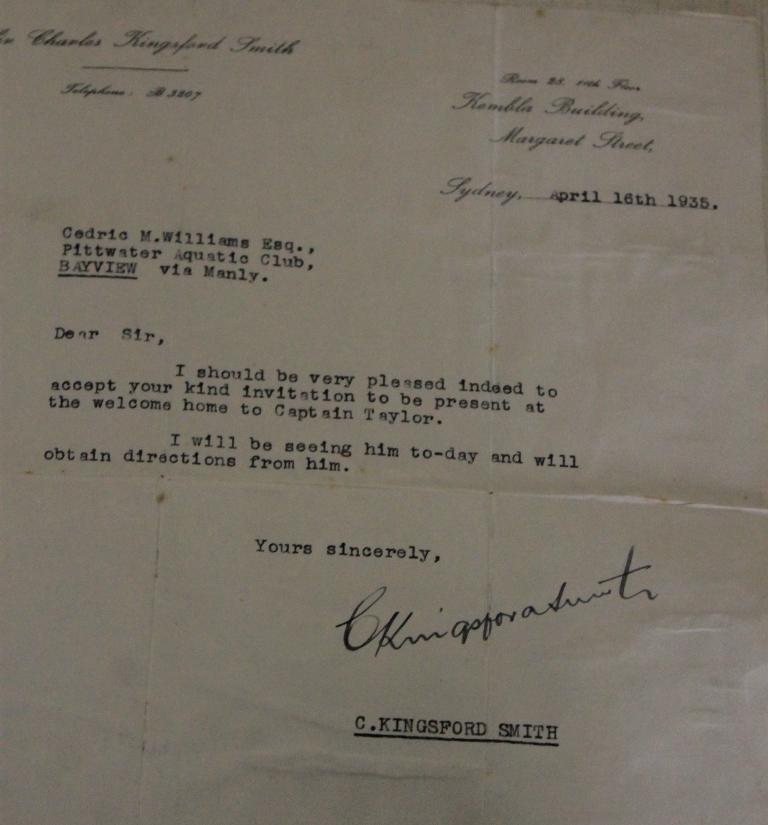
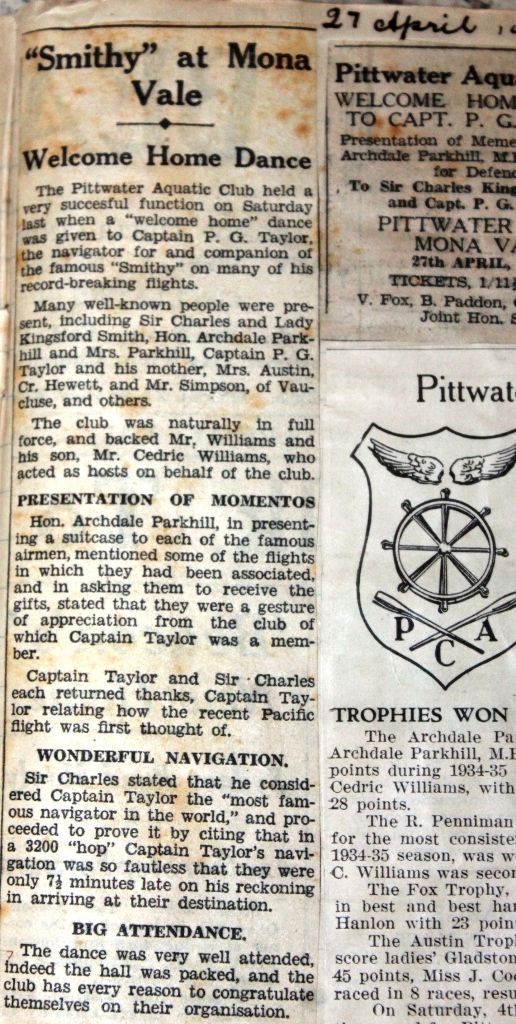
"He started sailing, and racing in sailing – that’s how BYRA started.
There was a race between the people who used to sit at his bench in the boatshed and one day when K C Dalton came down – they would always give him a hard time – he said ‘I’ve got my boat out there and it’s good – if you want to race that’
Dad said ‘I’ll race you around Lion Island’.
I was 11, it was November, and the race was on a Wednesday – the whole of this area had closed down. We raced around Lion Island and my father won quite easily. We had only one sailing chap in it – all the rest were old scullers.
K C Dalton had his crew, and my uncle Jack, he was actually John Williams but everyone called him ‘Jack’, went with him, but all the rest were these old guys that would sit down at the wharf all the time.
So that’s how BYRA started, through that race. That was November 1949. They started racing the big boats to begin with, on a Sunday. They bought the boatshed, which is still standing in the same place now but it was only a little boatshed then, two storeys, and they built BYRA out of that."
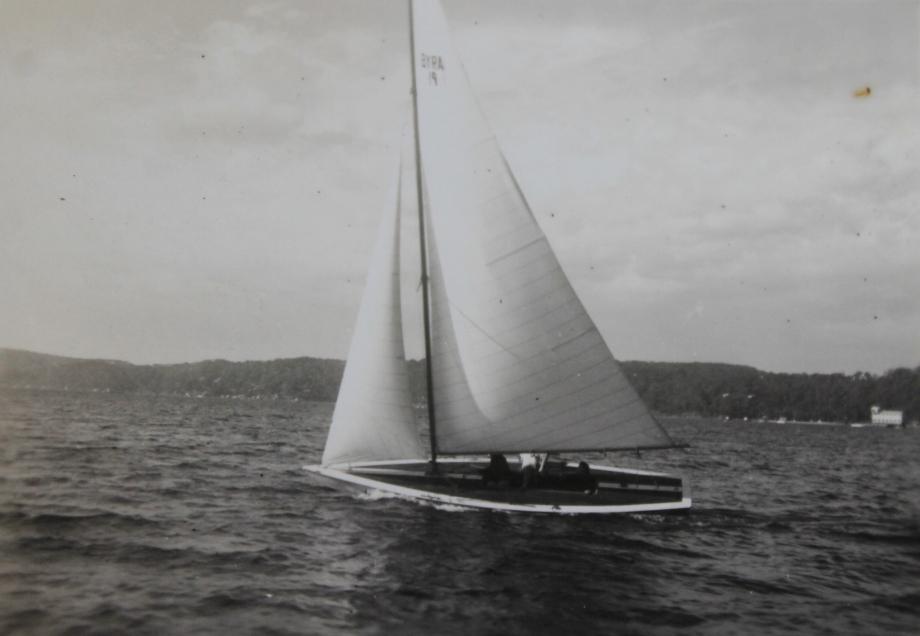
Cedric M Williams, Sailing on Pittwater in early BYRA boat.
It was next door to Riddles – you had the Riddles boatshed, then some rubbish, then this little boatshed. The Riddle sisters were still living there at that stage but they weren’t still running the shop then. Darkie Griffin had the boatshed a bit further around, my father had the one at Bayview and then Baker bought the shop from Cowells and then he too started going into the boat industry.
My father, being a boat builder in the area, knew all the older people in the area, all of whom would come to the boatshed everyday. There was nowhere else to go. They used to sit down on the wharf or at this bench he had there, he couldn’t work half the time because they were always there.
My father was a very precise man, who didn’t drink or smoke, but had these people around him all the time, and I got to know them this way. He’d be working away, or trying to. This was a very old boatshed, with a timber roof – I’d get up in the roof and get timber from there as it as better than what I could buy. I’d cut bits of timber from there to build my boats with. It all fell down after a while and we built a new boatshed there.
In BYRA, after the big boats they developed the Star Class. From the Star Class it went to Dragons.
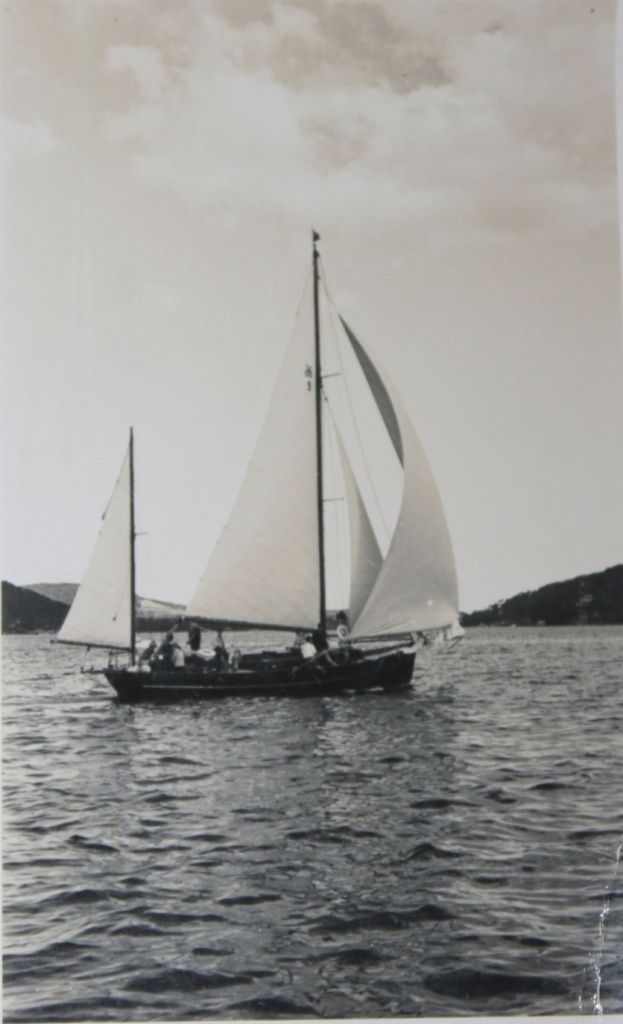
Cedric V's mother has written on back of this photo "First Race before BYRA Started - Cedric Williams Jnr.
The 1956 Olympic Games, Games of the XVI Olympiad, were held in Melbourne from 22 November to 8 December, Prince Philip, Duke of Edinburgh, opened them - the Athlete's Oath was given by John Landy, and Ron Clarke carried the Olympic Torch.
There were five classes in Sailing: Finn, 12 m2 Sharpie, Star, Dragon, and 5.5 Metre.
Until the 1970s, Olympic athletes could not accept endorsements or prizes, and professionals were not allowed to compete in the Games. Athletes who practiced professionally were considered to have an unfair advantage over those who played sports as a hobby. Amateur athletes relied on private sponsorship, such as family members and wealthy fans, to fund their training and pay living expenses.
The International Olympic Committee eliminated the necessity of amateurism in 1971, allowing athletes to receive compensation for time away from work during training and competition. In addition, athletes were permitted to receive sponsorship from national organizations, sports organizations, and private businesses for the first time. In 1986, professional athletes were given permission by the International Federation to compete in each sport of the Olympic Games. For instance, in the 1992 Olympic Games, the United States was allowed to field a basketball team comprised of well-paid NBA stars, called "The Dream Team."
In 1956 Cedric M Williams was the Australian Star class Champion - but it was accepting 'prizes' such as those shown above, that meant he could not represent his country, although family members state he dearly wanted to. It seems jealousy of such prowess was rearing its ugliest head again - from one of the premier Aquatics and Sports journalists of that time- a man known for his integrity:
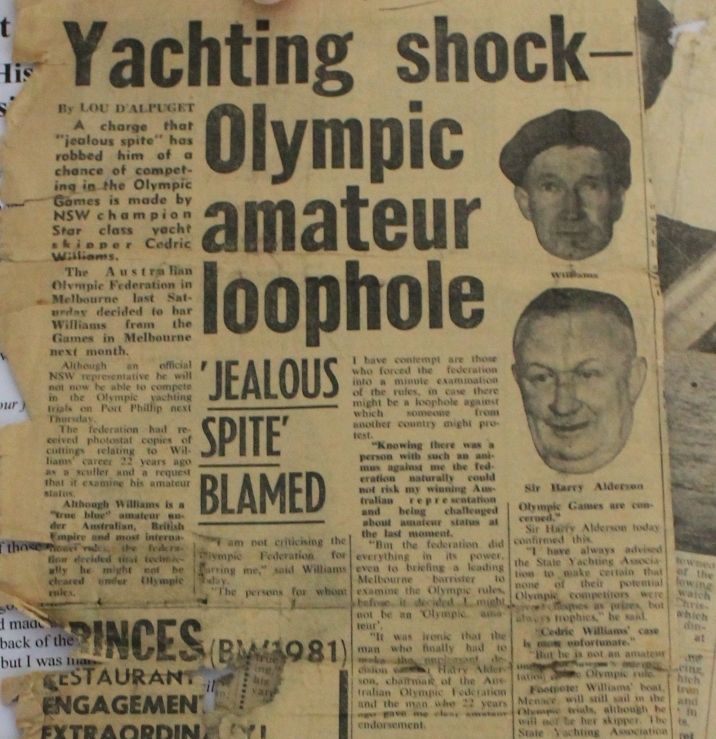
%20of%20Fox%20and%20Wilimas%20Family%20Pictures%20Elizabeths%20579.jpg?timestamp=1449972075261)
Australia did not win any gold medals in sailing at the 1956 Olympics - In the 5.5 Metre at the Games of the XVI Olympiad Jock Sturrock, Devereaux Mytton and Douglas Buxton secured Bronze, while Rolly Tasker and John Scott won silver in the 12m² Sharpie.
The 'Kathleen', sailed by Americans Herbert Williams and Lawrence Low, won the Gold in the Star class.
An article showing Cedric winning on home waters while the Olympics was going on, perhaps reflects that no amount of balderdash will fool the bulk of us:
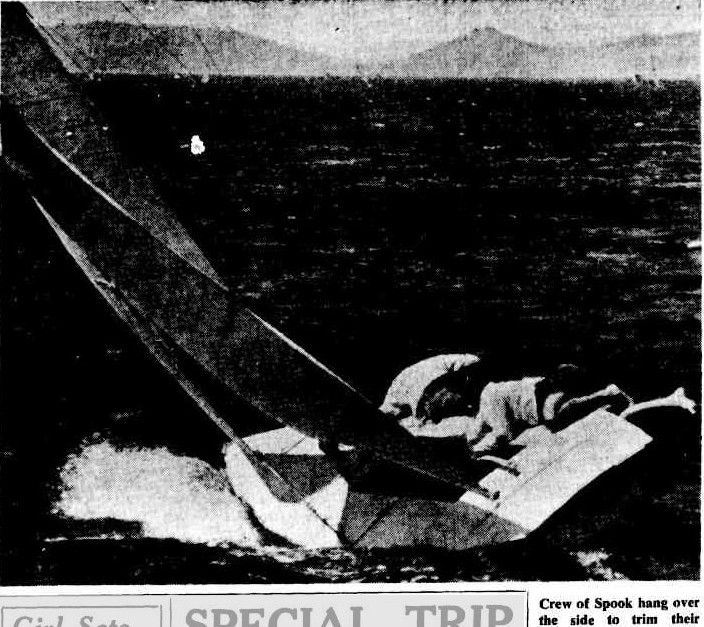
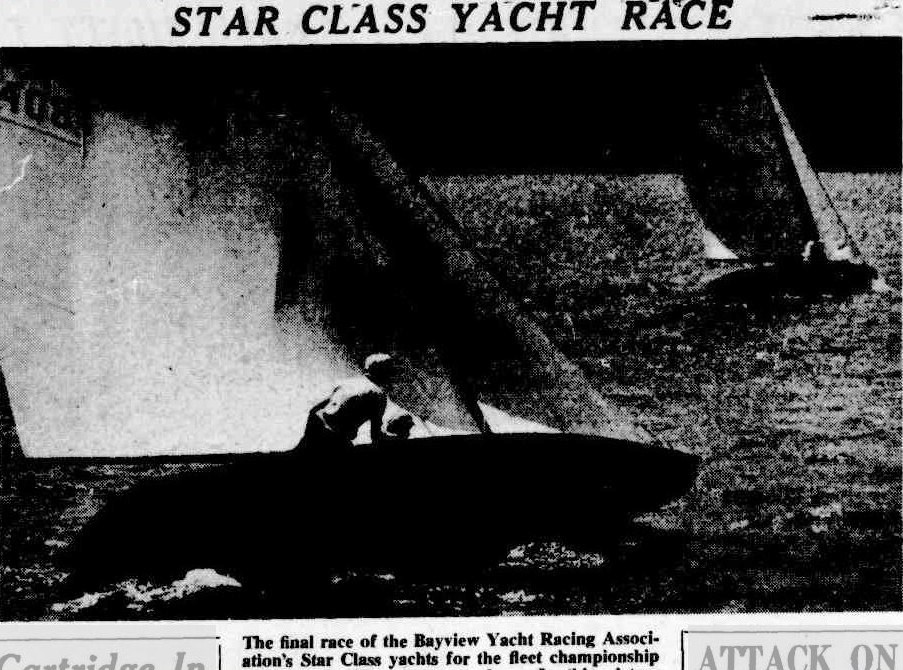
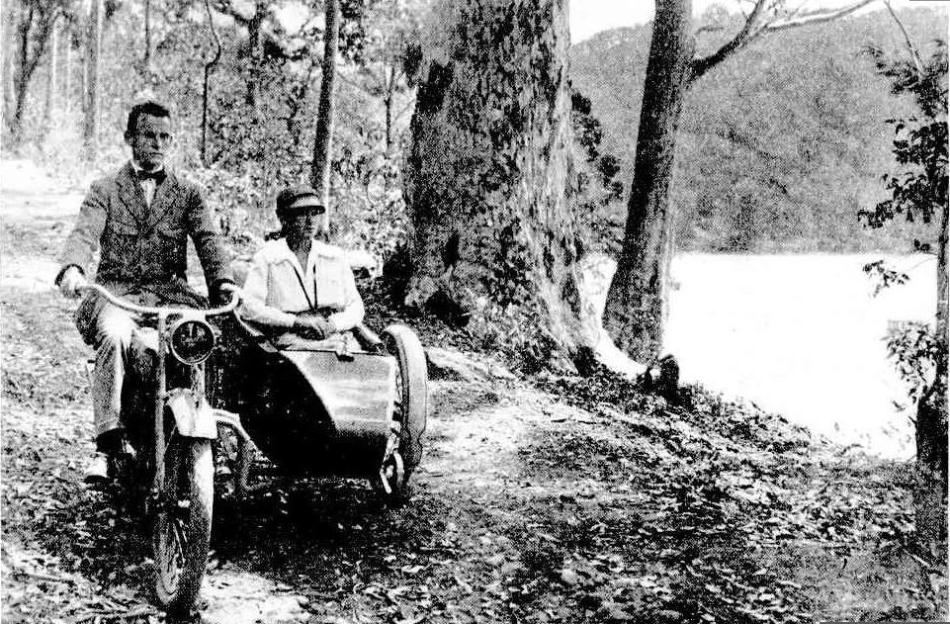
Above- the photo from this 1918 news item. History!
Along the foreshores of Broken Bay - 1918
The photograph was taken at Bayview , which overlooks lovely Pittwater, the southern part of Broken Bay* into which runs the beautiful Hawkesbury River . The whole of this locality is wonderfully rich in scenic charms. ALONG THE FORESHORES OF BROKEN BAY. (1918, January 23). Sydney Mail (NSW : 1912 - 1938), p. 5. Retrieved from http://nla.gov.au/nla.news-article159026429
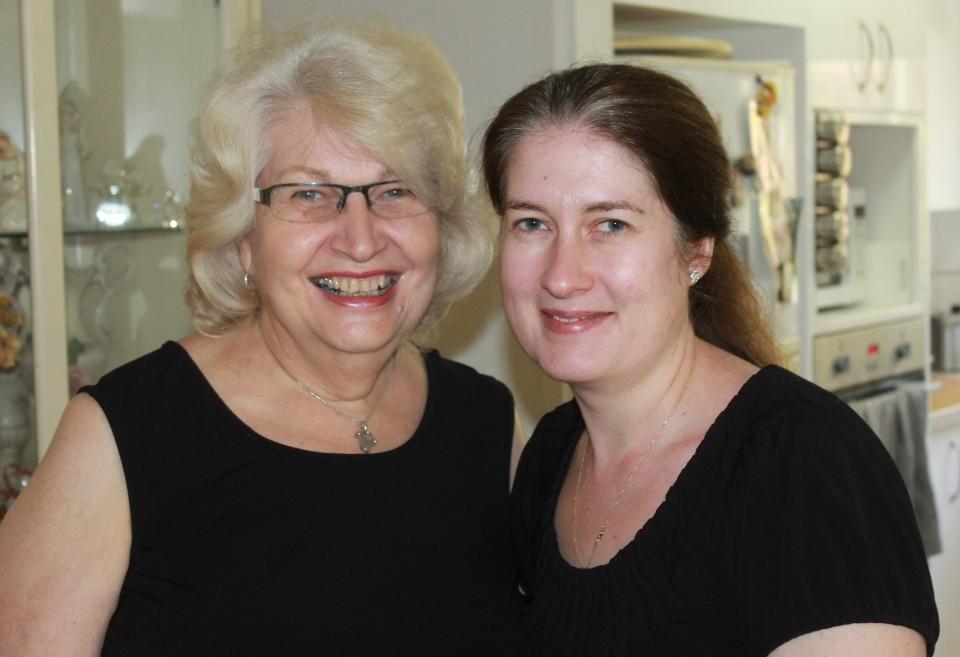
Our thanks to Elizabeth Hird (Nee Williams) and Her Daughter Dionne Challoner for their help and generosity in putting this small insight together - Dionne is working on a book, which will have the full story!
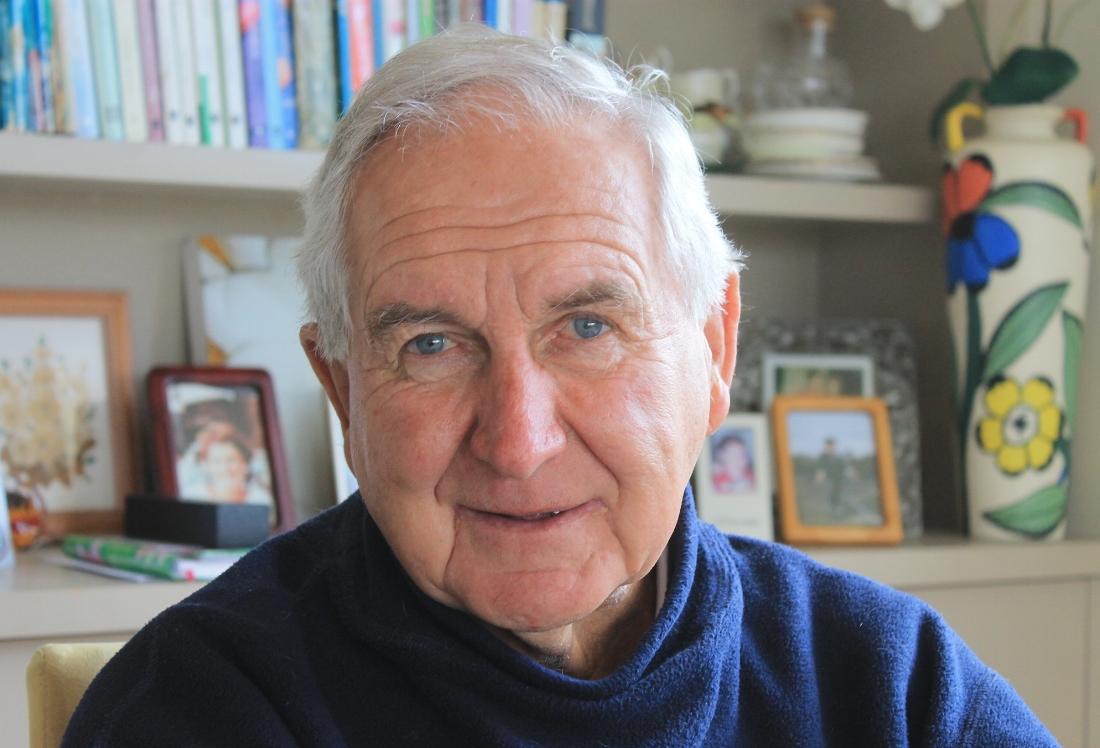
Cedric Vincent Williams
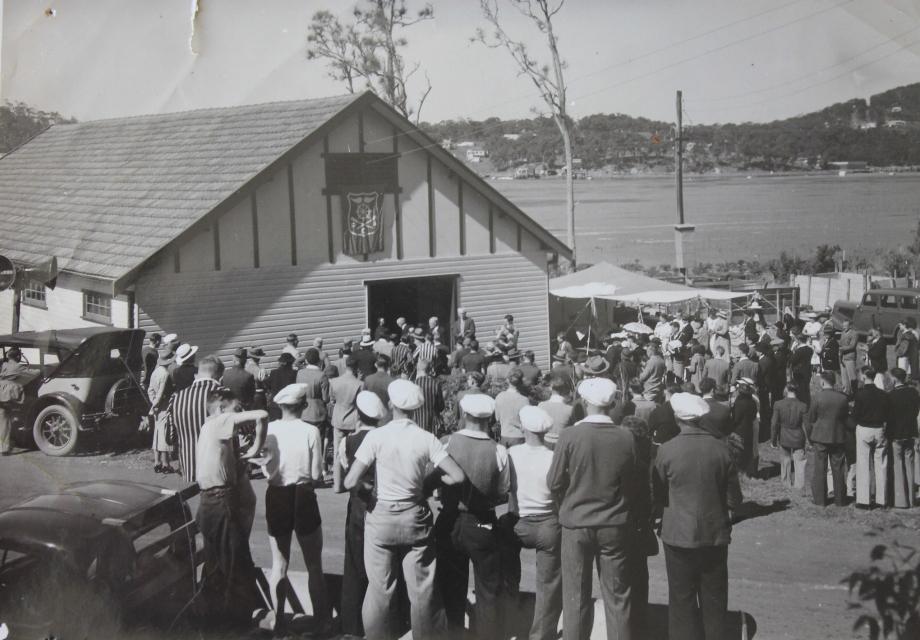
Pittwater Aquatic Club 1930's when opened (where Bayview Sea Scouts hall is now) - Cedric William's photo
Below: as this hall is today
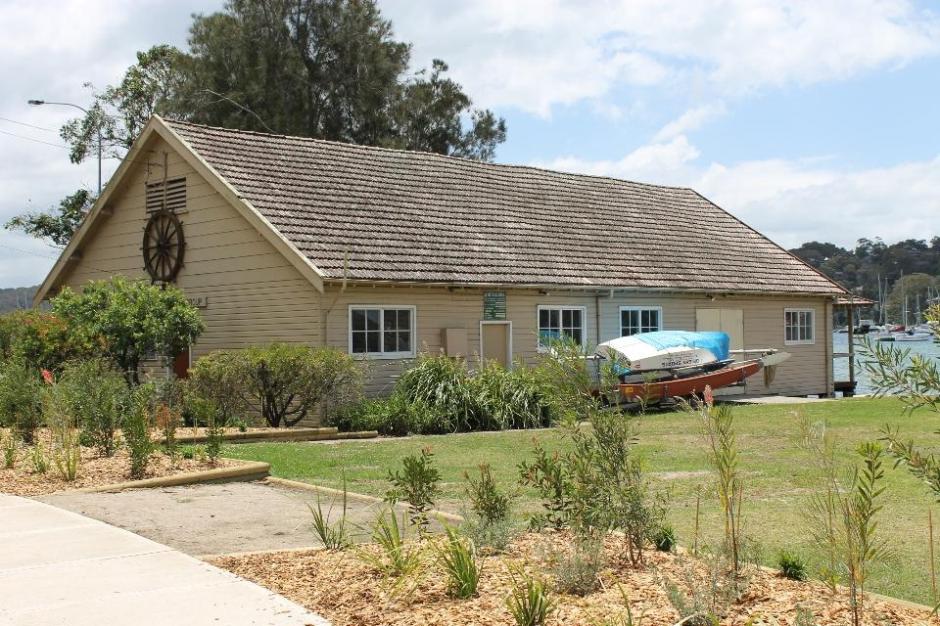
The John Williams Missionary Ships
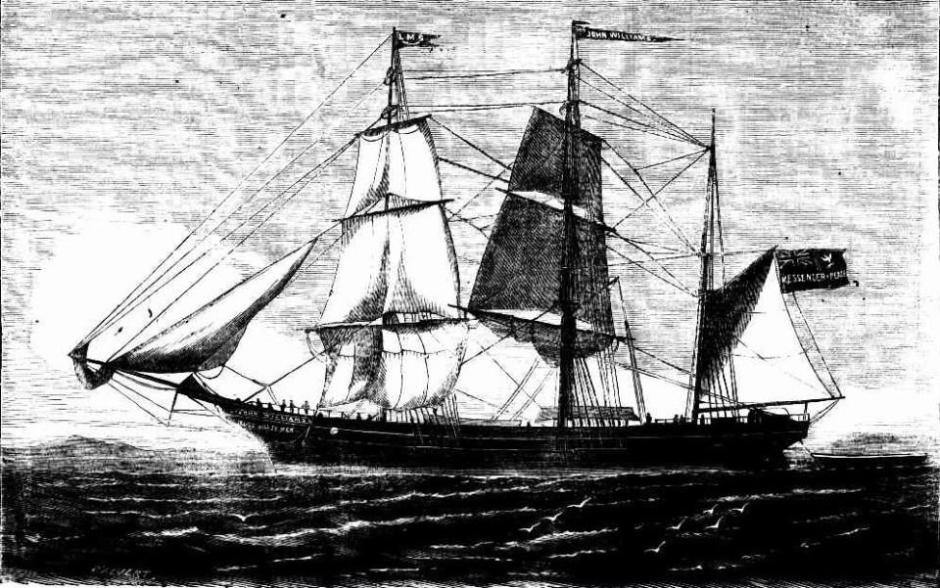
THE NEW MISSIONS SHIP JOHN WILLIAMS. '
MANY of our young friends will be pleased to bear that their vessel, the new mission barque, John Williams, has arrived in the colonies from England, and may shortly be expected in Sydney.' The new John Williams is a fine barque, of 296 tons, register, built by Hall and Co., of Aberdeen, the builders of some of the fastest vessels afloat. She is classed A1 for 14 years, and is as strong as wood and metal can make her. Accommodation for the missionaries is provided in a large poop, which extends; as far forward as the main rigging, comfortable quarters are also provided for the crew, and a large space available for freight, of which she brought two hundred tons from England." :
The John Williams arrived at Adelaide on the 4th of May, and Melbourne on the 19th,from thence proceeded to Geelong, and is now at Hobart Town. Sydney will be her next destination, and soon after her arrival she will be thrown open for the inspection of the Sabbath school children whose pennies has provided the London Missionary Society with a beautiful vessel, in every way fitted for the peaceful errand, on which she now proceeds for the first time, accompanied with many heartfelt Godspeeds. May she prove successful ; and for many years may this white-winged messenger of peace prove a blessing to the dusky inhabitants of Polynesia.
THE NEW MISSION SHIP JOHN WILLIAMS. THE NEW MISSIONS SHIP JOHN WILLIAMS. (1866, June 16).Illustrated Sydney News(NSW : 1853 - 1872), p. 13. Retrieved from http://nla.gov.au/nla.news-article63513003
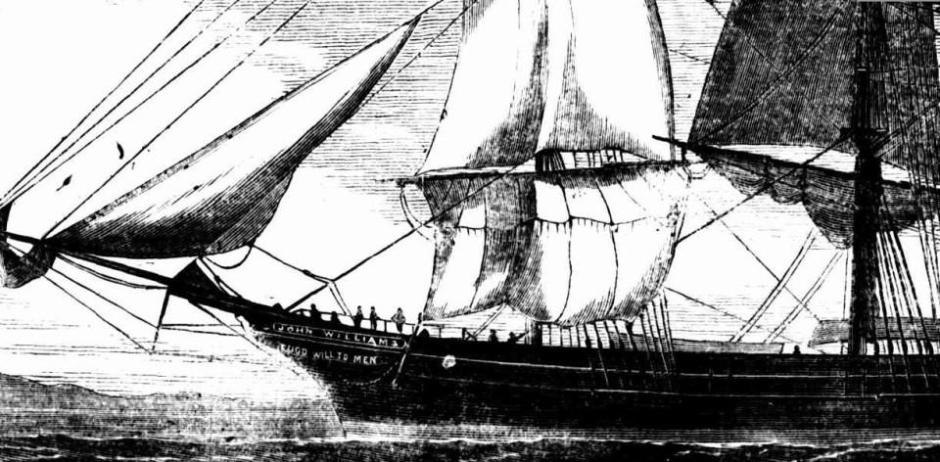
The John Williams Missionary Ships
Although the Williams family may not have started as seafaring people, they certainly took to this life as ducks, or swans, to water. John Williams the Martyr decided to buy a ship for use by the missionaries and to export goods which could then pay for books and other requirements for those they had gone to look after. The first ship was named 'Camden':
From New Caledonia (South Sea Island,) same day whence she sailed the 16th instant, the Missionary brig Camden, Captain Morgan, in ballast. Passengers, Mrs Williams, senior, and son, Mrs. Williams, junior, and daughter, Miss Barff, Miss Wilson, Mr. and Mrs. Murray, Mr. and Mrs. Appleton, Mrs. Morgan and daughter, with seven in the steerage. SHIPPING INTELLIGENCE. (1841, April 29). The Sydney Gazette and New South Wales Advertiser (NSW : 1803 - 1842), p. 2. Retrieved from http://nla.gov.au/nla.news-article2553182
The Camden was the third Mission Ship, and became one of many run by the London Missionary Society.
JOHN WILLIAMS BUYS a SCHOONER
The energetic zeal: and widespread philanthropy of John Williams stimulated him to seek a more extensive field of labour than that to be found on a comparatively small island (Raiatea), shared by three other missionaries. His sentiments on this subject were well expressed in his notable saying,' For- my part , I cannot content myself within the narrow limits of a single reef.' Animated with this feeling, when on a visit to Sydnoy in 1821, he purchased a Schooner for missionary service called The Endeavour which was after, yards renamed Te Matamua(the Pioneer). The Rev, Samuel Marsden of Parramatta undertook to share with him the responsibility should the directors of the society disapprove if the step he took. – The directors did not approve of the transaction and consequently the schooner had to be returned to Sydney and sold to refund Mr. Williams and Mr. Marsden.
Happy hours for children aboard mission ship - Spanking new John Williams VI bought with their pennies
By HELEN FRIZELL, staff reporter
SKIPPER of the mission ship, Captain fl Stanton Page, stands by the wheel.
CHIEF OFFICER Victor Ward, with a Gilbertese canoe, in his comfortable cabin.
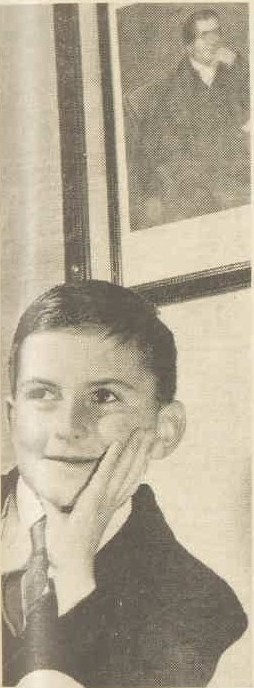 CEDRIC WILLIAMS, great-great great!-grandson of the original John Williams. There is a striking family likeness.
CEDRIC WILLIAMS, great-great great!-grandson of the original John Williams. There is a striking family likeness.
GOOD-HUMORED Samoan women, Harrietta and Jane, with children Feuyai and Viti. Harrietta and Jane spend spare time making beautiful straw bags and baskets.
John Williams VI, the London Missionary Society's spanking new ship, has a great attraction for Australian children, who take an almost proprietary interest init, as their pennies helped to pay for it.
World contributions to the cost of the ship, now on a goodwill tour of Australian ports, were £80,000,mostly in pennies. £10,000 came from Samoa.
WHEN the John Williams VI was in Sydney I went aboard. Crowds of parents and children were there before me, talking, put-ting pennies in a collection box, and making friends with Samoans, adults and children, who are returning home.
The collection box was draped with the London Missionary Society's flag, which is a white dove of peace on a purple ground.
Mr. Norman Cocks, secretary of the society in Australia, was in the centre of one group, and, as he left it to talk to me, he was asked by one of the boys: "Where's the captain?"
Mr. Cocks said he didn't know.
Every boy who goes over the ship wants to meet the captain, know his name, get his autograph, and go up to the bridge and turn the wheel.
So the captain, whose name is Stanton Page, takes refuge in sports coat and flannels, and remains incognito.
SAMOAN MISSIONARY, Pastor Jupeli. is going home after years of service. Small Samoan boys surround him, arid burst into laughter as the pastor tells them a funny story.
He was tracked down snatching a moment of quiet in the cabin be-longing to his chief officer, Victor Ward.
The comfortable cabins on the John Williams VI are painted pale green and white, and the bunks have blue-and-white bedspreads. Cabins have electric fans and sponge-rubber mattresses.
John Williams VI is painted blue and white, the brasswork glitters the funnel bears the distinctive white dove against the purple ground.
Captain Page told me about his 380-ton ship, which was named by Princess Margaret last year at Tower Pier, London "This is the first all-powered ship," he said. "The five others, all named John Williams, were auxiliaries.
"Our job in the islands-the Gilberts, Ellice, Samoa, the Cook Islands, and Papua-is to carry missionaries from one group to another, to take stores, medical supplies, to act as a school bus, taking children to boarding-school."
All six ships were named after the martyred missionary John Williams, who started life as a black-smith's apprentice and died in the New Hebrides. He built his sixty-foot schooner, Messenger of Peace, with his own hands. He split timber for it with wedges, got the iron from rusty cables, turned native mats into sails, and hibiscus fibre into ropes. He made wooden pegs for nails.
Present-day cargoes of the latest ship include such diversified items as cement for building (20 tons had just been loaded), books, children's slates, infants' feeding bottles.
Both Captain Page and Chief Officer Ward are married men with families. Captain Page, born in Somerset, England, says he is "a New Zealander by adoption." His wife is over there, and his eldest boy, John, is in the New Zealand Air Force. Then come Jennifer (15), Mary (8),and Stephen, aged four.
Chief Officer Victor Ward, a sun-tanned, blue-eyed man, added that his wife is in Suva, and that they have three children-Norman, who is 7, Anne, 5, and Vicky, the newest arrival.
"She'd be about three months, and about this long," he said, putting his hands about six inches apart, as he got stuck for words.
The ship has no doctor, and at sea, Captain Page told me, he treats the officers and crew if necessary. "So far," he said, "I've had nothing serious to cope with, so I use the old method, iodine outside, Epsom salts inside."
We then went for'ard to where the Samoan crew and passengers had their quarters to find the chaplain of the ship, Samoan Pastor Jupeli. He is the favorite of the little Samoan boys, who were playing around him. He is a tall man, well over six feet, built in proportion, with immense dignity. Everything about him is massive. His brown eyes twinkle with humor. When I saw him he was wearing a woollen weave "lava lava" and a lounge suit coat.
HE wore leather sandals with navy socks, and walked around with his retinue of children following literally in his steps. Pastor Jupeli, or Jubilee, has a fine reputation as a missionary schoolteacher in the Gilbert Islands. During the war he stayed there to look after his charges. Now he is going home to his native land, Samoa. At home are his wife, daughter, and grandchildren. In the Gilbert Islands the pastor taught young boy pupils the story of the Bible in their native language, and church history.
Samoans on board have been teaching at mission schools in Papua, and are returning to their homes. They were friendly to meet, and when they smiled revealed white, even teeth set in firm pink gums. Two women, Jane and Harrietta, sat cross-legged on a straw mat.
Most of the Samoans felt cold in Sydney, and will probably experience their coldest temperatures when the goodwill tour takes in Hobart and Launceston, and later Wellington, New Zealand.
The small Samoan boys seemed happily occupied eating oranges, and the grown-ups were enjoying themselves seeing the churches in Sydney, and spending hours at the Zoo, which they pronounced "Soo.*
Down on the wharf, looking up at the ship's graceful lines, was Mr. E. M. Saville, who is secretary of the Home for Incurables, Ryde.
"I should say I wouldn't miss out on seeing John Williams VI," he exclaimed. "I was born on John Williams IV. My mother was on the way down from Papua, where my father was a missionary.''
Great-great-great-grandson of the original John Williams, Cedric Williams, of Bayview, Sydney, was visiting the ship.
"Don't forget," said 11-year-old Cedric, "there are three greats 'before grandson."
Cedric and his young sister Elizabeth, not quite four, were entranced with the ship. Elizabeth was too young to climb up and down the perpendicular companion ways, but her brother had no qualms.
He's fond of ships, and of the sea. His father, Mr. S. R. Williams, is a boat-builder, also running true to family tradition.
Personnel of the John Williams VI are proud of the signed photo of Princess Margaret, which faces a rare print of the original John Williams. They feel that they are carrying on a tradition in the Pacific, just as the children who gave their pennies for the ship are carrying on a custom started 105 years ago. Skipper and chief-officer say that they get along well with the missionaries, who are "decent blokes." Four voyages are made in a year, touching even remote islands of groups named earlier. That the John Williams VI will carry out the duties of her predecessors is made clear by a neat plaque screwed into the wall of the saloon, which states she will "serve the Church of Christ in the South Seas." Happy hours for children aboard mission ship. (1949, April 9).The Australian Women's Weekly (1933 - 1982), p. 19. Retrieved from http://nla.gov.au/nla.news-article47222053
Re: "ELIZABETH WAS TOO YOUNG TO CLIMB UP" (In John Williams Missionary Ships) Elizabeth says she was not too young to climb up, but refused to climb up as she didn't want to.
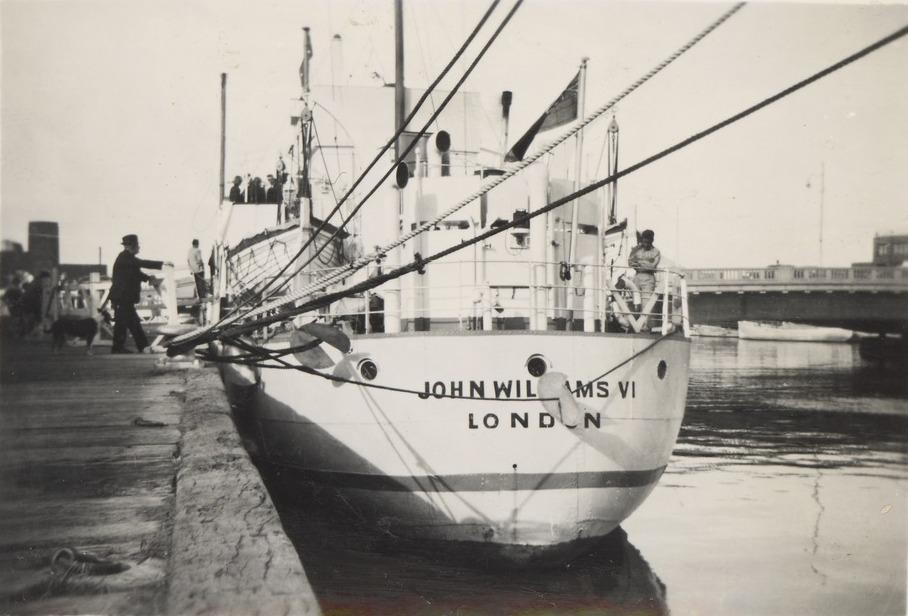
Above and Below: London Missionary Society's ship, "John Williams VI" - 1949 , courtesy State lIbrary of Victoria - Written on verso of H83.160/231: 'London Missionary Society's ship, visiting Melbourne on her maiden voyage, March 1949.'
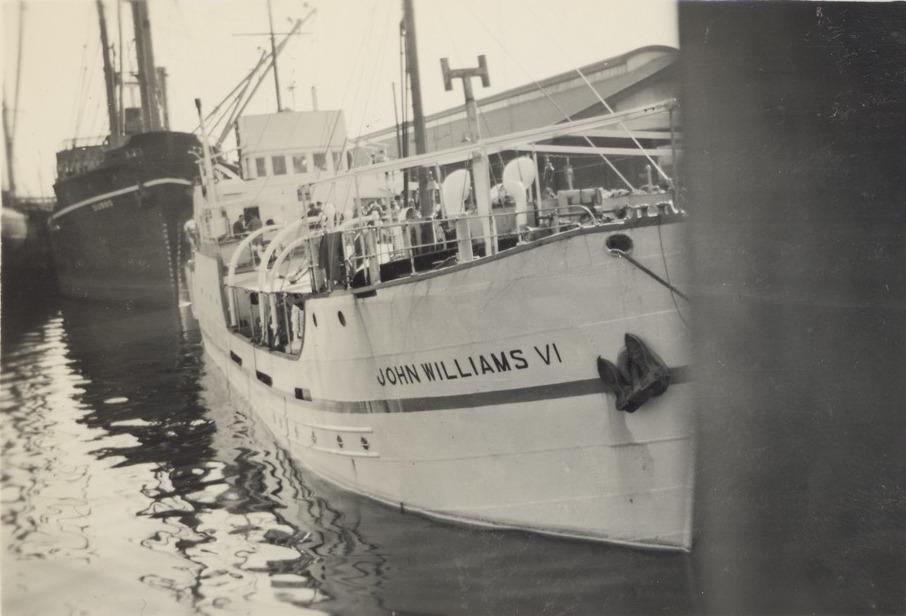
THE JOHN WILLIAMS. Interesting Medal Found.
(By SYDNEY W LUCAS.)
Recently discovered among rubbish during the renovations to an old home in a Sydney suburb, was a medal of pewter, struck to commemorate the building of the first John Williams at Harwich, in 1844 The face presents a beautifully modelled figure of the ship under full sail, and the words, 'John Williams missionary ship," near the edge, with a description lower down reading as follows "Launched at Harwich Mar 20, 1844, 296 tons, length 103 feet, breadth 24 feet 8 inches depth in hold16 feet, has 10 state rooms" The reverse states that "This ship, the property of the London Missionary Society, is intended to convey its missionaries to the islands of the South Pacific, and to be employed in visiting the different groups of islands in that ocean in promoting the gospel among them She has been purchased from a fund of upwards of £6200 raised by the juvenile friends of the society "
This was the third vessel engaged in missionary work in the South Seas, the first being The Messenger of Peace, built by the hands of John Williams and the second the ship Camden purchased by the London Missionary Society and sold after five years service
The directors of the society then appealed to the children of England to obtain the funds to purchase a new vessel, and by yearly collections, to keep her running, the suggestion met with an enthusiastic response resulting in the sum of £6237, instead of the £4000!
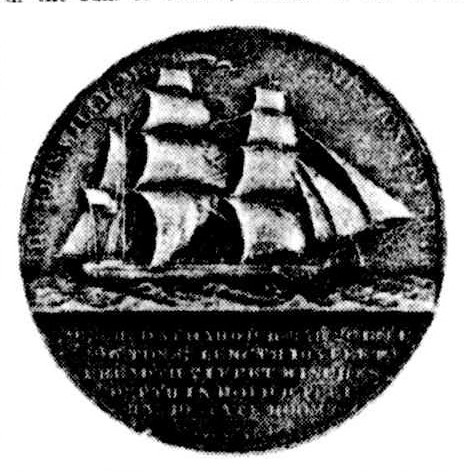
"John Williams" Medal, Struck March 20, 1844.
asked for With this sum a three-masted barque was built and equipped carrying as her figure-head the bust of John Williams. The medal was evidently struck to commemorate this wonderful effort, and was made by J Davis of Birmingham England
SAMOAN CHILDRENS RESPONSE
Having heard of the English children’s achievement the children of Samoa determined to provide canoes for the native teachers who were to evangelise the South Sea Islands and £400 was raised with which the canoes were purchased and stacked on the decks of the John Williams for later service. Her first commander was Captain Morgan followed by Captain Williams in 1856 in which year Captain Turpie joined the ship and served in her for eight years
On May 17 1864 after running for nineteen years and eleven months the John Williams was wrecked on Danger Island being driven ashore by the current in a calm, her boats trying to keen her off land m water too deep to afford anchorage There were 42 souls onboard all of whom were saved and were called for by the islanders Captain Turpie after sailing 400 miles in an open boat brought assistance from Samoa
The natives were converted by the ship wrecked missionaries and Mr. T C Williams the British Consul in the South Seas, .«truck by the change in theil character, and appreciating the kindness and hospitality they had shown the shipwrecked people sent a present of cotton goods valued at £50 sterling to be distributed among the natives in the names of Queen Victoria and the British Government
Eleven thousand pounds were raised for a second John Williams by the end of 1905, but this ship was wrecked on the reefs off Nieu within about a year This was followed by several other ships of the same name, not the least important being the steamer so well known to us who live around Sydney Harbour. THE JOHN WILLIAMS. (1934, March 17). The Sydney Morning Herald (NSW : 1842 - 1954), p. 11. Retrieved from http://nla.gov.au/nla.news-article17050593
A few Extras:
An idea of the extent of rowing events that became part of the Pittwater Regattas:
ROWING EVENTS
Conditions were not altogether favourable for rowing as the strong westerly wind although behind the competitors brought up a choppy sea, which made rowing in the lighter craft difficult and unpleasant The racing was somewhat marred by accidents as early In the day one of the ladies crew was run down by one of the racing yachts and a Sydney Club four was severely damaged. Mosman swamped just before reaching the line in the maiden fours and a Sydney crew in the same race broke an oar finishing In second position with three men rowing. The heavy boat races were keenly contested the following breeze being a great advantage to the scullers. The rowing officials were -Amateur races: Starters Messrs H G Alderson and A J Fills Judge Mr C Rosevear umpire Mr G Mackenzie and timekeeper Mr P C Daly Heavy boat races starters Messrs E H Higgs and W T Paddon timekeeper Mr A R Cooke umpire Mr W T Paddon judges Messrs L C B Williams O Lind and J Hartland Results -
AMATEUR EVENTS
Heavyweight Maiden Fours lm -Balmain AMcNeil!, lOst (bow) A Nix, 10 8 (2) E Crews list 21b (3) H Holt 11 2 (strottel 1 Sydney(No 2 crew) J Forsyth Iii (bov) J McKay list 2)b (21 W Brown 11 0 (3) T Neilly 12s»(stroke) E Dyson Smith (cox), O G Saleh(coach! 2 Mosman E C Tindale 11 12 (bow)N Kirby 12st 111b (2) E Bromley, 12st lill) (3)J Hurley list Bib (stroke) G Stevenson (cox)
S Raper (coach) 3 Mosman swamped near the finish and Sydney broke an oar Time 5m 38s
Lightweight Maiden Fours lm- Sydney (No 1)crewi a Myers 9-10 (bow) J Munro 9 13 12)A Newlands 9 13 (3) <"> N Rosevear 9 (stroke)J Hickson (cox) C Rosevear (coach) 1 Mosman E Howorth 9 10 (bow) M Middleton 9 12(2) E 8*orcy 9 10 (3) L Parry 0 8 (stroke) Q Stevenson (cox) S Raper (coach) 2 Only starters Sydney led over the whole course winning by three lengths Time 5m 34 1 Si
Senlor Fours: lm-Sydney (No 1) A Birren11 2 (bow) J A Goulding 11 4 (2) T Nlckson12 2 (3), S Downie 11 0 (stroke), J Nickson(cox) Ó Rosevear (coach) 1 Haberfield N Couper 11 (bow) T Tirth 11 4 (2). F Blg(,a12-4 (3), R Rees, 10 (stroke), O Ball (cox), 3 |
Hydnes (No 2) R H Bellamy 11-12 (bow) GR Wray 13 (2) J B Harkness 12 (3) H W Gilmour 10 (stroke), T Niçkson (cox) C Rosevear (coach) 3 Sydney (No 1) and Haberfield made a good race over three quarters of the course when Sydney forged ahead and won by four lengths Time 5m 24s
LADIES EVENTS
Lightweight Four oar Championship of Pittwater 1/2m-Sydney (No 2 new) B Fox (bow) M Royston (2) M Watt (3) F Cross (stroke) 1Sydney (No 1 crew) W Mcfarlane (bow) G McGoogah (2) J Matthews (3) B Gunner (stroke) 2 Sydney (No 3 crew) M Gay (bow) M Garmer (2) M Harmstoff (3) I Levy (stroko) 3 Won by half a length four lengths separating second and third Time 4m
Heavyweight Four oar Championship of Pittwater. 1 ni-Sydney (No 1 crew) A Mann (bow) I Pike (21 F Thurston 13) R C Goodman(Stroke) C Rosevear (coach) 1 YWCA T Riley (bow) J Thackeray (2), N Andrews (3) J Thackeray (stroke) W Howell (coach), 2 Sydney (No 2 crew) P Liston (bow) L Fisher (2) I Smith (3) N Henderson (stroke) 3 Sydney(No 1) took the lead from the start and won by three lengths Time 3m 50s
HEAVY BOAT EVENTS
Boys Single Sculls Handicap ½ m (under 8 years) - Walter Hibbs scr 1 Charles Byrnes 4s 2 Won by a length. The W T Paddon Gladstone Skiff Handicap for Men 1m -First heat B Paddon, 25s 1 C. B. Williams 3s 2 C I. Holding 20s 3 P Erickson also startedWon by two lengths a length separating second and third. Second heat J Erickson scr 1, M Price 35s2 C R Erickson 10s 3 Other starter H Price Won by a length and a quarter. Final J Erickson 1 C B Williams and M Price dead heat for second place
A R Cooke Double Sculls (all comers handicap for men)-Walter Hibbs and R Robinson 16s. 1 H Price and Jack Erickson scr 2 H and E Erickson 5s 3 Other starters R and S Straney 16s G and A Straney 13s B Paddon and William Hibbs 12s Won by two lengths, one length between second and third. The E H Higgs Single Sculls Handicap (men) -H Erickson 7s 1 J Erickson scr 2 R Stranev 14s 3 Other starters B Paddon 1rs H Price 14s A Straney 12s G C Straney 10s William Hibbs Bs C R Erickson, 2s Won by half a length three feet separating second and third. PITTWATER. (1929, December 30). The Sydney Morning Herald (NSW : 1842 - 1954), p. 6. Retrieved fromhttp://nla.gov.au/nla.news-article16614023
Early Pittwater Paddlers, Oarsmen, Rowers and Scullers: The Williams Family of South Sea Islands, Mosman and Bayview - threads collected and collated by A J Guesdon, 2015.
Previous History Pages:
Marie Byles Lucy Gullett Kookoomgiligai Frank Hurley Archpriest JJ Therry Sir Patrick Gordon Taylor Bowen Bungaree W. Bradley 1788 Journal Midholme Loggan Rock Cabin La Corniche La Corniche II Lion Island Bungan Beach Botham Beach Scarred Trees Castles in the Sand Dame Nellie Melba lunches at Bilgola Spring, 1914 First to Fly in Australia at North Narrabeen Mona Vale Golf Club's Annual Balls Governor Phillip camps on Resolute Beach Ruth Bedford Jean Curlewis Mollie Horseman Charlotte Boutin May Moore Neville W Cayley Leon Houreux Frederick Wymark Sir Adrian Curlewis Bilgola Heron Cove Mullet Creek Shark Point Woodley's Cottage A Tent at The Basin Collin's Retreat-Bay View House-Scott's Hotel Bilgola Cottage and House The First Pittwater Regatta Women Cricketers Picnic Filmed In Pittwater Governor Phillip's Barrenjoey Cairn Waradiel Season The Church at Church Point Governor Phillip's Exploration of Broken Bay, 2 â 9 March 1788 Petroglyths: Aboriginal Rock Art on the Northern Beaches Avalon Headland Landmarks Steamers Part I Pittwater Aquatic Club Part I Woody Point Yacht Club Royal Motor Yacht Club Part I Dorothea Mackellar Elaine Haxton Neva Carr Glynn Margaret Mulvey Jean Mary Daly Walter Oswald Watt Wilfrid Kingsford Smith John William Cherry George Scotty Allan McCarrs Creek Narrabeen Creek Careel Creek Currawong Beach Creek Bushrangers at Pittwater Smuggling at Broken Bay An Illicit Still at McCarr's Creek The Murder of David Foley Mona Vale Outrages Avalon Camping Ground Bayview Koala Sanctuary Ingleside Powder Works Palm Beach Golf Course Avalon Sailing Club Mona Vale Surf Life Saving Club Palm Beach SLSC Part I - The Sheds Warriewood SLSC Whale Beach SLSC Flagstaff Hill Mount Loftus Pill Hill Sheep Station Hill S.S. Florrie S.S. Phoenix and General Gordon Paddlewheeler MV Reliance The Elvina Florida House Careel House Ocean House and Billabong Melrose-The Green Frog The Small Yacht Cruising Club of Pittwater Canoe and I Go With The Mosquito Fleet - 1896 Pittwater Regattas Part I - Dates and Flagships to 1950 Shark Incidents In Pittwater The Kalori Church Point Wharf Bayview Wharf Newport Wharf Palm Beach Jetty - Gow's Wharf Max Watt Sir Francis Anderson Mark Foy John Roche Albert Verrills Broken Bay Customs Station At Barrenjoey Broken Bay Water Police Broken Bay Marine Rescue - Volunteer Coastal Patrol Pittwater Fire-Boats Prospector Powder Hulk at Towler's Bay Naval Visits to Pittwater 1788-1952 Pittwater's Torpedo Wharf and Range Naval Sea Cadets in Pittwater S.S. Charlotte Fenwick S.S. Erringhi P.S. Namoi S.Y. Ena I, II and III Barrenjoey Headland - The Lessees Barrenjoey Lighthouse - The Construction Barrenjoey Broken Bay Shipwrecks Up To 1900 Barrenjoey Light Keepers Douglas Adrian Ross Newport SLSC 1909 - 1938 Part I Overview North Narrabeen SLSC - The Formative Years Bilgola SLSC - the First 10 years North Palm Beach SLSC A History of Pittwater Parts 1 and 4 Pittwater Regattas - 1907 and 1908 Pittwater Regattas - 1921 - The Year that Opened and Closed with a Regatta on Pittwater Pittwater Regatta Banishes Depression - 1933 The 1937 Pittwater Regatta - A Fashionable Affair Careel Bay Jetty-Wharf-Boatshed Gow-Gonsalves Boatshed -Snapperman Beach Camping at Narrabeen - A Trickle then a Flood Pittwater's Parallel Estuary - The Cowan 'Creek' RMYC Broken Bay Boathouse and Boatshed Barrenjoey Boat House The Bona - Classic Wooden Racing Yacht Mona Vale Hospital Golden Jubilee - A Few Insights on 50 Years as a Community Hospital Far West Children's Health Scheme - the Formation Years The First Scotland Island Cup, Trophy and Race and the Gentleman who loved Elvina Bay Royal Motor Yacht Club Broken Bay NSW - Cruiser Division History - A History of the oldest division in the Royal Motor Yacht Club Royal Motor Yacht Club Broken Bay Early Motor Boats and Yachts, their Builders and Ocean Races to Broken Bay, the Hawkesbury and Pittwater The Mail Route to Pittwater and Beyond The Wild Coachmen of Pittwater - A Long and Sometimes Bumpy Ride on Tracks Instead of Roads The Fearless Men of Palm Beach SLSC's Surf Boats First Crews - A Tale of Viking Ships, Butcher Boats and Robert Gow's Tom Thumb 'Canoe' Furlough House Narrabeen - Restful Sea Breezes For Children and Their Mothers From Telegraphs to Telephones - For All Ships at Sea and Those On Land Mona Vale Training Grounds - From Lancers on Horses to Lasses on Transport Courses Fred Verrills; Builder of Bridges and Roads within Australia during WWII, Builder of Palm Beach Afterwards Communications with Pittwater Ferries To Pittwater A History of Pittwater - Part 4: West Head Fortress Pittwater's Lone Rangers - 120 Years of Ku-Ring-Gai Chase and the Men of Flowers Inspired by Eccleston Du Faur Early Pittwater Launches and Ferries Runs Avalon Beach SLSC - The First Clubhouse Avalon Beach SLSC The Second and Third Clubhouses From Beneath the Floorboards at Hyde Park Barracks Bungaree Was Flamboyant Andrew Thompson - 'Long Harry' Albert Thomas Black John Collins of Avalon Narrabeen Prawning Times - A Seasonal Tide of Returnings Oystering in the Pittwater Estuary - Oyster Kings and Pearl Kings and When Not to Harvest Oysters Yabbying In Warriewood Creeks Eeling in Warriewood's Creeks (Includes A Short History of community involvement in favour of environmental issues/campaigns in and around Narrabeen Lagoon - 1974 to present by David James OAM) Eunice Minnie Stelzer - Pittwater Matriarchs Maria Louisa Therry - Pittwater Matriarchs Katherine Mary Roche - Pittwater Matriarchs Sarah A. Biddy Lewis and Martha Catherine Bens Pittwater Matriarchs Pittwater's New Cycle Track of 1901 Manly to Newport The Rock Lily Hotel Barrenjoey House The Pasadena Jonah's St Michael's Arch The First Royal Visitor to Australia: the Incident at Clontarf March 12th, 1868 Pittwater: Lovely Arm of the Hawkesbury By NOEL GRIFFITHS - includes RMYC Wharf and Clareville Wharf of 1938 + An Insight into Public Relations in Australia George Mulhall First Champion of Australia in Rowing - First Light-Keeper at Barranjuey Headland Captain Francis Hixson - Superintendent of Pilots, Lights, and Harbours and Father of the Naval Brigade The Marquise of Scotland Island The First Boat Builders of Pittwater I: the Short Life and Long Voyages of Scotland Island Schooner the Geordy Boat Builders of Pittwater II: from cargo schooners and coasters to sailing skiffs and motorised launches The Currawong: Classic Yacht The Riddles of The Spit and Bayview/Church Point: sailors, boat makers, road pavers and winning rowers VP Day Commemorative Service 2015 – at Avalon Beach RSL Cenotaph: 70th Anniversary Captain T. Watson and his Captain Cook Statues: A Tribute to Kindness Pittwater Reserves: The Green Ways; Hordern or Wiltshire Parks to McKay Reserve – From Beach to Estuary Pittwater Reserves, The Green Ways: Clareville Wharf and Taylor's Point Jetty Pittwater Reserves: The Green Ways Bilgola Beach - The Cabbage Tree Gardens and Camping Grounds - Includes Bilgola - The Story Of A Politician, A Pilot and An Epicure by Tony Dawson and Anne Spencer Pittwater Reserves - The Green Ways: Mona Vale's Village Greens a Map of the Historic Crown Lands Ethos Realised in The Village, Kitchener and Beeby Parks Pittwater Reserves: The Green Ways; Bungan Beach and Bungan Head Reserves: A Headland Garden Early Pittwater Paddlers, Oarsmen, Rowers and Scullers: The Green Family Elanora - Some Early Notes and Pictures